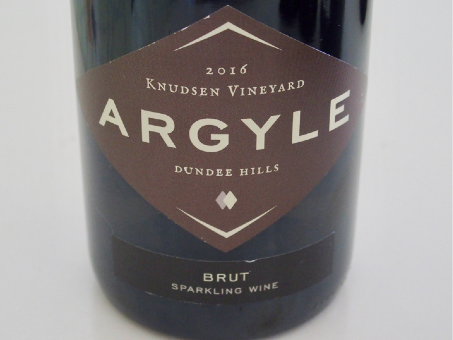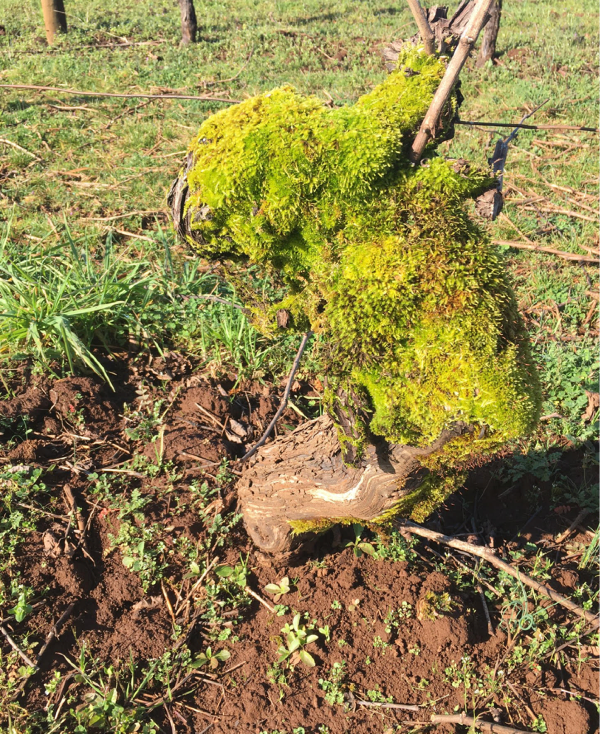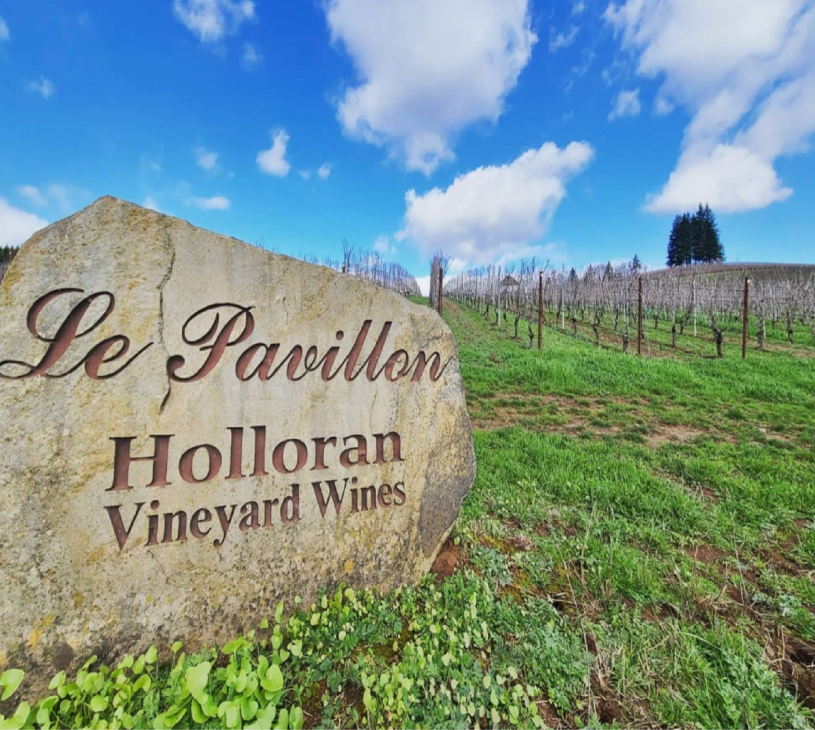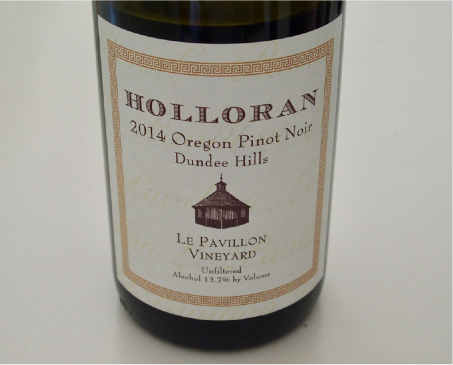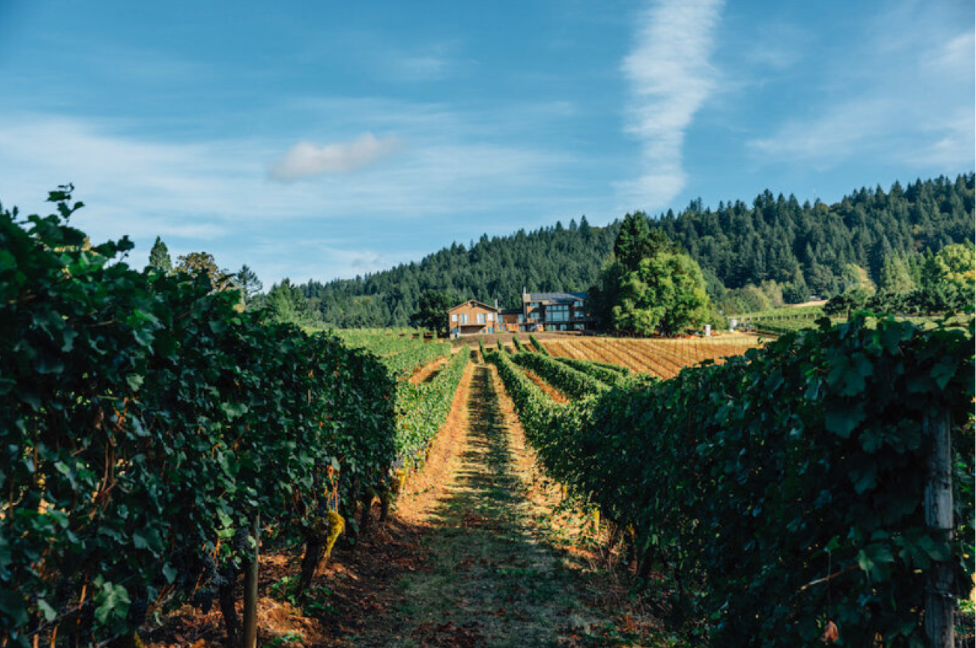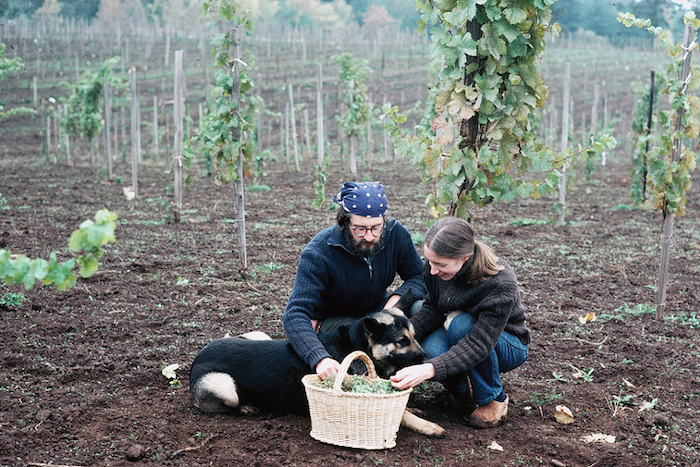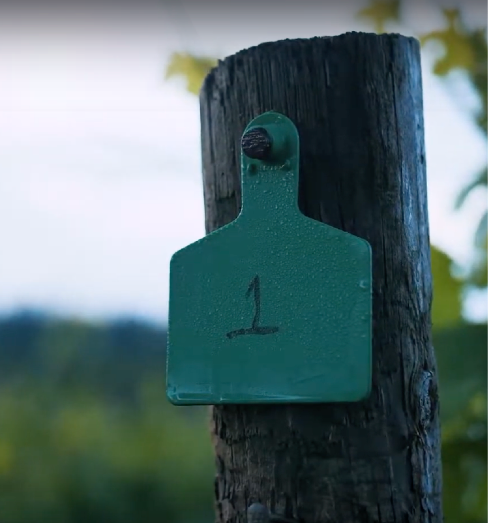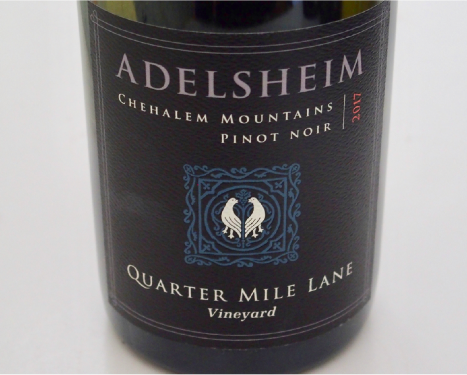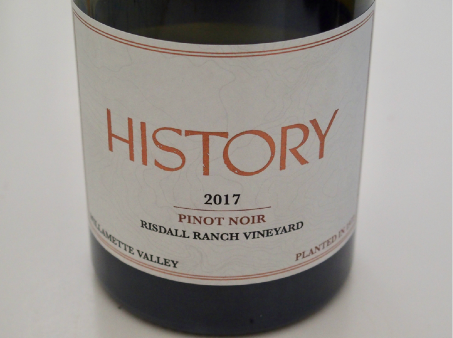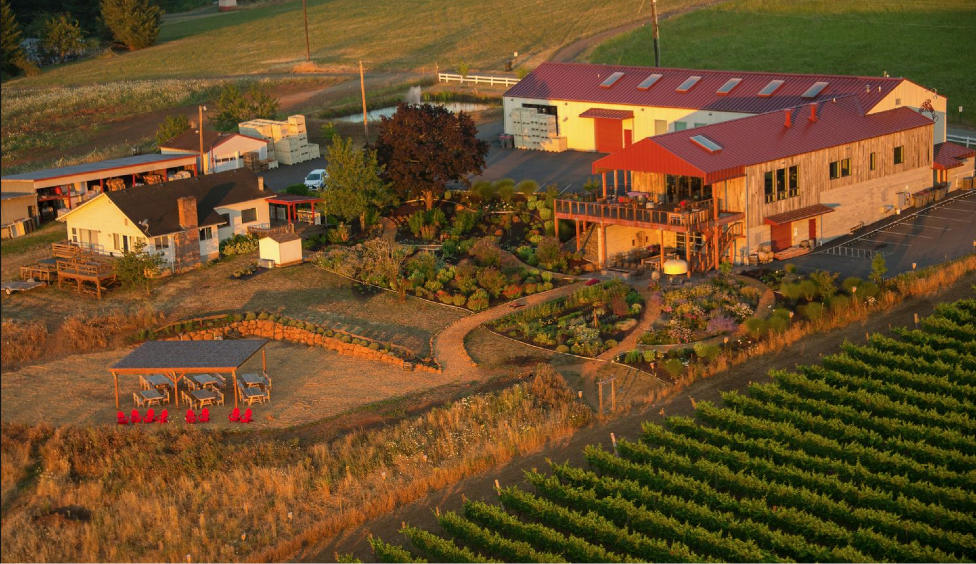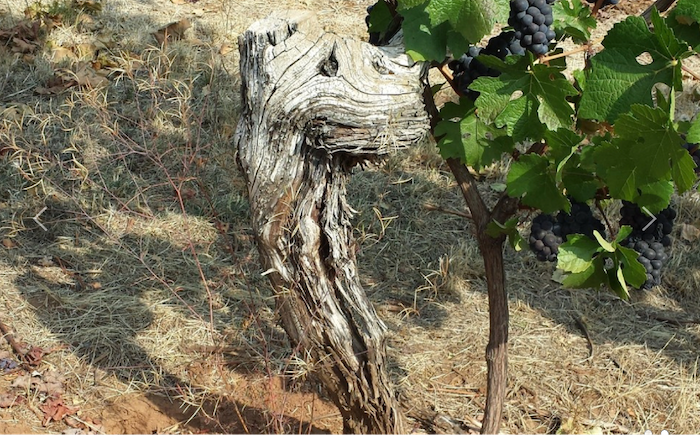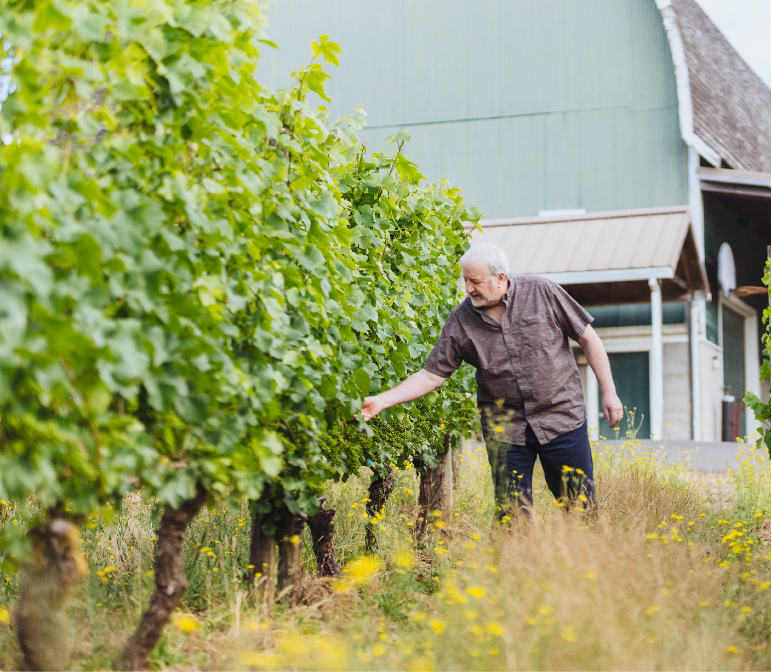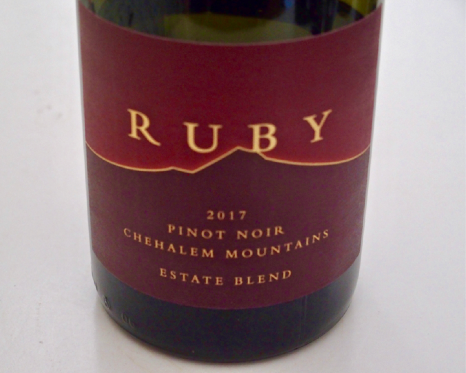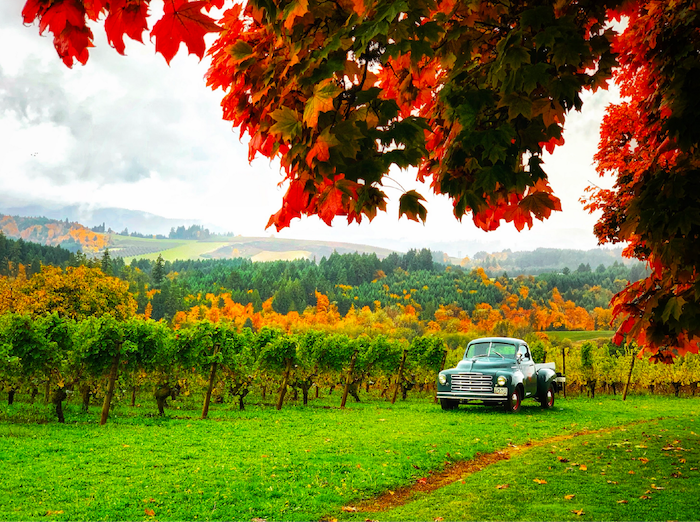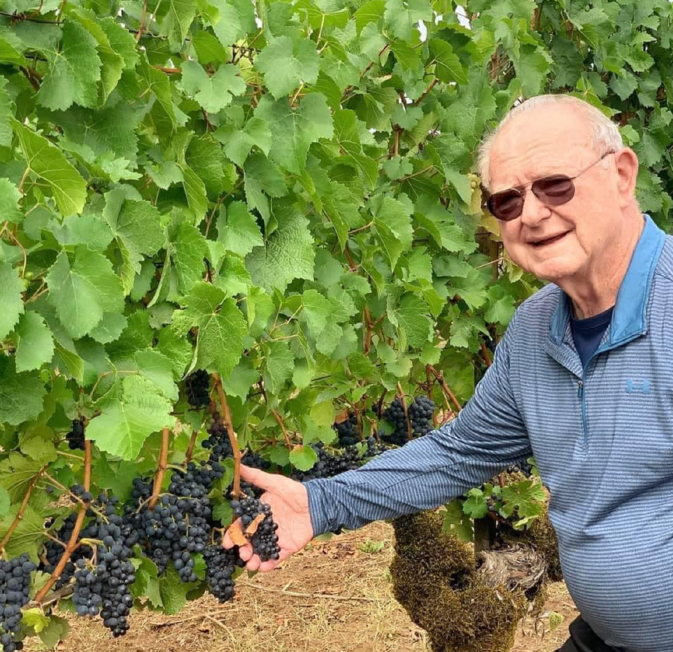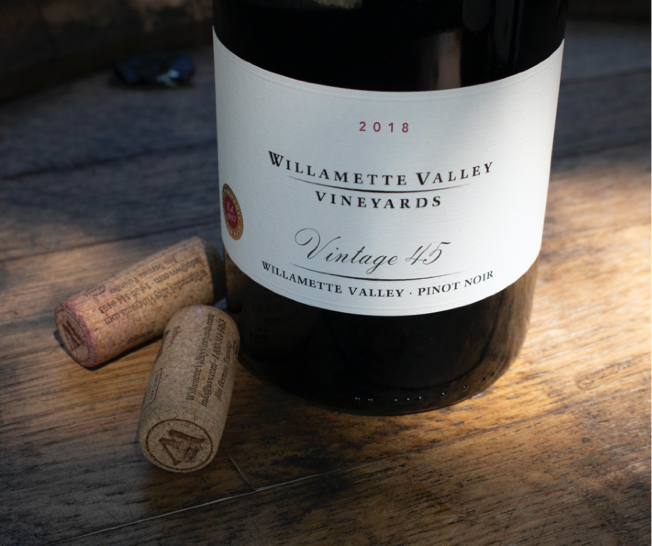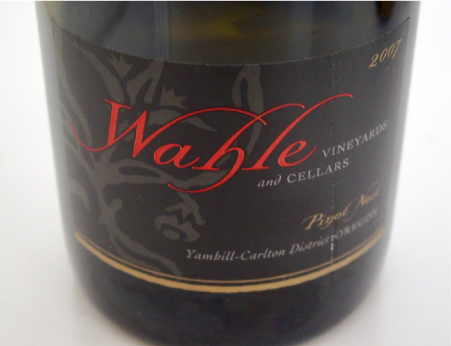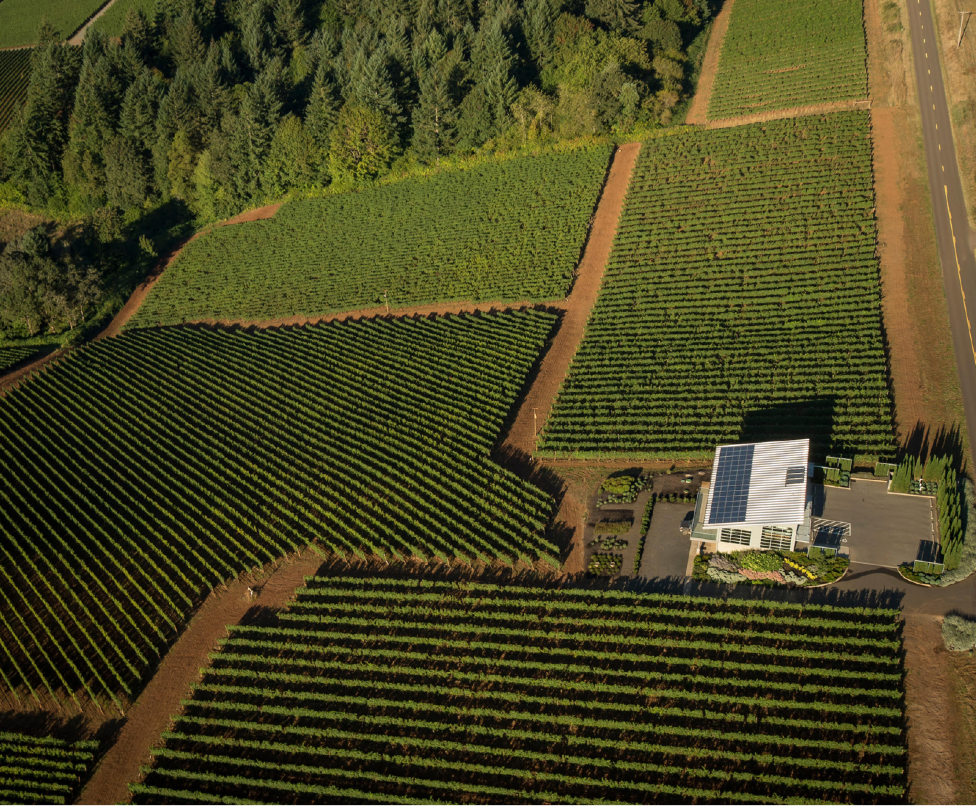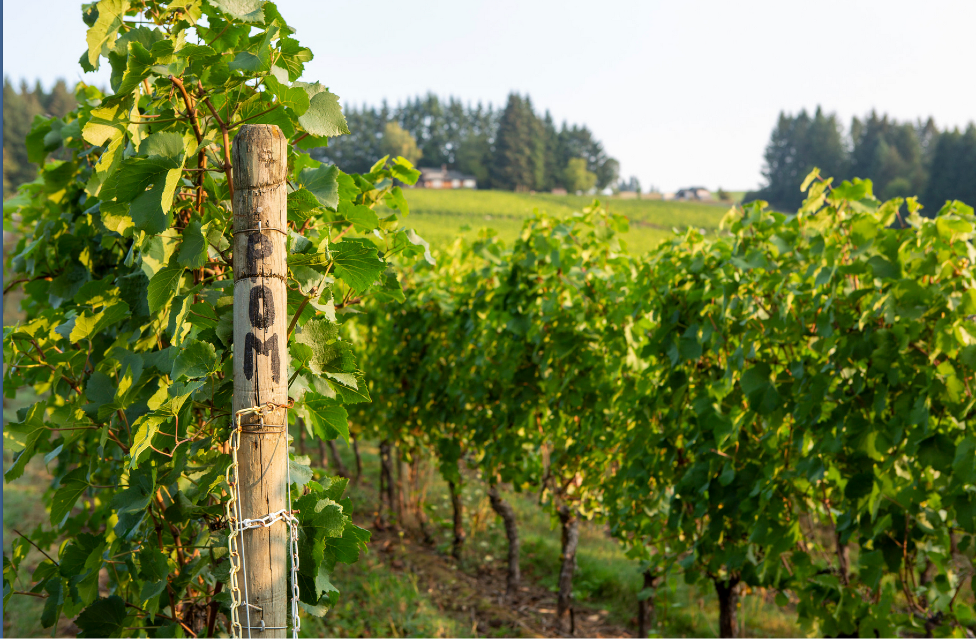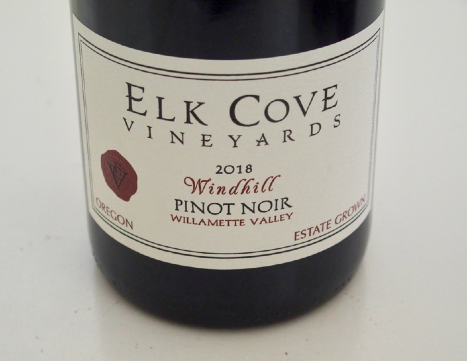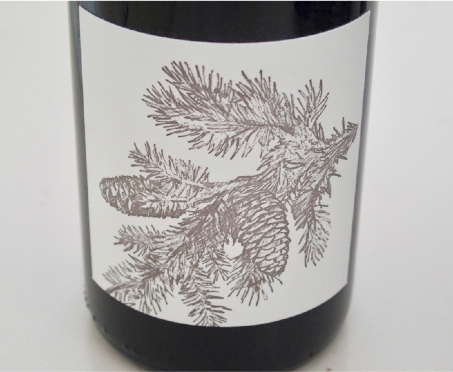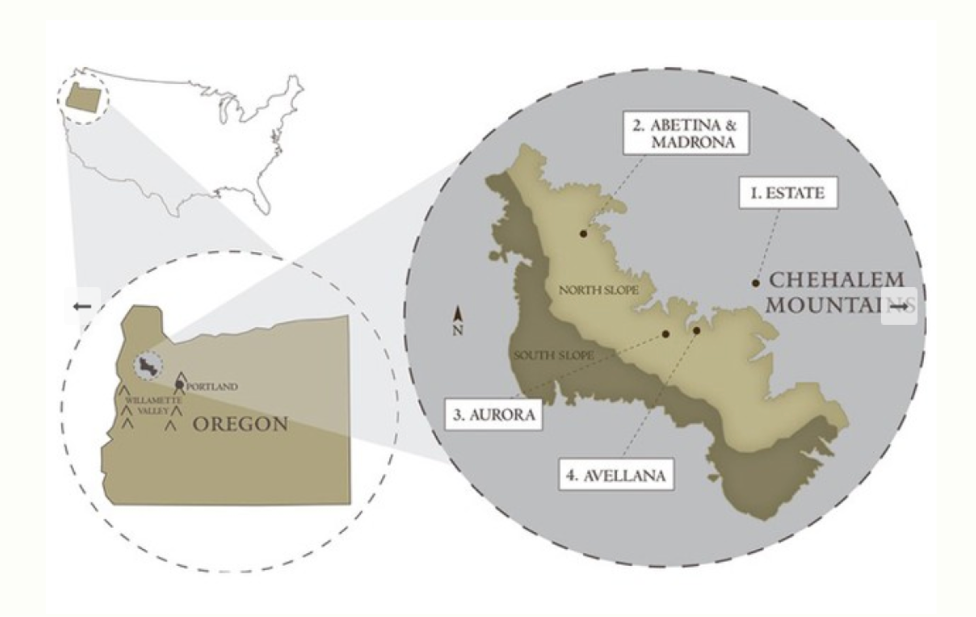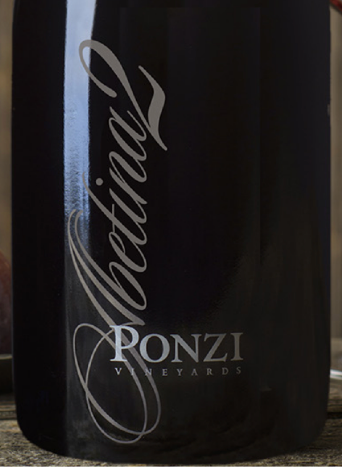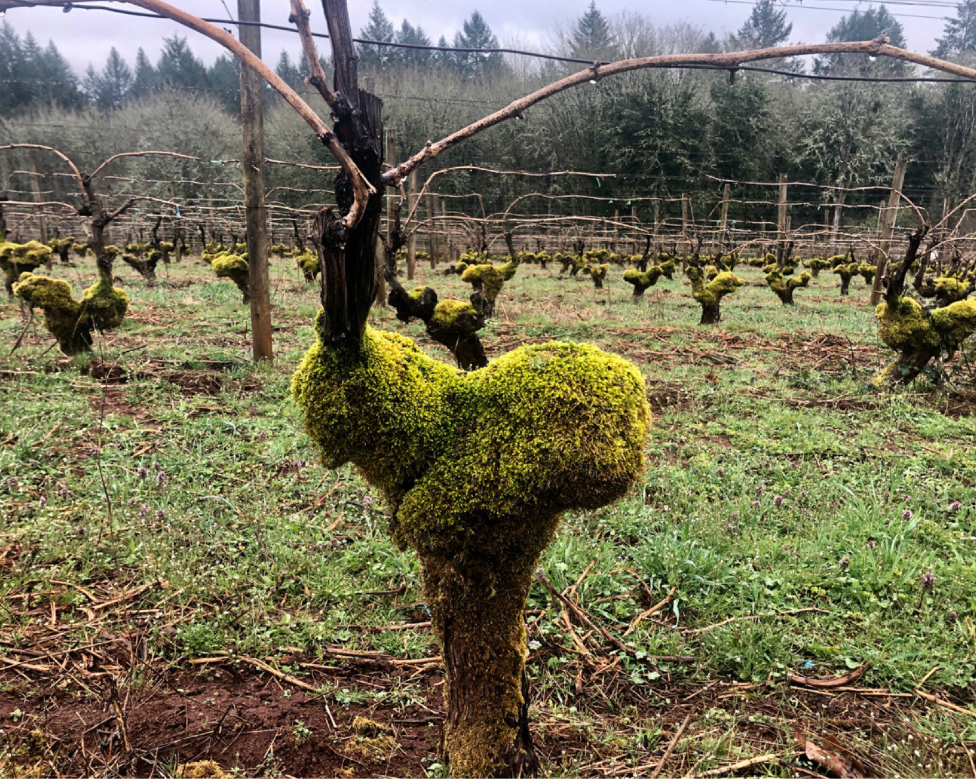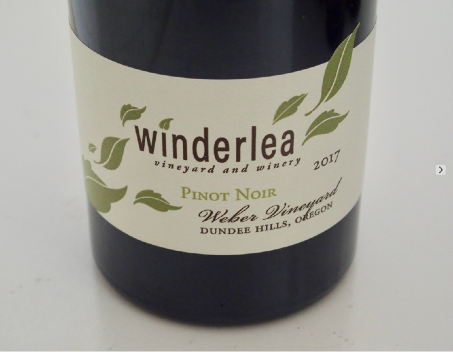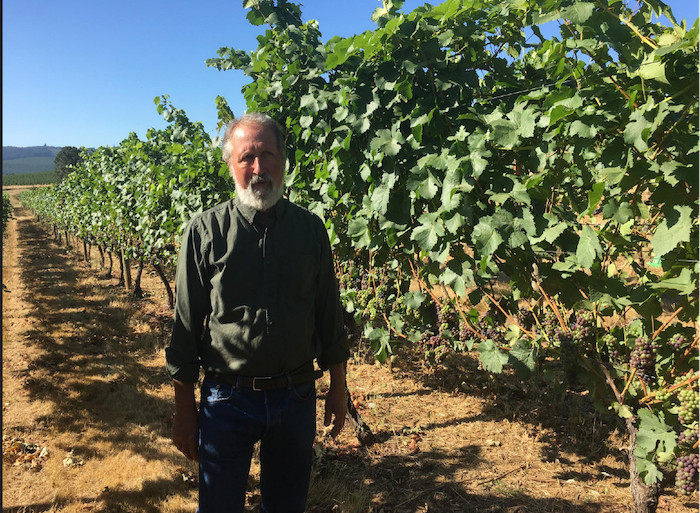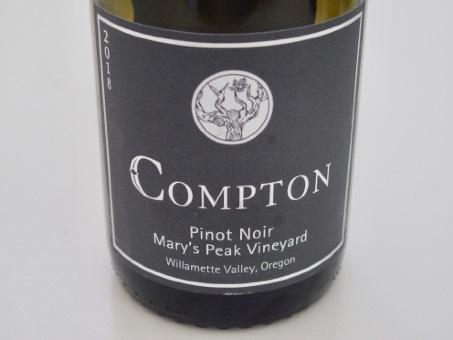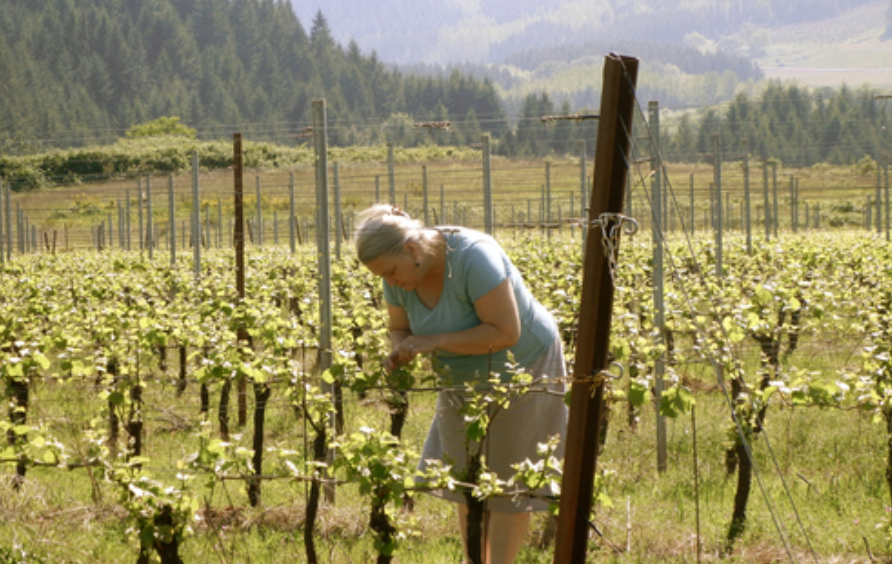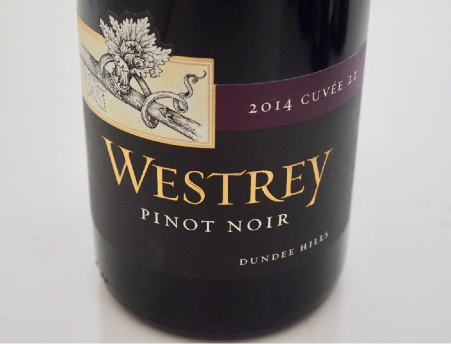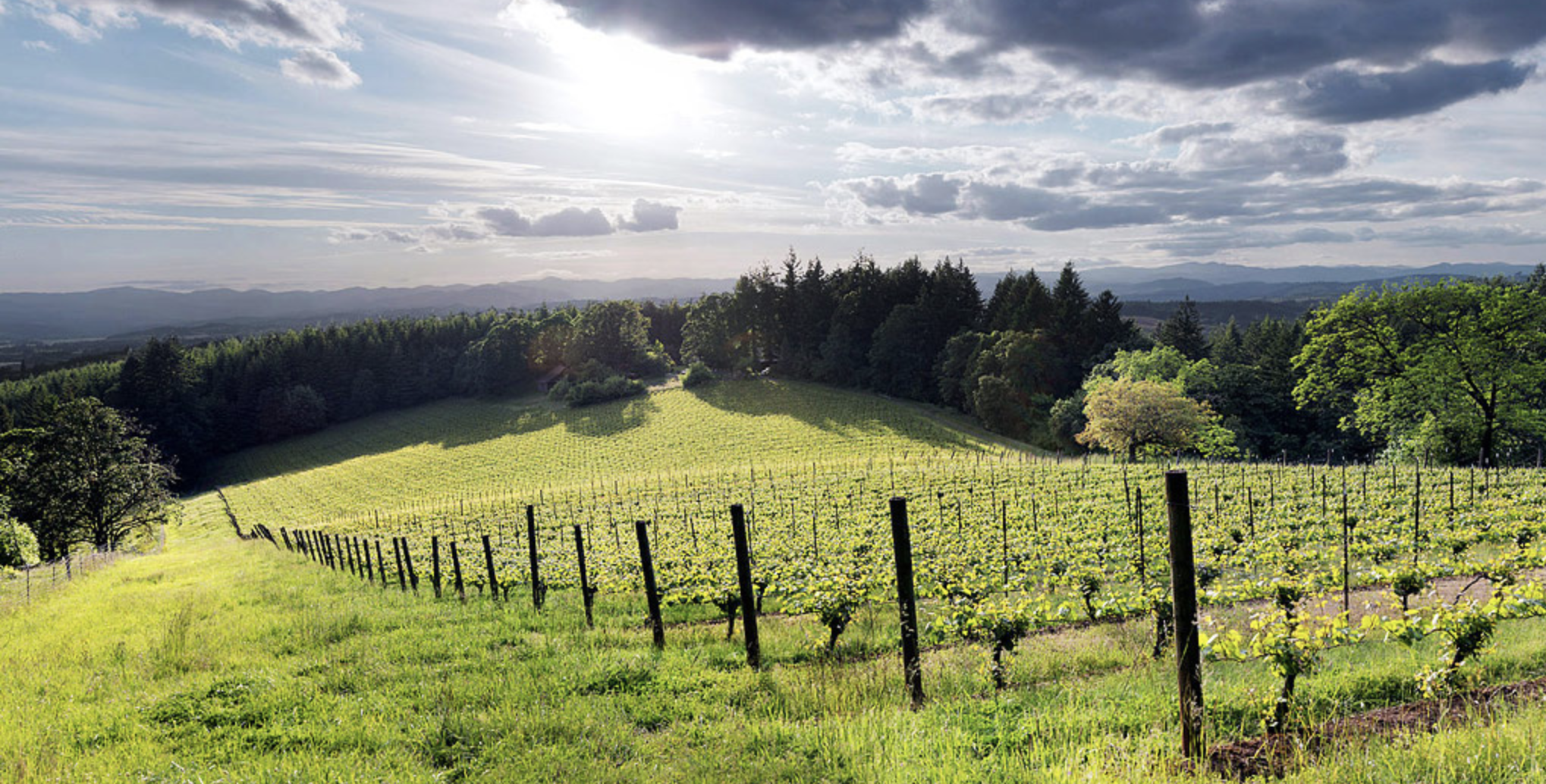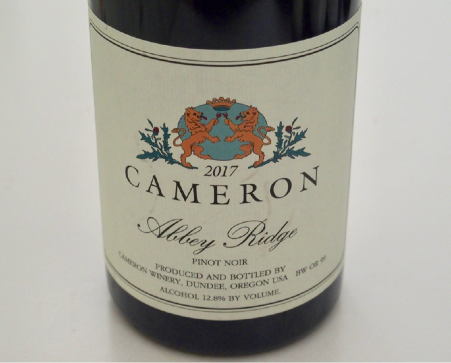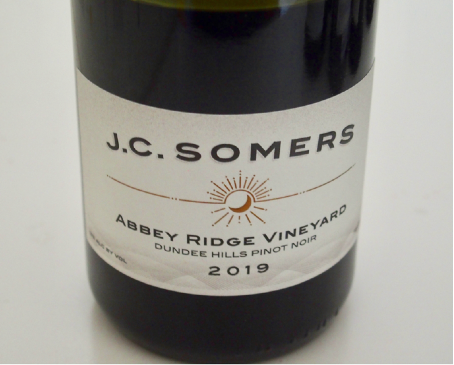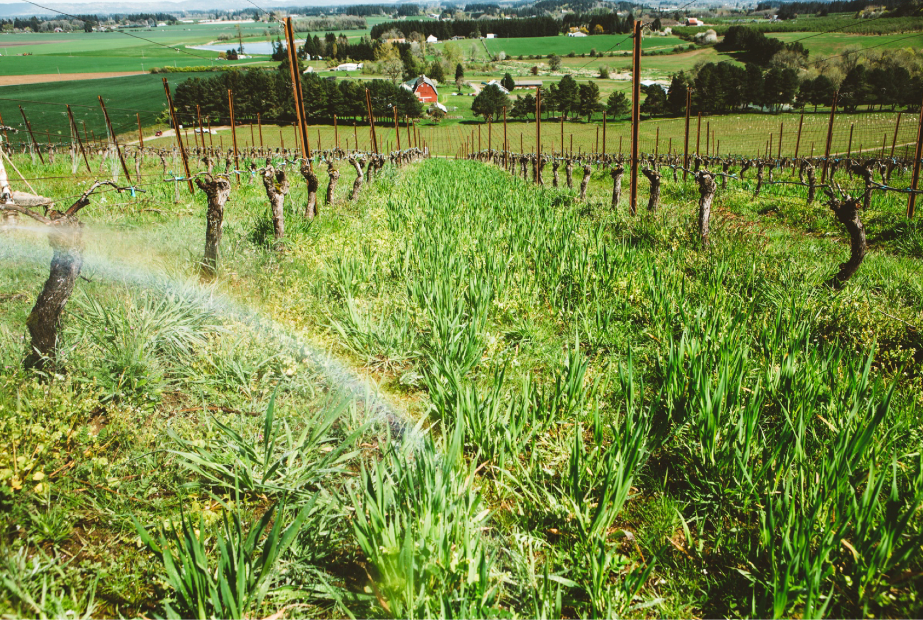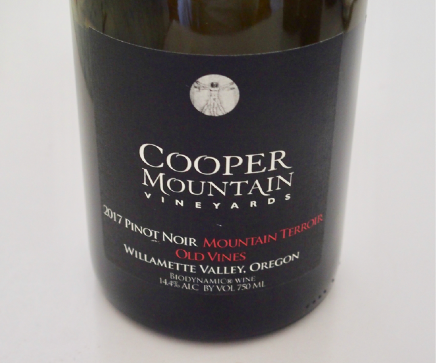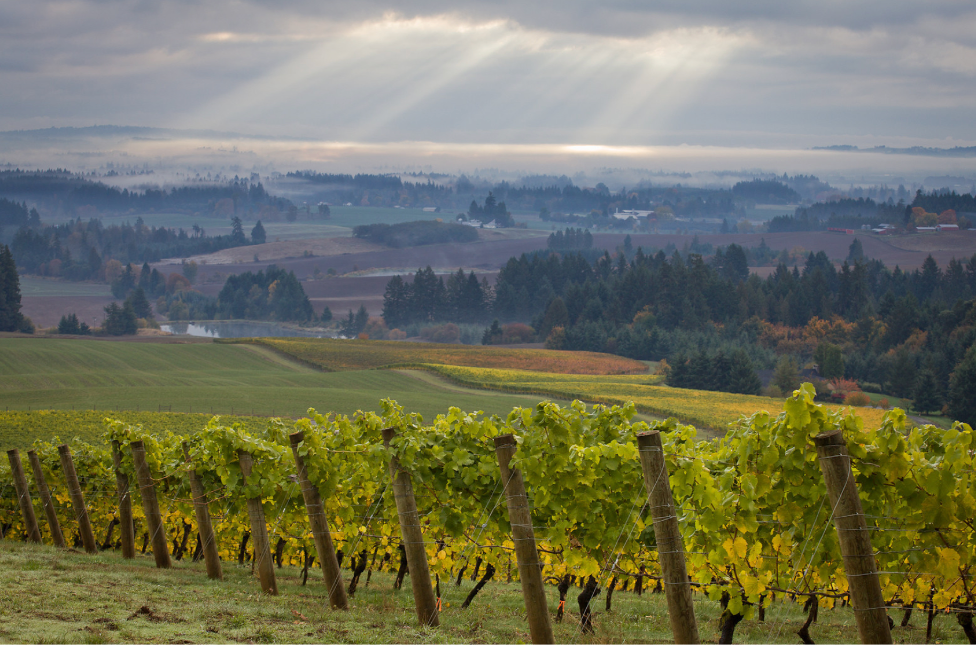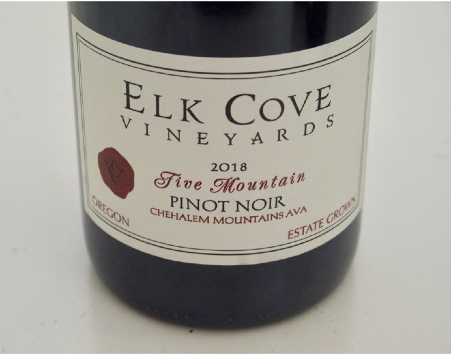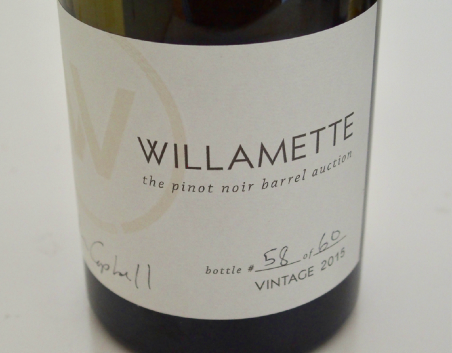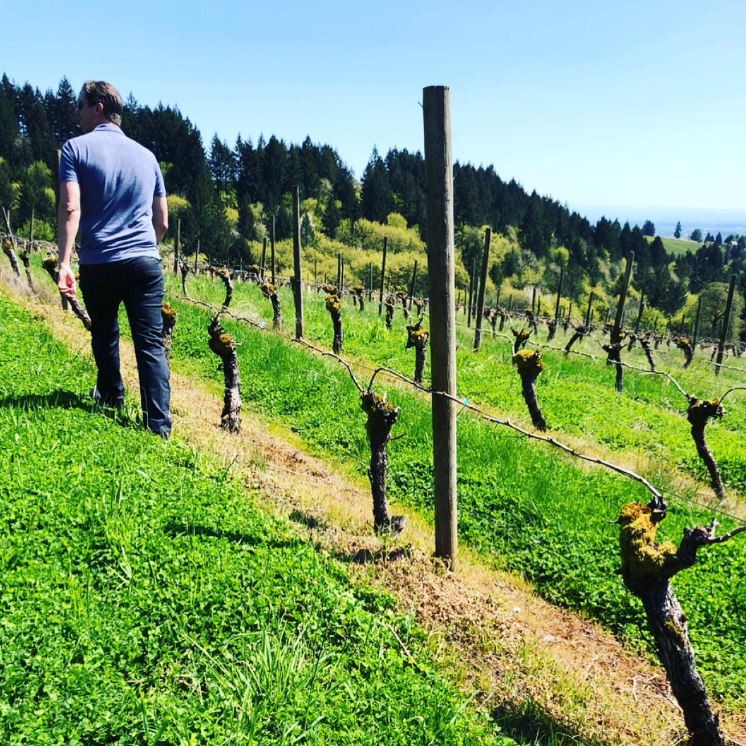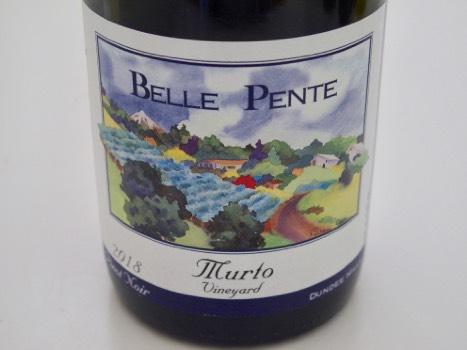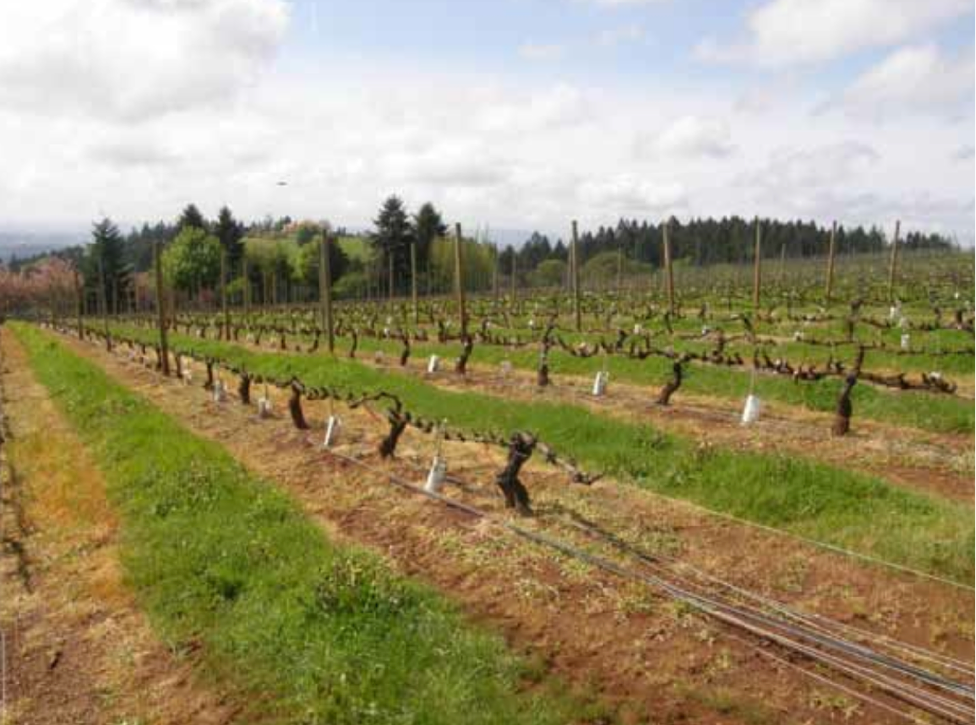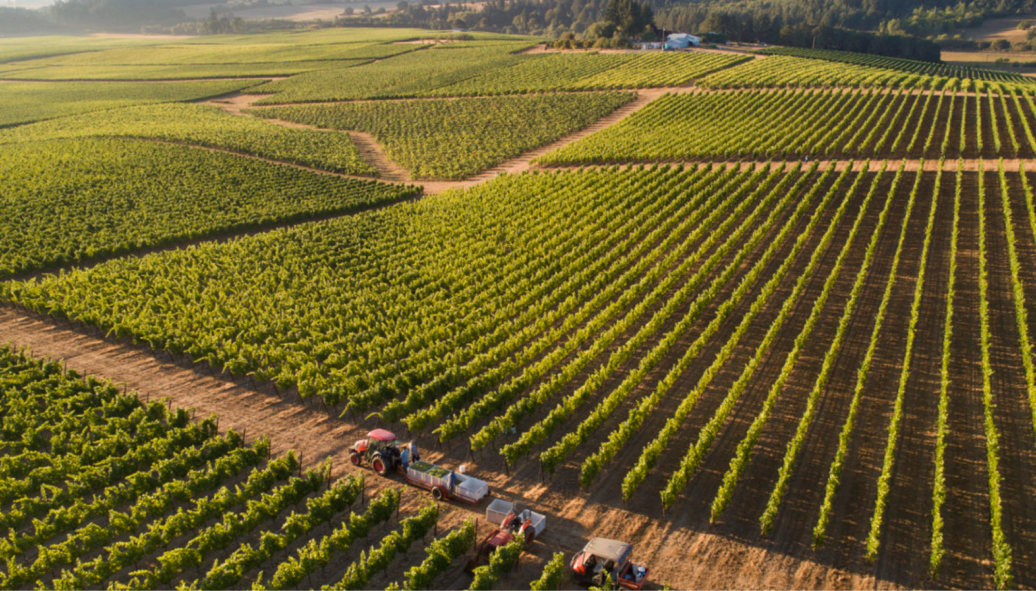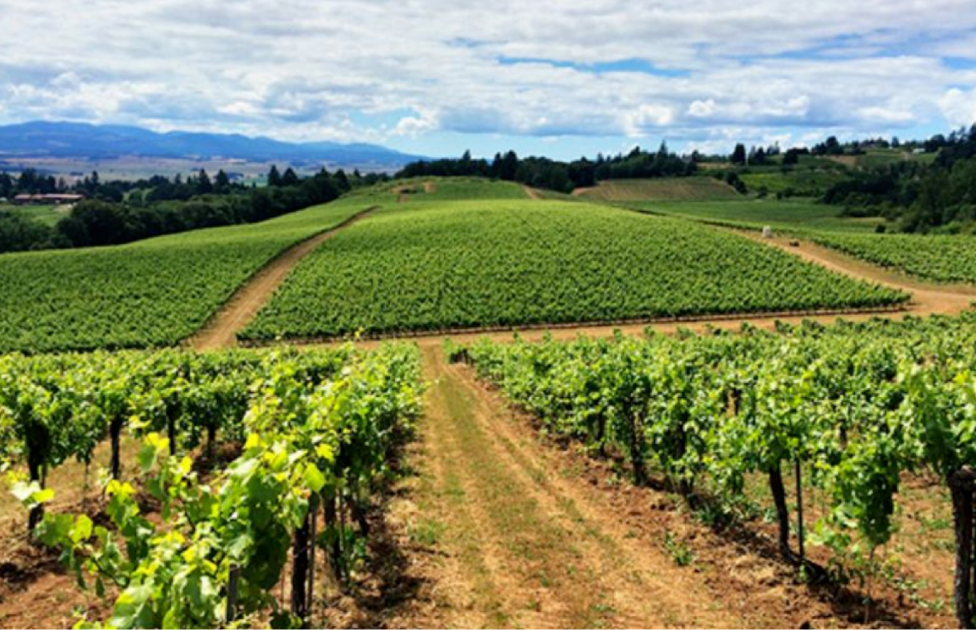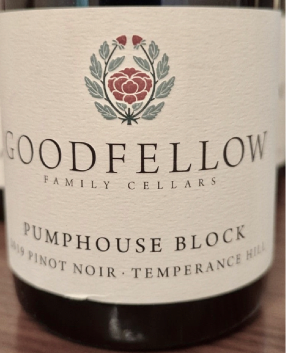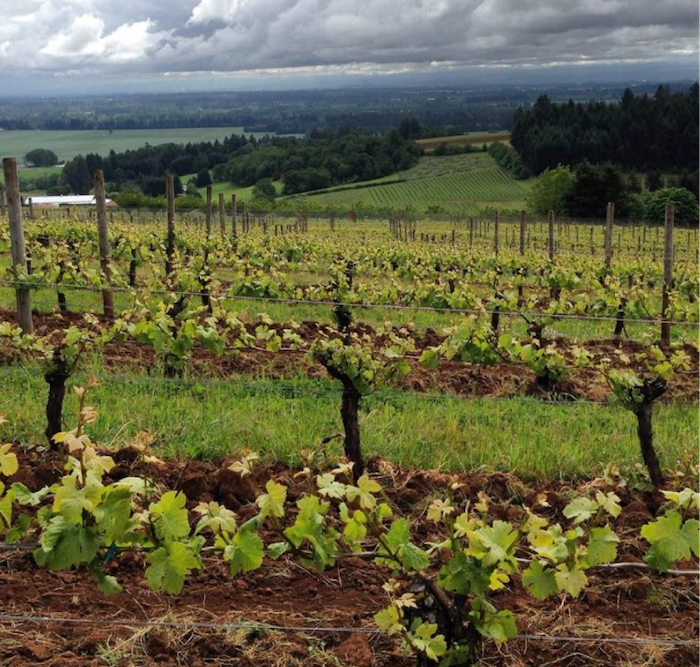PinotFile: 12.29 June 5, 2022
|
Drinking Oregon Pinot Noir History from Old Vine Vineyards
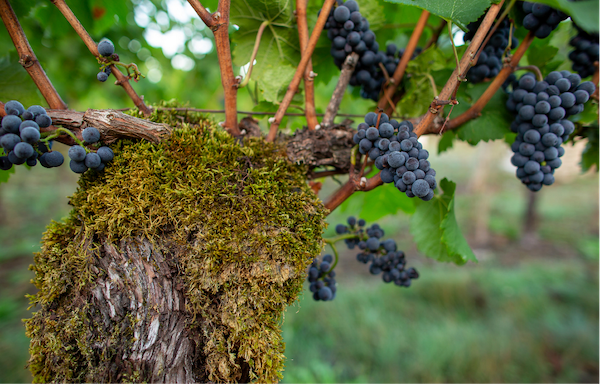
Adam Campbell, Elk Cove Vineyards
ContentsAcknowledgements p 3 Introduction p 5 List of Reviewed Willamette Valley Old Vine Pinot Noir Wines p 9 List of Willamette Valley Pinot Noir Vineyards by Year of Original Planting 1965-1979 p 13 Vineyards Established 1965-1969 p 16 Vineyards Established 1970-1971 p 24 Vineyards Established 1972 p 39 Vineyards Established 1973 p 51 Vineyards Established 1974 p 61 Vineyards Established 1975 p 71 Vineyards Established 1976 p 75 Vineyards Established 1977 p 82 Vineyards Established 1978-1979 p 89 Other Willamette Valley Vineyards Planted in the 1970s p 97 Four Willamette Valley Vineyards with Interesting Histories Established 1981-1983 p 98 Old Vine Quotes p 104 Epilogue: Pommard in Guise p 105
Acknowledgements
Legends
David Adelsheim, founder of Adelsheim Vineyard
Winegrowers & Winery Principals
Peter Adams, Adams Vineyard
Helpmates
Sarah Murdoch, Oregon Wine Board, Director of Communications.
Internet
Linfield College Oregon Wine History Archive, www.oregonwinehistoryarchive.org
Publications
Dirt+Vine=Wine: How grape growers shaped an Oregon pinot noir revolution, Kerry McDaniel
Boenisch
Introduction
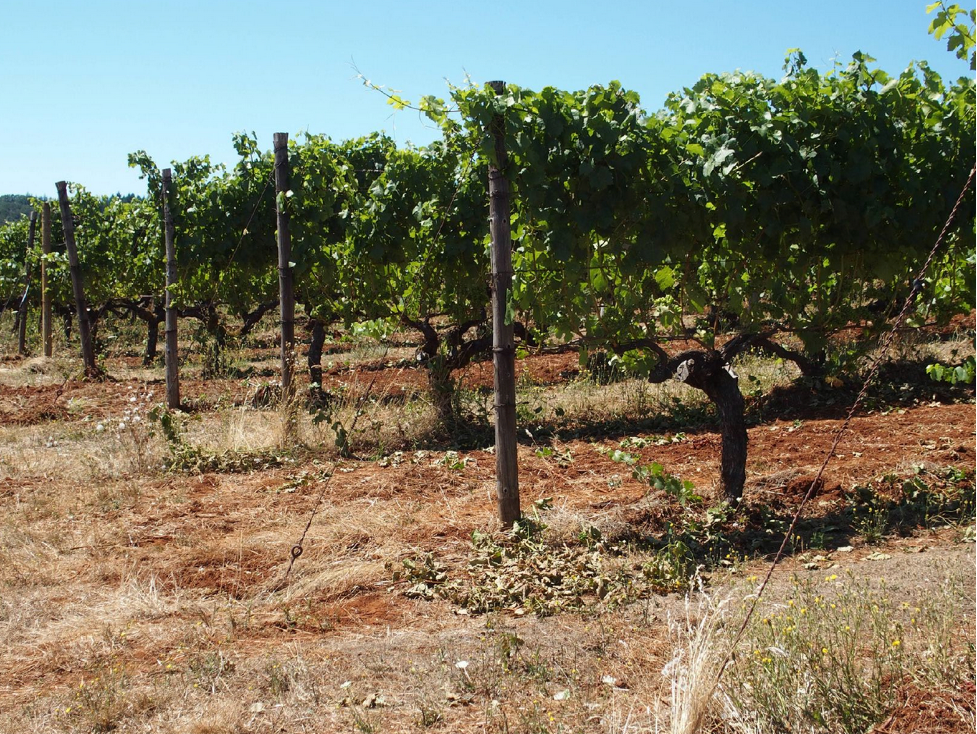
Ted Lemon, Winemaker Littorai
Most winemakers believe the terminology should be defined and regulated. Some would argue that “old vine” grapes should make up at least 85% of the grapes contained in a wine sold as “old vine,” while others prefer that 95% of the grapes be from old vines. There are significant variances to consider among different varietals as well. For example, Pinot Noir vineyards over 20 years of age are considered by many “old”, yet Zinfandel from a 20-year-old vineyard would not be considered “old vine.” For this extensive review of producing old vine Willamette Valley Pinot Noir vineyards, I have chosen 42 years as a cutoff, that is, vineyards originally planted before 1980. There are a precious few of these old vine Pinot Noir vineyards that are still productive in Oregon’s Willamette Valley. This is primarily due to phylloxera, a root-eating aphid that caused the demise of many of the widespread own-rooted plantings of Pinot Noir established in the fifteen years prior to 1980 when it made the most sense to plant vines on their own rootstocks. As Jason Lett pointed out to me, own-rooted vines have more disease resistance, better water use efficiency, and more natural ratios of sugar to acid among other advantages. Phylloxera infestation first began to appear in the early 1990s in the Dundee Hills, the epicenter of early Willamette Valley Pinot Noir plantings. A November 1995 publication by the Oregon State University Extension Service titled “Phylloxera Strategies for Management in Oregon's Vineyards" stated that phylloxera was then in every major grape-producing region in Oregon. As vineyards succumbed to phylloxera, original plantings were often removed and replanting was undertaken with phylloxera-resistant rootstocks. I was able to verify that currently there are only 41 surviving over 40-year-old Willamette Valley vineyards composed of predominantly or totally original own-rooted plantings of Pinot Noir still in significant production. The Willamette Valley old vine vineyards that have survived were often planted properly to begin with, were not tilled, were relatively isolated with restricted access, often managed with proper sanitation, and lovingly farmed by owners who avoided using vineyard equipment from other vineyards and employing outside vineyard workers. A majority of surviving vineyards are in the Dundee Hills AVA. The 1970s were a plentiful time for vineyard plantings in the Willamette Valley. The impetus was the mid-to-late 1960s plantings by California transplants David and Diana Lett (The Eyrie Vineyard), Charles Coury (Charles Coury Vineyard), Dick and Nancy Ponzi (Ponzi Estate Vineyard), and Dick Erath (Chehalem Mountain Vineyard). The history of the first plantings of Pinot Noir and Pinot Gris at The Eyrie Vineyard have been well-documented in the PinotFile: www.princeofpinot.com/article/1090/ The history of the roles of Coury and Erath in the widespread planting of the Coury “clone” can be found at www.princeofpinot.com/article/1214/.

Many of the Willamette Valley winegrowers of the 1970s did not keep good records and therefore adequate documentation of the original planted clone or selection is unavailable. There were three heat-treated and certified Pinot Noir clonal options available from FPS at the time: Pommard UCD 5 and 6, Martini UCD 13 and 15 (more widely planted in California), and Wädenswil UCD 1A and 2A. “Gamay Beaujolais” type clones (particularly UCD 18 and 22), a distinct sub-clone of Pinot Noir and upright in growth (pinot droit), were also available from the FPS. This was a group of five selections known as GB that came to FPS in the early 1960s from a single vine in an old vineyard on the campus of UC Davis. The five selections were FPS 18 (most common in Oregon), 19, 20 (dropped), 21, and 22. Jason Lett’s research would indicate that the cuttings his father obtained from Wente in California in 1965 were Wädenswil UCD 1A (not UCD 2A). Many of the early plantings of the Wädenswil clone in the Willamette Valley were taken from Lett’s vineyard or descendant vines from that vineyard. There was an early heat-treated version of Wädenswil, UCD clone 2A, named UCD clone 30. Erath may have brought UCD 30 to Oregon and propagated vines for himself and others. UCD clone 30 was not widely propagated in Oregon or California partly because of how the name was shown in the Foundation vineyard list of scion material. It appeared under the variety name “Pinot Noir Blue Burgundy” not just “Pinot Noir”), and it was shown under a completely unrelated clone number from its mother vine, clone 2A. The Pommard clone was the first Pinot Noir clone distributed by FPS (renamed FPMS in 1958) in the 1950s and became a workhorse in California vineyards by the 1970s and accounted for ࡪ of Oregon Pinot Noir plantings prior to the arrival of the Dijon clones in the late 1980s. The Pommard clone was brought to Oregon by Erath and Coury as part of their nursery partnership that started in 1970, then dissolved in 1971, with Coury continuing and Erath starting his own nursery in 1973. Together, they obtained other Pinot Noir clones from FPMS including Mariafeld (UCD 23), Martini (UCD 13 and 15), and Jackson (UCD 09 and 16), but none of these were widely planted in Oregon. Coury sold scion materials from his nursery in Oregon that purportedly were Pommard, but incorrectly designated by him in an effort to keep up with the demands for Pinot Noir scion material at the time. These selections became known as the “Coury clone” and were widely planted in the Willamette Valley in the 1970s. They are thought to represent one or more suitcase selections of Pinot Noir brought surreptitiously into the United States by Coury from Alsace France, and are not a true clone or the same as the Pommard clone. In addition, Coury’s nursery offered 23 kinds of Vitis vinifera, some of which also turned up in the cuttings Coury sold as “Pommard”.
Bill Wayne, the founder of Abbey Ridge Vineyard in the Dundee Hills, related the following history to me. “About 1982 I was looking for cuttings of the Pommard clone to expand my vineyard in the Dundee Hills. In 1978, I had bought some “Pommard” from Dick Erath’s nursery, and after a few years, noticed that there were a lot of “rogue” vines mixed in: Gewürztraminer, a weird late-ripening variety, etc. So when I needed more Pommard, I got some cuttings from Hyland Vineyard and my friend Jack Trenhale, expecting that they were more organized and would not have rogue vines. I rooted the cuttings and all was well until 4 to 5 years later when I noticed that the fruit in that part of the vineyard was not like the Pommard from Erath. The clusters were smaller, ripened earlier, the leaves looked different, and the canes were smaller. One time I asked Jack where he had obtained the budwood for the cuttings I had bought and he said they had come from Charles Coury’s vineyard near Forest Grove. Later, I was talking to Mark Teppola who was farming the old Coury vineyard and asked him about some “Pommard” vines that had small clusters, etc. and were in his vineyard. He knew what I was talking about but had no idea of the origin of those vines. A friend who managed vineyards also grew up with Charles Coury’s son, and I talked this over with him. By then, Coury was long out of the grape business and living in California. Finally, at a Christmas party, my friend asked Charles Coury where he got the budwood for the “Pommard” with the small clusters, etc.. He confessed that he had “suitcased” the original budwood from a vineyard in Alsace. It was never Pommard. Since we never found out more about the origin, we started calling it the ‘Coury clone.’" It would be helpful to have an easy and inexpensive test to identify Pinot Noir scion(s) accurately. Researcher Laurent Leduc at Oregon State University received funds from the Erath Foundation to sequence Pinot Noir clones in Willamette Valley vineyards to determine what the Coury selection(s) actually were. Unfortunately, he opted to sequence only the scion material easily available to his lab rather that a large selection so his research did not solve the mystery of the “Coury clone.” In the future, the use of molecular fingerprinting as a tool to test clonal materials may solve the mystery but the testing is expensive. In summary, the majority of Willamette Valley Pinot Noir plantings in the 1970s were a combination of Wädenswil, Pommard, and “Gamay Beaujolais (GB) clones and the Coury selections.The Coury selections were never planted in California. The Willamette Valley is unique in that Wädenswil is widespread in vineyards yet there are very plantings of this clone in California. Many early vineyards were initially planted with a “shotgun” of wine varieties including Gewürztraminer and Riesling (both are very adaptable to Willamette Valley terroir but neither has gained widespread traction), Pinot Gris (Oregon’s signature white wine), Pinot Blanc, Chardonnay, Sauvignon Blanc, and even Cabernet Sauvignon. Vine spacing in original vineyards was dependent on the size of tractors available at the time and has been referred to as “John Deere spacing.” Typically, the distance between rows was 10 feet and the distance between vines was 6-8 feet (10’ x 6’), although the inter-vine spacing tended to be reduced in newer vineyards. In the early 1970s, many vineyards were planted on a whim without proper viticulture knowledge or experience. Proper trellising of Pinot Noir was initiated by the Ponzi’s who had studied viticulture in Burgundy. Vertical trellising was little used in California in the 1970s but the Ponzi’s learned early on that growing the vines upward in a vertical pattern was preferable for Pinot Noir since the fruit was exposed and not shaded. Charles Coury has also been credited with moving the VSP trellis system forward. Collecting verifiable information on the history and current status of Willamette Valley's old vine Pinot Noir vineyards has been a challenge. That said, many vineyard owners have provided detailed information. My research indicates that there are currently less than 200 acres of over 40-year-old own-rooted Pinot Noir vines still in production in the Willamette Valley. Over the past several months, have reviewed 105 currently available and library old vine bottlings from nearly every historically significant vineyard detailed in this report. Many of these wines are from the recent 2015-2019 vintages and are still available from the wineries. Almost none of these wines have been reviewed by any other wine publication. Why bother with old vine Pinot Noir when so many wines are available from more recent plantings that benefit from better virus-free scion material, rootstocks and clones, and more sophisticated viticultural technology? Age is a valuable commodity in vineyards since the aged vine has more potential to reflect the essence of a vineyard or at least mirror the unique character of the site. Also, there are a number of other generally accepted observations that support the value of vine age in the quality of the resultant wines. Wine and Spirits columnist Beppi Crosariol several years ago summed up the superiority of old vine wines. “It’s a difference you can taste. Old vine wines deliver textural richness and layered flavors that build rather than trail off after the upfront fruit fades away. It’s analogous to the warm, rich tone of an old violin versus the brighter timbre of new wood.”
My impressions after tasting many old vine Willamette Valley Pinot Noir wines:
I am in agreement with wine journalist Joe Czerwinski who said, “
Explanation of confusing terminology in this article:
*In the 1970s, cuttings were typically planted in the ground in a “nursery” either on the vineyard property or
elsewhere. The following year, the now-rooted cuttings were planted in the vineyard proper. Most
winery's date their original plantings to the initial rooting year. Most of the original planting dates in this
article refer to the first planting or rooting of the vines.
List of Willamette Valley Old Vine Pinot Noir Reviewed Wines
2018 Adams Reserve Adams Vineyard Chehalem Mountains Pinot Noir 2017 Adelsheim Quarter Mile Lane Vineyard Chehalem Mountains Pinot Noir 2016 Argyle Knudsen Vineyard Dundee Hills Brut Sparkling Wine 2017 Arterberry Maresh Old Vines Dundee Hills Pinot Noir 2018 Arterberry Maresh Old Vines Dundee Hills Pinot Noir 2018 Arterberry Maresh Maresh Vineyard Dundee Hills Pinot Noir 2019 Arterberry Maresh Maresh Vineyard Dundee Hills Pinot Noir 2019 Arterberry Maresh Dundee Hills “Old Vines” 2019 Arterberry Maresh Weber Vineyard Dundee Hills Pinot Noir 2008 Belle Pente Murto Vineyard Dundee Hills Pinot Noir 2018 Belle Pente Murto Vineyard Dundee Hills Pinot Noir 2018 Bethel Heights Southeast Block Eola-Amity Hills Pinot Noir 2018 Bethel Heights West Block Eola-Amity Hills Pinot Noir 2018 Bethel Heights Flat Block Eola-Amity Hills Pinot Noir 2015 Big Table Farms Wirtz Vineyard Willamette Valley Pinot Noir 2016 Big Table Farm Sunnyside Vineyard Willamette Valley Pinot Noir 2017 Big Table Farm Sunnyside Vineyard Willamette Valley Pinot Noir 2018 Big Table Farm Sunnyside Vineyard Willamette Valley Pinot Noir 2017 Brooks Old Vine Pommard Eola-Amity Hills Pinot Noir 2017 Cameron Abbey Ridge Vineyard Dundee Hills Pinot Noir 2019 Cameron Abbey Ridge Vineyard Dundee Hills Pinot Noir 2017 Cameron Reserve Dundee Hills Pinot Noir 2018 Cameron Reserve Dundee Hills Pinot Noir 2019 Cameron Reserve Dundee Hills Pinot Noir 2017 Compton Family Wines Alpine Cuvée Willamette Valley Pinot Noir 2017 Compton Family Wines Mary's Peak Vineyard Willamette Valley Pinot Noir 2018 Compton Family Wines Mary's Peak Vineyard Willamette Valley Pinot Noir 2017 Cooper Mountain Vineyards Old Vines Tualatin Hills Pinot Noir 2016 Craft Wine Co Minimus “1968” Chehalem Mountain Vineyard Chehalem Mountains Pinot Noir 2018 Cristom Old Vine Series Hyland Vineyard McMinnville Pinot Noir 2016 David Hill Winery & Vineyards Black Jack 21 Old Vines Willamette Valley (Tualatin Hills) Pinot Noir 2017 David Hill Winery & Vineyards Black Jack 21 Old Vines Willamette Valley (Tualatin Hills) Pinot Noir 2018 David Hill Winery & Vineyards Black Jack 21 Old Vines Willamette Valley (Tualatin Hills) Pinot Noir 2019 David Hill Winery & Vineyards Old Vine Willamette Valley (Tualatin Hills) Pinot Noir 2019 David Hill Wirtz Vineyard Tualatin Hills Pinot Noir 2010 DION Old Vines Limited Release Chehalem Mountains (Laurelwood District) Pinot Noir 2011 DION Old Vines Limited Release Chehalem Mountains (Laurelwood District) Pinot Noir 2012 DION Old Vines Limited Release Chehalem Mountains (Laurelwood District) Pinot Noir 2014 DION Old Vines Limited Release Chehalem Mountains (Laurelwood District) Pinot Noir 2016 DION Old Vines Limited Release Chehalem Mountains (Laurelwood District) Pinot Noir 2018 DION Old Vines Limited Release Chehalem Mountains (Laurelwood District) Pinot Noir 2018 Domaine Divio Hyland Vineyard McMinnville Pinot Noir 2017 Double OO Hyland Vineyard McMinnville Pinot Noir 2015 Elk Cove Five Mountain Vineyard 1978 Old Vines Selection Willamette Barrel Auction Chehalem Mountains Pinot Noir 2017 Elk Cove Five Mountain Vineyard Chehalem Mountains Pinot Noir 2018 Elk Cove Five Mountain Vineyard Chehalem Mountains Pinot Noir 2018 Elk Cove Windhill Vineyard Chehalem Mountains Pinot Noir 2018 Et Fille Maresh Vineyard Dundee Hills Pinot Noir 2017 Evening Land Seven Springs Vineyard Anden Eola-Amity Hills Pinot Noir 2009 HillCrest Memorial Umpqua Valley Pinot Noir 2017 History Risdall Ranch Vineyard Willamette Valley Pinot Noir 2014 Holloran Le Pavillon Dundee Hills Pinot Noir 2018 Hundred Suns Breaker Vineyard Eola-Amity Hills Pinot Noir 2019 Hundred Suns Breaker Vineyard Eola-Amity Hills Pinot Noir 2012 Hyland Estates Founders Selection One Barrel Hyland Vineyard McMinnville Pinot Noir 2018 Hyland Estates Founders Selection Hyland Vineyard McMinnville Pinot Noir 2017 Hyland Estates Block 3c Winemakers Series Hyland Vineyard McMinnville Pinot Noir 2017 Hyland Estates Block 6 Winemakers Series Hyland Vineyard McMinnville Pinot Noir 2017 Hyland Estates Coury Clone Single Clone Old Vine Hyland Vineyard McMinnville Pinot Noir 2018 Hyland Estates Coury Clone Single Clone Old Vine Hyland Vineyard McMinnville Pinot Noir 2019 Hyland Estates Coury Clone Single Clone Old Vine Hyland Vineyard McMinnville Pinot Noir 2019 JC Somers Abbey Ridge Vineyard Dundee Hills Pinot Noir 2017 J. Christopher Medici Vineyard Old Vine Cuvée Chehalem Mountains Pinot Noir 2015 Kelley Fox Wines Red Barn Blocks Maresh Vineyard Dundee Hills Pinot Noir 2018 Kelley Fox Wines Red Barn Blocks Maresh Vineyard Dundee Hills Pinot Noir 2018 Kelley Fox Wines Maresh Vineyard Dundee Hills Pinot Noir 2017 Lavinea Tualatin Estate Vineyard Willamette Valley (Tualatin Hills) Pinot Noir 2018 Lavinea Tualatin Estate Vineyard Willamette Valley (Tualatin Hills) Pinot Noir 2016 Patricia Green Durant Vineyard Bishop Block Dundee Hills Pinot Noir 2019 Patricia Green Durant Vineyard Bishop Block Dundee Hills Pinot Noir 2019 Patricia Green Chehalem Mountain Vineyard “Erath Clone” Chehalem Mountains Pinot Noir 2019 Patricia Green Medici Vineyard Chehalem Mountains Pinot Noir 2019 Patricia Green Weber Vineyard Dundee Hills Pinot Noir 2019 Patricia Green Precipitous Freedom Hill Vineyard Willamette Valley Pinot Noir 2018 Ponzi Abetina 2 Chehalem Mountains (Laurelwood District) Pinot Noir 2017 Ruby Vineyard Estate Blend Chehalem Mountains (Laurelwood District) Pinot Noir 2017 Ruby Vineyard Flora’s Reserve Chehalem Mountains (Laurelwood District Pinot Noir 2018 Sokol Blosser Watershed Block Estate Vineyard Dundee Hills Pinot Noir 2018 Sokol Blosser Twelve Row Block Estate Vineyard Dundee Hills Pinot Noir 2018 Sokol Blosser Old Vineyard Block Estate Vineyard Dundee Hills Pinot Noir 2016 Spindrift Cellars OSU Woodhall Vineyard Willamette Valley Pinot Noir 2016 The Eyrie Vineyards The Eyrie Original Vines Dundee Hills Pinot Noir 2017 The Eyrie Vineyards The Eyrie Original Vines Dundee Hills Pinot Noir 2018 The Eyrie Vineyards The Eyrie Original Vines Dundee Hills Pinot Noir 2014 The Eyrie Vineyards South Block Original Vines Dundee Hills Pinot Noir 2016 The Eyrie Vineyards Daphne Dundee Hills Pinot Noir 2018 The Eyrie Vineyards Daphne Dundee Hills Pinot Noir 2017 Trathen Hall Ana Vineyard Dundee Hills Pinot Noir 2017 Tyee Wine Cellars Estate Willamette Valley Pinot Noir 2017 Tyee Cellars Estate Barrel Selection Willamette Valley Pinot Noir 2007 Wahle Vineyards & Cellars Original 1974 planting Yamhill-Carlton District Pinot Noir 2014 Westrey Cuvée 22 Dundee Hills Pinot Noir 2011 Westrey Oracle Vineyard Dundee Hills Pinot Noir 2012 Westrey Oracle Vineyard Dundee Hills Pinot Noir 2013 Westrey Oracle Vineyard Dundee Hills Pinot Noir 2018 White Rose Estate White Rose Vineyard Dundee Hills Pinot Noir 2018 Willamette Valley Vineyards Tualatin Vineyard Vintage 45 Tualatin Hills Pinot Noir 2010 Winderlea Legacy Dundee Hills Pinot Noir 2017 Winderlea Legacy Dundee Hills Pinot Noir 2010 Winderlea Ana Vineyard Dundee Hills Pinot Noir 2017 Winderlea Murto Vineyard Dundee Hills Pinot Noir (de-stemmed) 2017 Winderlea Murto Vineyard Dundee Hills Pinot Noir (whole cluster) 2018 Winderlea Murto Vineyard Dundee Hills Pinot Noir (de-stemmed) 2018 Winderlea Murto Vineyard Dundee Hills Pinot Noir (whole cluster) 2017 Winderlea Weber Vineyard Dundee Hills Pinot Noir
List of Williamette Valley Old Vine Pinot Noir Vineyards by Original Planting Dates 1965-1979
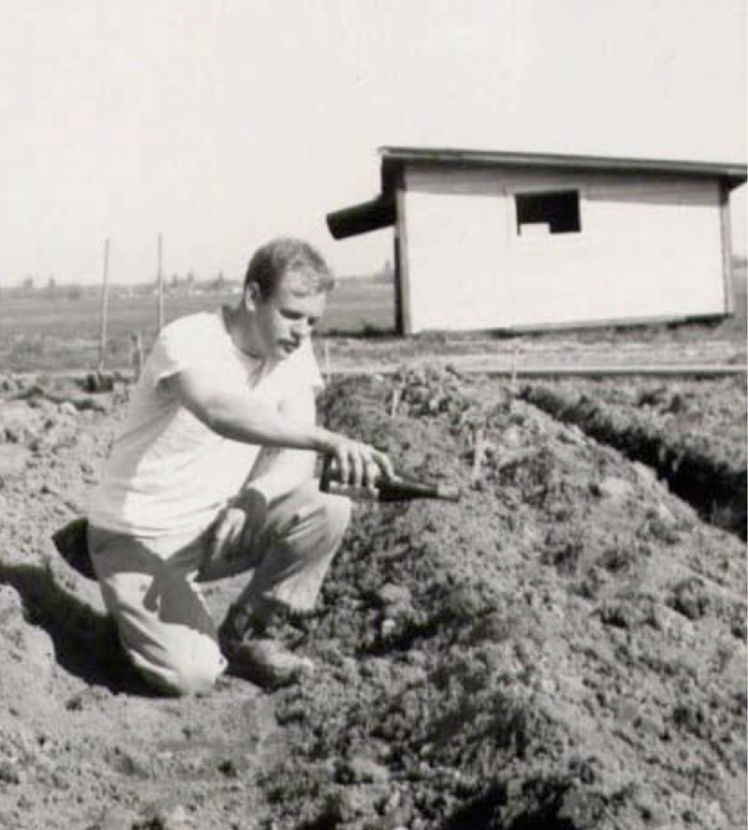 Willamette Valley in the spring of 1965 (Copyright Diana Lett)
The Eyrie Vineyard 1966 Charles Coury Vineyard (now David Hill Vineyard) 1968 Chehalem Mountain Vineyard (variously reported as 1968 or 1969) 1969
Ponzi Estate Vineyard
1970-1971 (and “1970s”)
Maresh Vineyard (1970)
1972
Archibald Vineyard (also reportedly 1973)
1973
Beran Vineyards (now Ruby Vineyard)
1974
Daphne Vineyard
1975
Abetina Vineyard
1976
Adams Vineyard (now Trout Lily Farm)
1977
Bethel Heights West Block
1978
Abbey Ridge Vineyard
1979 Bethel Heights Southeast Block Other Willamette Valley Pinot Noir vineyards planted in the 1970s: Holley Blue Vineyard (1972), Feitz Vineyard (1973), Mulhausen Vineyard (1973), Nehalem Bay Vineyard (1973), Champoeg Vineyard (1974), Jonicolle Vineyard (1975), Ellendale Vineyard (1976), Catalyst Vineyard (1978), Strangeland Vineyard (1978) Chateau Benoit Vineyard (1979), Hidden Springs Vineyard (1979).
Four Special Willamette Valley Pinot Noir vineyards planted in 1981-1983:
HillCrest Vineyard
Vineyards Established 1965-1971
1965-1969
The Eyrie Vineyard
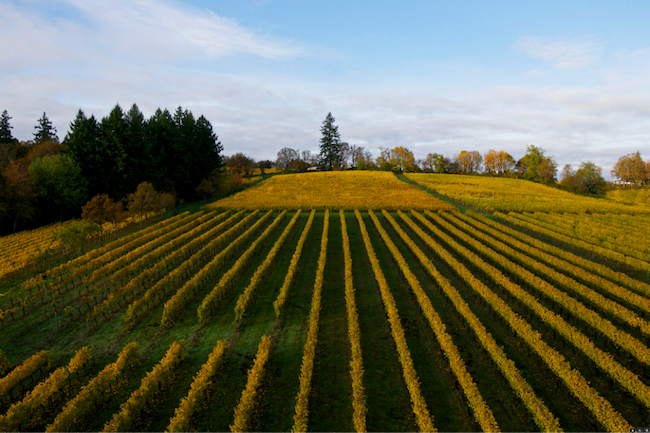
Owners: The winery was founded by David and Diana Lett in 1965. Son and winemaker Jason Lett took over management in 2005. David passed away at the age of 69 in 2008. Location: Dundee Hills AVA Planting: The original plantings consisted of 6.5 acres of Pinot Noir between 1965 and 1974. The initial February 1965 plantings were in Corvallis and moved to the Dundee Hills in 1966. 5 acres of the original plantings are still in production. Pinot Noir Scions: Own-rooted Wädenswil 1A and Pommard 5 with a small amount of Upright Pinot clone 18. The Pinot Noir was sourced from Wente in California. Soil: Volcanic (Nekia and Gelderman) and sedimentary (Woodburn, Dayton and Amity) Vines: 10’ alley for most of the vineyard with 12’ in the South Block, with 6’ vine spacing. Aspect is south-facing at 260’- 410’ elevation. Farming: Vines are non-irrigated. Herbicides have never been used. Farming is regenerative with no till, no fertilizer, and farmed since planted organically with organic certification in 2013. Winery clients: No clients, a monopole. Old vines bottlings: The first vintage of Pinot Noir was 1970. Pinot Noir production currently includes Estate Pinot Noir (containing a small amount of original vine fruit),The Eyrie Original Vines Pinot Noir (100% original vines), and the South Block Reserve Pinot Noir (100% original vines). Of Interest: Small amounts of Chardonnay (Draper selection), Pinot Gris, Riesling, Gewürztraminer, Muscat Ottonel, Pinot Blanc (actually Melon de Bourgogne), Pinot Meunier and Petite Sirah were planted in the initial years. Since the original Pinot Noir vines are own-rooted, they are struggling to survive due to phylloxera infestation. Jason notes, “I am very sad to see this. We are in the process of replanting vines on rootstick as they pass away. Another option has been to re-trunk them in situ by growing a shoot from the base of the plant, train it up, and create a new trunk (this is not something you can do on rootstock vines)."
 2014 The Eyrie Vineyards South Block Dundee Hills Pinot Noir $180.10 rows at the corner of the vineyard among the first vines planted (1968). There is a confluence of four interlocking soils and a unique exposure and climate such that it produces a wine distinct from neighboring vines. Within 7 years of planting, the winery began bottling these rows separately and named the wine “South Block.” This was the first American Pinot Noir to compete successfully against renowned wines of Burgundy at 1979 Paris and 1990 Beaune competitions. David Lett stopped releasing South Block after the victories and kept a few cases of each vintage in the cellar planning to release the wines years or even decades later. · Moderate garnet color in the glass. Alluring aromas of cherry, black raspberry, dried red rose petal and spicy oak. Light to mid-weight in style with deep, engaging flavors of red cherry, cranberry, blueberry, plum, and spice. A gorgeous and sophisticated wine with gentle power, refreshing juiciness, impeccable balance, and an extremely long, scented finish. Score: 96
2016 The Eyrie Vineyards The Eyrie Original Vines Dundee Hills Pinot Noir 13.0% alc., $70. · Dark garnet color in the glass. The wine’s nose continually evolves in the glass over time. The more you smell, the more you find. Aromas of sous-bois, dark cherry, exotic spices, toasted waffle, and dried rose petal. Mid-weight plus in concentration with fruit flavors of black cherry and cranberry. Some of the unique flavors deny description. Somewhat plush on the palate with minimal tannins and welcome harmony. The finish is long and sensual. Score: 94
 2017 The Eyrie Vineyards The Eyrie Original Vines Dundee Hills Pinot Noir 13.0% alc., $70. · Light garnet color in the glass. Lovely aromas of red rose, red cherry, sandalwood and spicy oak. Elegantly styled and lacy, with a lighter weight impression but more power that expected considering the light color.Very easygoing, with bright acidity, gossamer tannins and a finish with unusual length and generosity. Seductive rather than hedonistic. Score: 93
2018 The Eyrie Vineyards The Eyrie Original Vines Dundee Hills Pinot Noir 13.0% alc., $85. · Moderate garnet color in the glass. Aromas of strawberry, red cherry, red licorice, baking spices, bramble, and inviting oak soar over time in the glass. Elegant in a lighter-weighted style that is very suave in the mouth. There is both fruit flavors of red and blue berries as well as a savory bent of dried herbs. Dusty tannins, a shadow of oak and a very long finish completes the picture. Dare I say “Burgundian?” Score: 94
Charles Coury Vineyard/David Hill Vineyard
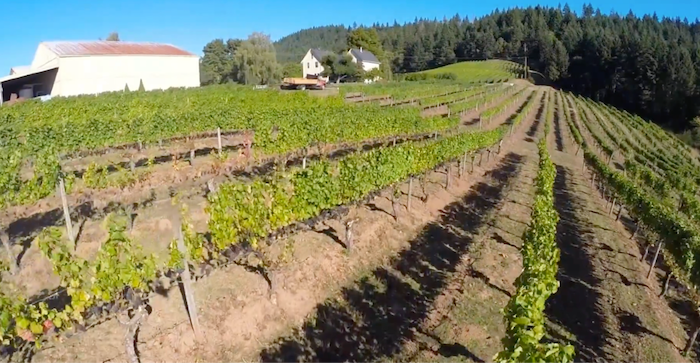
Location: Forest Grove, OR, in the Tualatin Hills AVA.
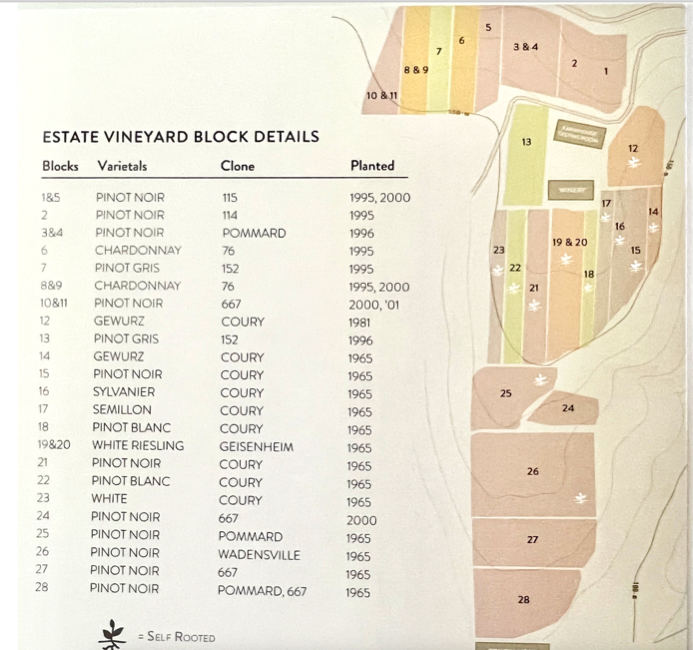
Pinot Noir Scions: The original Pinot Noir planted was own-rooted Wädenswil (? 3A), Pommard (? 4), and possibly non-heat treated origins) and the Coury selection (often referred to as the “Coury clone,” but actually selections of Pinot Noir suit cased from Alsace, France by Charles Coury). According to a regional historian, Kerry McDaniel Boenisch, Coury said, “I did bring back rootstock from Alsace in a suitcase. It was called the Bergheimer clone.” He also shipped cuttings to the agricultural quarantine port in San Francisco where he picked them up and drove them to Oregon. Soil: Laurelwood soil series. Vines: South-facing site. At some point, the old vines were transitioned to cordon pruned (about 2004-2011) with extremely low yields. After several years, the vines are now cane pruned with more healthy yields. Farming: LIVE certified, no-till farming. No phylloxera to date, partly due to the seclusion of the vineyard and the surface of the wind-blown loess in the Laurelwood soil series. Winery clients: Today, almost all vineyard yields are devoted to David Hill Vineyard & Winery production under the direction of winemaker Chad Stock. A minuscule amount of original Pinot Noir has been sold to Golden Cluster and that winery also bottles Semillon from the David Hill Vineyard. Old vines bottlings: The winery’s flagship old-vine bottling is the Estate Black Jack 21 Pinot Noir produced from Block 21 Coury selections planted in 1966. Another bottling containing fruit from all three original blocks was labeled Reserve until 2015 when the name was changed to “Old Vine”. A limited amount (25 cases) of old vine Charles Coury Vineyard Pinot Noir was produced by Golden Cluster beginning in 2018.
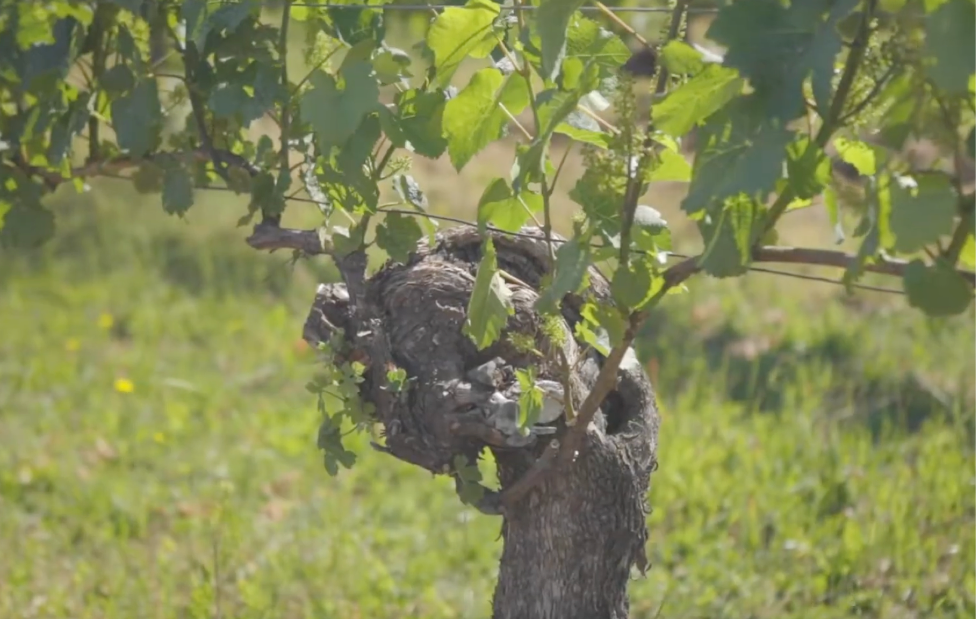
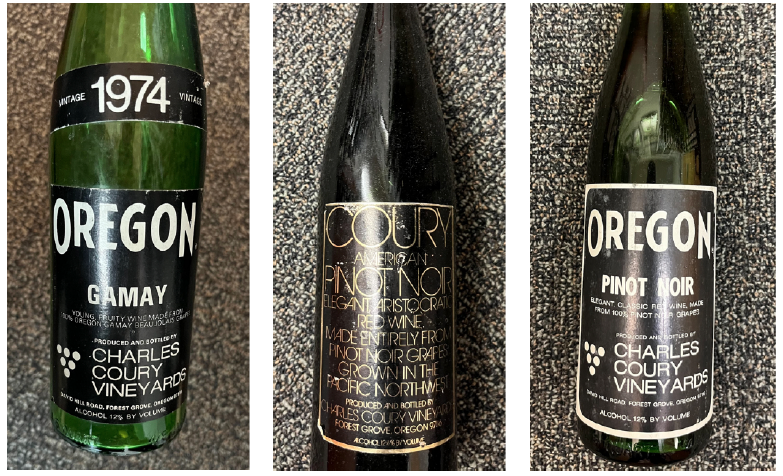
2016 David Hill Black Jack 21 Tualatin Hills Willamette Valley Pinot Noir 14.1% alc.,pH 3.68, TA 0.57, $55. Aged 14 months in French oak barrels, 30% new. Unfiltered. · Moderately dark garnet color in the glass. Aromas of well-ripened black fruits. Mid-weight plus richly layered flavors of black raspberry, black cherry, blackberry, cassis, and spice. Seamless texture, with a dusting of tannins, tailing off at the finish like silk. Bold and dense in this vintage but enjoyable. Much better when tasted the following day from a previously opened bottle. Score: 91
2018 David Hill Black Jack 21 Tualatin Hills Willamette Valley Pinot Noir 14.4% alc., pH 3.91, TA 0.56, $55. Aged 16 months in French oak barrels, 40% new. · Moderately light garnet color in the glass. The nose features very ripe purple and black fruits with hints of orange peel, pipe smoke, sweet compost and floral lift. Noticeably muscular tannins initially frame the mid-weight core of dark cherry, blueberry and pomegranate fruit flavors. More refined, with less evident tannins and a noticeably long finish when tasted the following day. Score: 90
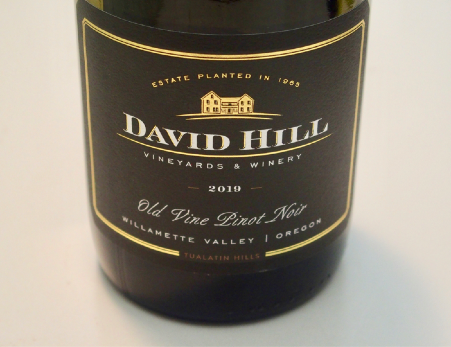 2019 David Hill Old Vine Willamette Valley Pinot Noir 13.4% alc., pH 3.59, TA 0.61, $70. A combination of Pommard and Wädenswil clones and Coury selection planted in “1965.” Aged 18 months in French oak barrels, 5% new and 95% neutral. · Moderate garnet color in the glass. Aromas of red cherry, sandalwood and sweet mulch. Delightful core of fresh spiced cherry flavor. Elegantly composed and charming, with a silken texture, suede tannins and a finish that seems to linger for at least a minute. This wine is clearly recognizable as a special old vine Pinot Noir that has me searching for superlatives. Reminds me of a great 1er Cru red Burgundy. Score: 95
Chehalem Mountain Vineyard

Location: Dopp Road across the street from the eastern border of Ribbon Ridge in the Chehalem Mountains AVA. Planting: Dick Erath told me through a recent personal communication that a total of 8 acres of own-rooted Pinot Noir was originally planted between 1969 and 1978. It is commonly reported in the wine literature, winery promotions and the current vineyard’s website that the vineyard dates to 1968. According to Paul Pintarich’s detailed account of the early Oregon winegrowers in The Boys Up North, Erath moved to the Willamette Valley in 1968 and spent that year clearing the land in preparation for planting while his cuttings were nurtured by Charles Coury. Pintarich dated the planting of 4 acres of Pinot Noir, Riesling and Gewürztraminer to the spring of 1969. Today, the original Pinot Noir plantings consist of 2.3 acres designated as Block D3, and the 1978 planting of 2.11 acres is designated Block E1. Pinot Noir Scions: The initial planting was an own-rooted Wädenswil clone followed by an own-rooted Pommard clone. The 1978 planting was an own-rooted Pommard clone. Soil: Willakenzie sedimentary series Vines: The vineyard is at 300’-520’ elevation and primarily south-facing with some southwest facing aspect. There is a variety of vine spacing in each block but the original vines were planted 12’ x 6’. Farming: Dry-farmed. Cooper Mountain vineyards plan to convert the vineyard to organic and biodynamic farming. Winery clients: Aberrant Cellars (2014-2016), Minimus (2016), and more recently Double Zero (OO) Wines and Failla. Patricia Green Cellars picked up the 1978 planted block E1 in the 2019 vintage. The future is in question with the acquisition of the vineyard by Cooper Mountain Vineyards. Old vines bottlings: Craft Wine Co. Chehalem Mountain Vineyard Pinot Noir, Patricia Green Cellars Chehalem Mountain Vineyard Erath Clone Pinot Noir (the clone is actually Pommard, not the so-called Erath clone). Of interest: The vineyard now has 33.5 acres planted to Pinot Noir and Chardonnay including 31.5 acres of Pinot Noir (seven clones). 18 additional acres of Pinot Noir and Chardonnay are being developed on the site.
2016 Minimus “1968” Chehalem Mountain Vineyard Chehalem Mountains Pinot Noir 12.7% alc., $70. Produced by Craft Wine Co, in Carlton, OR. · Moderate garnet color in the glass. The nose is dusty and nutty with a hint of red cherry. More expressive on the palate with a juicy core of red berry and cherry fruit flavors framed by an arrow of vibrant acidity and a dusting of silky tannins. A petrol note may come from oak. The modestly persistent, raspberry-fueled finish is satisfying. Score: 90
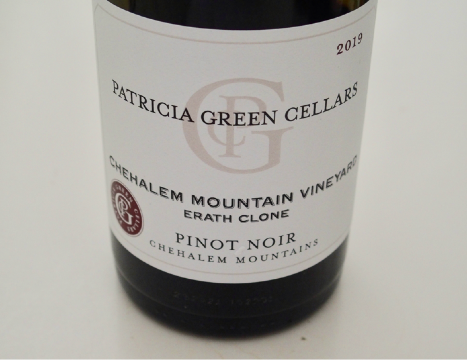 2019 Patricia Green Cellars Chehalem Mountain Vineyard Erath Clone Chehalem Mountains Pinot Noir 13.1% alc. $60. Grapes are from the 1978 planting of own-rooted Pommard. · Dark garnet color in the glass. Profuse aromas of sous-bois, darker fruits and rose petal. Mid-weight plus in style with the dense essence of blackberry, cassis and boysenberry fruits backed by beefy tannins. There are hints of cola, black tea leaves and oak. Somewhat rustic, with a mildly astringent finish. Slightly aloof initially but more engaging when tasted the following day. A good cellar candidate. Score: 92
Ponzi Estate Vineyard
Planting: 2 acres of own-rooted Pinot Noir planted on a 20-acre site. Interplanting began in 1980. The original vines are still in full production according to Luisa Ponzi. Pinot Noir scions: Own-rooted Pommard 4 from Wente’s Arroyo Seco increase block and UCD 18 (GB) from another increase block farmed by Mirassou. Soil: Laurelwood series. Soils are very sandy loam so old age as opposed to phylloxera will eventually lead to decline. Vines: Southeast-facing vines originally planted with 9’ x 7’ spacing. Interplanting in 1980 increased spacing. Winery clients: None, a monople. Old vines bottlings: None. The Pinot Noir goes into the winery’s Rosé or Tavola Pinot Noirs. Of Interest: The vineyard also has Chardonnay 108 that goes into the winery’s Blancs de blanc and Reserve Chardonnay, Pinot Gris that goes into the “Old Vine: Pinot Gris blend, and Riesling into the winery’s Riesling. Reportedly, some of the original plantings included some “Pinot Blanc” acquired from David Lett that turned out to be Melon.
William Sims Family Vineyard
1970-1971
Maresh Red Hills Vineyard
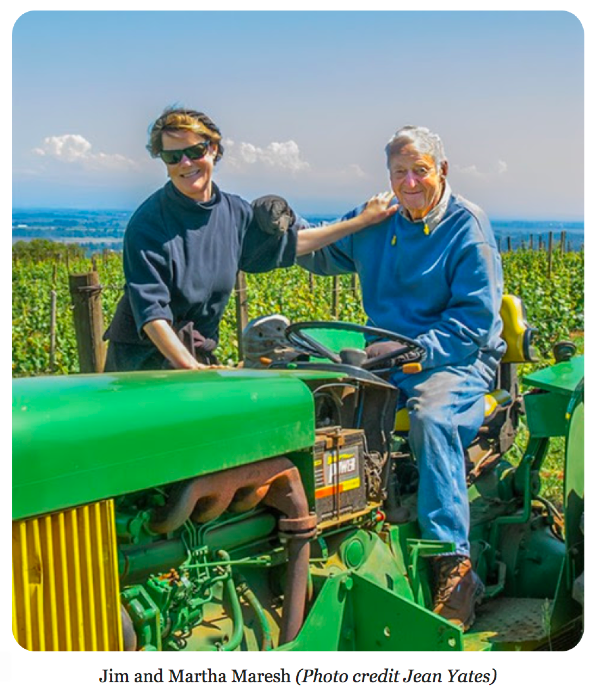
Location: High in the Dundee Hills on NE Worden Hill Rd. in the Dundee Hills AVA Planting: Jim and Loie Maresh bought a 27-acre farm in the Dundee Hills in 1959. They eventually expanded their holdings to 160 acres. Vineyard folklore relates that Dick Erath drove to the property without notice in 1969 and told Jim that he was sitting on a great viticultural site. Jim took his advice and in 1970 planted 1.5 acres of own-rooted Wädenswil clone Pinot Noir in front of the property’s Red Barn (Block 1) and 1.27 acres of own-rooted Wädenswil clone of Pinot Noir and 1.49 acres of White Riesling planted to the south of Block 1 and also adjacent to the Red Barn (Block 2). The remainder of the vineyard was planted in 1971 (Block 3), 1973, 1974 (Block 4), and in the 1980s until at least 1988 using own-rooted Wädenswil and Pommard clones for Pinot Noir. There are multiple numbered blocks in addition to names such as Long Rows, Weird Seven Rows, etc. Currently, there are about 30 acres of old Pinot Noir and all of these vines are still producing. The vineyard is also planted to Chardonnay, Riesling, Pinot Gris and Sauvignon Blanc. Of the farm’s 100 acres, approximately 40 are planted to vines, along with walnuts, cherries and forest to avoid a monoculture. Pinot Noir scions: Own-rooted Wädenswil and Pommard. Soil: Deep, volcanic Jory type that is distinctly dark red in color. Vines: 550’-700’ elevation. Initial plantings had 12’ x 6’ spacing. Farming: Dry-farmed to organic standards. Largely free of phylloxera. Yields on older blocks (1970-1980) is 1 to 1.5 tons-per-acre with less in some years depending on the weather during fruit set.
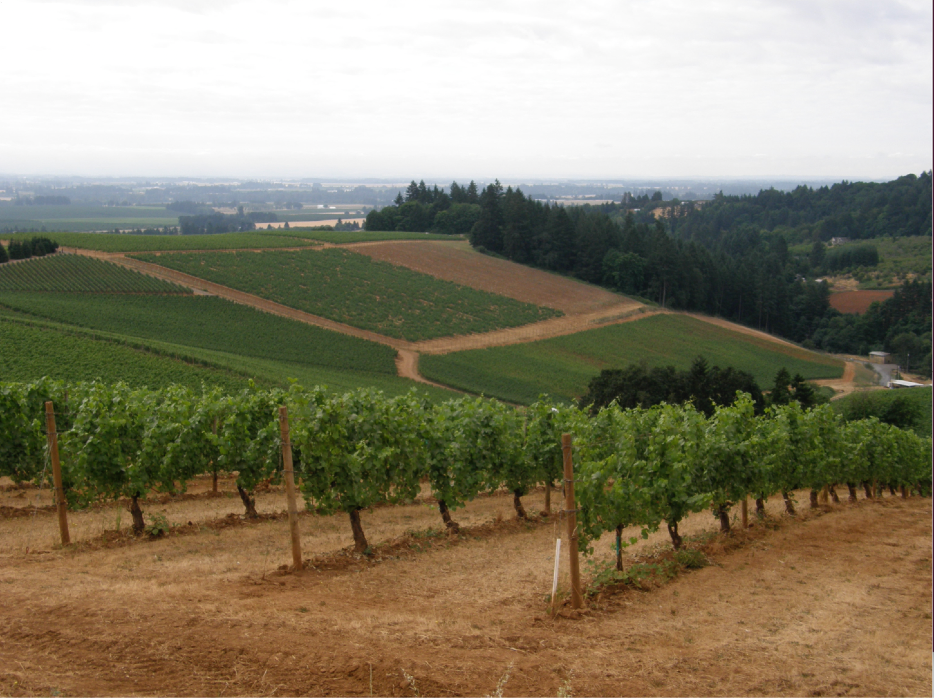
Old vines bottlings: Arterberry Maresh, Kelley Fox and Et Fille. Note: Kelley Fox produces a Maresh Vineyard Royal Ann Block Pinot Noir. She had asked the late Jim Maresh Sr. how he felt about naming his section of the long rows of Block 10 the Royal Ann Block since her vine rows were contiguous with the over-100-year-old Royal Ann cherry trees in front and to the west of his house on the Maresh farm. Kelly Fox also produces a Maresh Vineyard Star of Bethlehem Flower Maresh Vineyard Pinot Noir from Block 10 on the north side of NE Worden Road behind the late Jim Maresh’s house. Star of Bethlehem flowers have been seen growing in the vine rows on and off for a long time. Both Royal Ann Block and Star of Bethelem Flower bottlings are from the 1 acre Block 10 planted to own-rooted Pommard in 1988. The last vintage for Et Fille Maresh Vineyard Pinot Noir is 2022.
2017 Arterberry Maresh Old Vines Dundee Hills Pinot Noir 12.8% alc., $44. Own-rooted Wädenswil clone planted in 1970 (Block 1). Aged 20 months in French oak barrels. · Moderately light garnet color in the glass. Pleasant aromas of red cherry, red rose petal, and spice soar in the glass over time. Lighter weight, even slightly shallow flavors of red cherry, strawberry, raspberry, and baking spice are driven by juicy acidity. Gossamer tannins make for easy drinking. The finish is not exceptionally long but pleasing. Score: 91
2018 Arterberry Maresh Old Vines Dundee Hills Pinot Noir 13.0% alc., $44. Own-rooted Wädenswil clone planted in 1970 (Block 1). · Moderately light garnet color in the glass. Persistent aromas of red cherry, red rose, pine and baking spices. Light to mid-weight in heft with a core of fresh, juicy cherry essence annotated with hints of dried herbs and plum sauce. There is a thread of smoky oak. Impressive harmony, with slippery tannins and a finish that lasts and lasts. Still very enjoyable when tasted the following day from a previously opened bottle when the seductive aromas just would not quit. Score: 93
2018 Arterberry Maresh Maresh Vineyard Dundee Hills Pinot Noir 13.0% alc., $69. Own-rooted Pommard and Wädenswil clones planted in 1974. · Moderately light garnet color in the glass. The nose offers a mysterious bent with aromas of turmeric, dark chocolate, old barrel cellar and black cherry reduction. Instantly gratifying after opening, flooding the mouth with black cherry goodness and caressing the palate in a light to-mid-weight style. Plush and polished on the palate with soft tannins and a very long finish that seems to last an eternity. Score: 94
2019 Arterberry Maresh Maresh Vineyard Dundee Hills Pinot Noir 13.0% alc., $69. Own-rooted Pommard and Wädenswil clones planted in 1974. Aged 23 months in French oak barrels. · Moderately light garnet color in the glass. Complex nose that is giving upon opening with aromas of cherry, tilled earth, dried red rose petal, woodsy perfume and a hint of oak. Light to mid-weight in style with a bright red cherry and red berry core accented with a subtle oak thread. Exceptional balance with a lengthy, red cherry driven finish. This beauty is the epitome of old vine gracefulness. Still grand when tasted the following day from a previously opened bottle. Score: 95
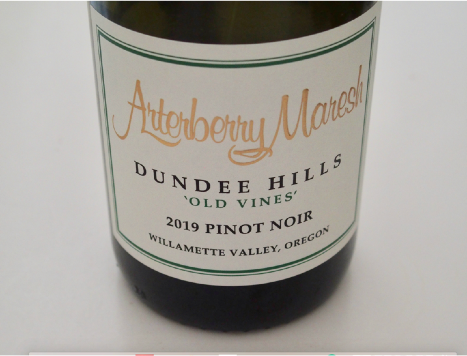 2019 Arterberry Maresh Dundee Hills “Old Vines” Pinot Noir 13.0% alc., $49.The first Old Vines bottling without any Weber Vineyard in the blend. 100% Maresh Block 1 planted in 1970 in front of the Red Barn tasting room. · Moderately light garnet color in the glass. Gorgeous aromas of deep, dark cherry and sous bois. A little richer than the 2018 version of this wine with plenty of dark cherry, blueberry and raspberry flavors framed by supporting tannins. The long, succulent finish is captivating. This wine has everything the 2018 version has but more of it. Score: 94
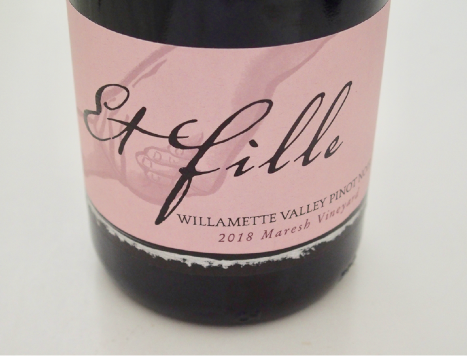 2018 Et Fille Maresh Vineyard Dundee Hills Pinot Noir 13.5% alc., $54. Pommard clone. · Moderate garnet color in the glass. A serious, sophisticated offering with aromas of cherry leather, strawberry, Marionberry, oak spice, and sous-bois. The discretely concentrated core speaks of well-ripened Pommard-driven sap with Bing cherry, turmeric, and cola flavors. Sleek in the mouth, with a compliment of tannins, a shadow of oak, and a persistent finish. This admirable wine has superb balance and is immensely satisfying. Score: 94
2015 Kelley Fox Wines Red Barn Blocks Maresh Vineyard Dundee Hills Pinot Noir 13.5% alc., $99, screw cap. Sourced from blocks of own-rooted Wädenswil and Pommard clones surrounding the Maresh Red Barn. · Light garnet color in the glass. The incredibly seductive nose offers aromas of red cherry, strawberry, spice, red rose petal and sandalwood. Gentle power in the mouth offering more presence than one would expect from the wine’s light color. Elegantly styled with a train of juicy red cherry flavor and a subtle savory herbal note. Suave in the mouth with a shadow of oak and a very long, lip-smacking finish. Tastes like an aged La TËche. Score: 95
2018 Kelley Fox Wines Maresh Vineyard Dundee Hills Pinot Noir 13.5% alc., 213 cases, $69. Sourced from 48-year-old vines in Maresh vineyard including Kelley’s half of the Old Block 1 she has worked with since 2008. 30% whole cluster. · Moderate garnet color in the glass. Aromas of red cherry, baking spices, and sandalwood lead to a medium-bodied style featuring red and black cherry, spice and a pretty floral flush. The flavor reminds me of Martha Maresh’s Queen Anne cherry pie I indulged in several years ago. No noticeable tannins, enjoyable acid-driven perkiness, and a long, quenching finish. Very “pretty” and harmonious. Score: 94
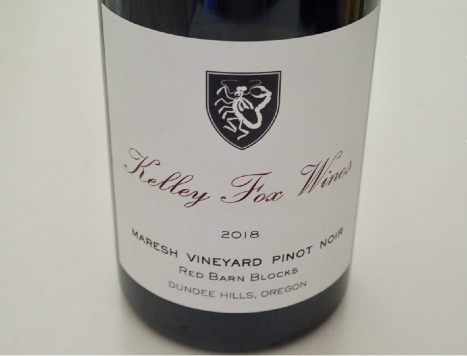 2018 Kelley Fox Wines Red Barn Blocks Maresh Vineyard Dundee Hills Pinot Noir 13.5% alc., $100. This one year bottling includes grapes were sourced from Block 2 behind the Maresh Red Barn and Block 1 in front of the Red Barn. This bottling refers to her section of rows in Block 1 planted in 1970 and Block 2 planted in 1974. Own-rooted Pommard and Wädenswil clones. Last vintage of this wine. · Moderately light garnet color in the glass. Vibrant aromas of red cherry, red berry, baking spice and rose petal. A nose to die for. Elegantly composed with an array of red fruits discretely concentrated. Silken in texture with gossamer tannins and a lip-smacking, unbelievably long finish. This wine is the epitome of Pinot Noir grace. Score: 95
Sunnyside Vineyard
Planting: 16 acres of vines were planted to own-rooted Pinot Noir, Upright Pinot, and Riesling in 1970-1971. The vineyard had been neglected when Luci and Tom acquired it, but Luci, who was a former forester, and Tom, who was a high school teacher, saved about 6 acres of the original vineyard. The owners lovingly restored the health of the vines. Luci told me, “We make the soil happy, keep the vines beautiful, sucker up new trunks, and treat the vines ‘like kids’”. Pinot Noir Scion: Primarily own-rooted Wädenswil. Soil: Volcanic Jory-Nekia. Vines: Vines are oriented east-west. The site has a gentle southwest slope at 630’ elevation. Vines are upright with 10’ x 6’ spacing. Farming: Luci and Tom do much of the farming by hand. The vineyard is dry-farmed and LIVE certified. No phylloxera has been discovered as the vineyard is relatively isolated. Winery clients: Amity Vineyards sourced the grapes during the 1970s and 1990s. After 2000, there were other wineries to follow. Big Table Farm is now the exclusive Pinot Noir client and has bottled a vineyard designate since 2011. Old vines bottlings: Big Table Farm Sunnyside Vineyard Pinot Noir Of Interest: Gewürztraminer was planted in 1983. Two blocks of Upright Pinot have been grafted to other varieties including Dijon 777. One acre of Upright Pinot remains. Today the vineyard consists of 9 acres including 4.5 acres of Pinot Noir and Upright selection, and 4.5 acres of Gewürztraminer, Riesling and Chardonnay. Big Table Farm is using cuttings from Sunnyside vineyard to plant Phase II of their estate vineyard.
2016 Big Table Farm Sunnyside Vineyard Willamette Valley Pinot Noir 14.3% alc., Magnum. · Moderately light garnet color in the glass. Aromas of black cherry, sous-bois, burnt tobacco and exotic spices. Earth-driven flavors of blackberry, black raspberry, black tea and tobacco. Juicy, with soothing tannins and a long finish. Plenty of whole-cluster input in this wine. This bottle does not past muster with another bottle tasted a few years ago that scored 95. Score: 90
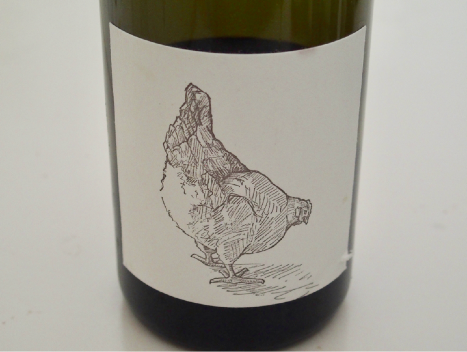 2017 Big Table Farm Sunnyside Vineyard Willamette Valley Pinot Noir 13.7% alc., $62. Unfined and unfiltered. · Moderately light garnet color in the glass. Revealing aromas of strawberry, rose petal, forest floor and a hint of matchstick. Suave in the mouth, with a pleasing mid-weight core of earthdusted cherry and blueberry fruits. Seamless, with gentle tannins and a long, cherry-fueled, mouth watering finish. Heavenly when tasted the following day from a previously opened bottle. Score: 95
2018 Big Table Farm Sunnyside Vineyard Willamette Valley Pinot Noir 14.1% alc., $64. Unfined and unfiltered. · Moderately dark garnet color in the glass. Hi-tone aromas of black cherry compote. The spicy black cherry and blackberry fruit flavors saturate the palate, finishing very long and generous. There is noticeably real staying power on the mid-palate and finish. Richer, with more power and ripeness than the 2017 vintage version of this wine. Terrific when tasted the following day from a previously opened bottle. Score: 95
2019 Big Table Farm Sunnyside Vineyard Willamette Valley Pinot Noir 12.9% alc.,242 cases, $68. Bottled unfined and unfiltered. · Moderately light garnet color in the glass. Lovely aromas of cherry, strawberry, floral lift and potpourri. Stunning nose! Mid-weight flavors of dark red cherry and berry saturate the mid-palate, finishing strong and long. Gracious tannins with felty tannins and welcome balancing acidity. Terrific now, but has the balance to age. Sunnyside Vineyard is my favorite in the Big Table Farm stable. Score: 94
Preston Vineyard/Amity Estate Vineyard
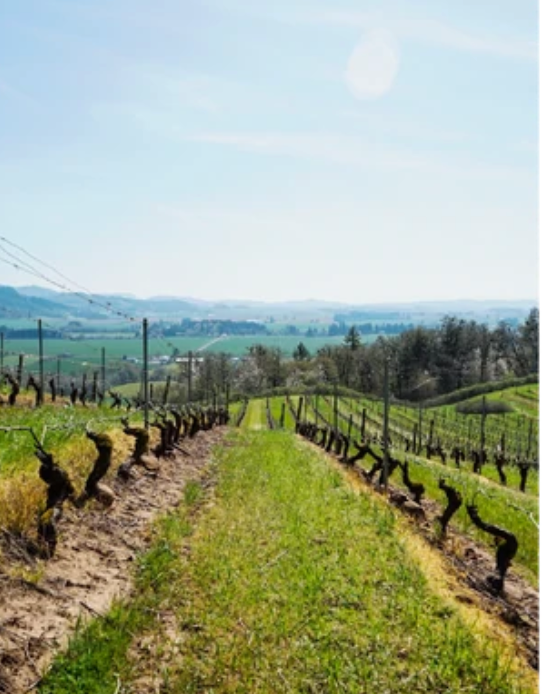
Location: Just outside the city limits of Amity, 45 miles southeast of Portland, in the Eola-Amity Hills AVA. Planting: The 10-acre Preston Vineyard had been neglected when Redford acquired it. All of the Chardonnay and between 25% and 50% of the Pinot Noir vines were dead. He had to revitalize and replant much of the vineyard. I researched the Linfield Wine History Archives to find details of plantings but the notes are all handwritten and difficult to decipher. It appears that 1.5 acres of own-rooted Wädenswil Pinot Noir and 2.5 acres of Upright Pinot had been planted by Preston in 1970-1971 (and possibly in 1972). In addition, there were smaller amounts of Malbec, Cabernet Sauvignon and various white varieties planted initially. Redford added plantings of own-rooted Pommard clone in 1976, 1978, and 1982. Dijon clones 777, 115, 113 and 667 were planted in the 1990s when they became available. A winery was built in 1976, the same year as the first vintage from Amity Vineyards. By 2010, the vineyard consisted of 15 acres of grapes including 7.5 acres of Pinot Noir. The handwritten (by Redford) map of the vineyard is copied below from the Linfield Wine History Archives. The year is unknown. The map does show a 1.01 block of Wädenswil clone dated 1970 and plantings of Pinot Noir in 1976 and 1978.
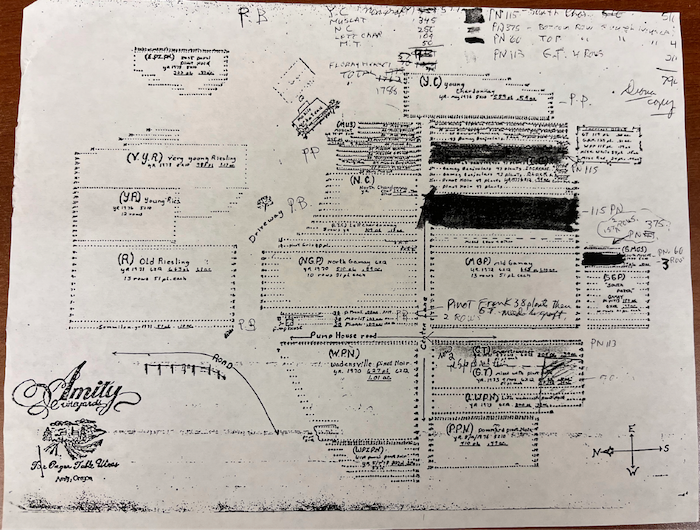
Soils: Basaltic and marine sediment. Vines: Vines were planted on a southwest-facing slope at 500’ elevation. Blocks 1B, 1C and 2 are west-facing with the remainder of wines south-to-southeast-facing. The vineyard is exposed to the Van Duzer Corridor 50 miles to the West. All vines are VSP trellised. Farming: The vineyard has been sustainably and organically farmed with no irrigation and no artificial inputs. It is certified Salmon Safe. Winery clients: None from the old vines, a monopole. Old vines bottlings: Many of the original vines from the 1970s are still producing fruit. Currently, the estate vineyard consists of 12.48 acres with 7.49 acres of Pinot Noir. The Amity Estate Single Vineyard Pinot Noir, a blend of Pommard and Wädenswil clones has been effectively an old vine bottling when the owners have chosen to produce it such as in the 2016 and 2019 vintages. Of interest: The first vintage releases from Amity Vineyards were in 1976, produced in the winery’s newly constructed winemaking facility on the estate property. Amity Vineyards won awards for Pinot Noirs from the 1978, 1979 (from Sunnyside Vineyard), 1983 and 1985 vintages. Redford has been credited with the first Upright Pinot labeled “Gamay Noir” in Oregon in 1988 but Coury bottled a “Gamay” at least as early as 1974 (See David Hill Vineyard). Redford was the first to produce a sulfite-free wine from organically grown grapes in 1990.
Hyland Vineyard
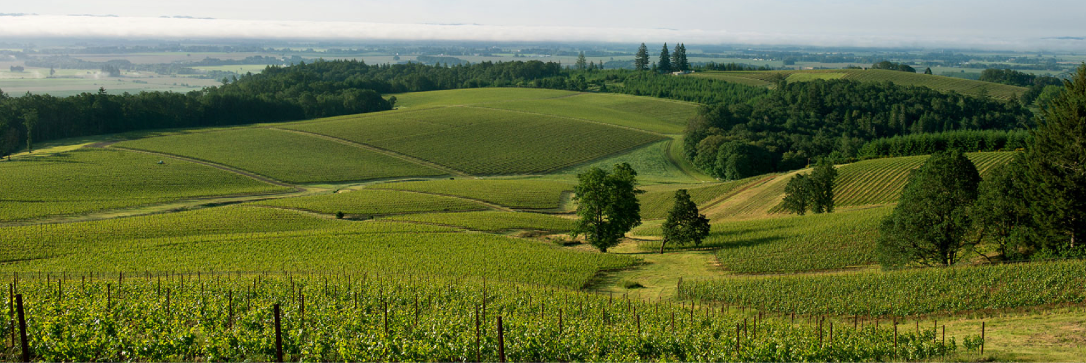
Owners: The land dates to the late 1840s when it was part of the original Oregon Trail homestead claimed by Benjamin Hyland. 150 years later, this land became the home of Hyland Vineyard when four families - the Kreimeyers, the Markleys, the Welches, and the Trehales - teamed up in 1971 to plant Pinot Noir. In 2007, the vineyard was bought by winemaker Laurent and Danielle Andrus Montalieu in partnership with John Niemeyer under the NW Wine Company banner. Location: About 7 miles south of the town of McMinnville in the McMinnville AVA. Plantings: Planting of the original 20-acres of Coury selection Pinot Noir vines at the Hyland Vineyard occurred from 1971 to 1974 (Block 3c was planted in 1973) Additional plantings of own-rooted Pinot Noir followed until 1998 including Coury selection in block 6 in 1986, Wädenswil (initially in 1979 and also in 1987), and Pommard (initially in1987). Newer plantings including Dijon clones 777, 113, 114, 115, 667, 777, and faux 828 were added initially in 2002 and later in 2007-2009. Early on, Hyland Vineyard covered 40 acres but is now 185 acres with 76 acres of own-rooted old Pinot Noir vines. Hyland vineyard has the largest planting of own-rooted Coury selection Pinot Noir in Oregon. There is also planted some Chardonnay and a small amount of Riesling and Gewürztraminer. A vineyard map is seen at the conclusion of this section below. Pinot Noir scions: Own-rooted Coury selection, Wädenswil, and Pommard, and newer Dijon clones. Soil: Uniformly volcanic Jory. Vines: The vineyard is situated in the foothills of the coastal range between 600’ and 800’ elevation with a south-facing bench.10’ between rows and 10’ between vines for the original vines. Trellising includes Ballerina/ head pruning, classic double Guyot, and a modified Geneva double curtain.
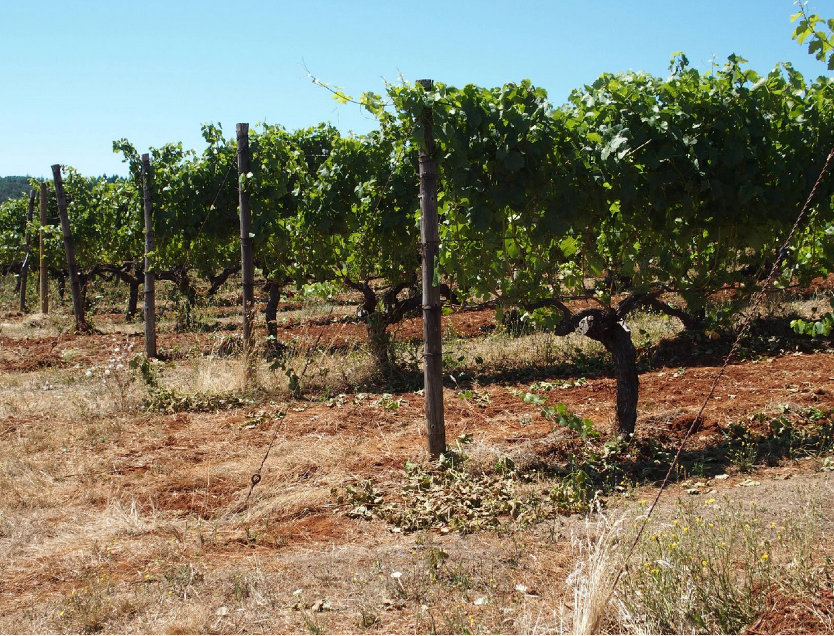
Winery clients: There have been numerous clients through the years including Antica Terra, Beaux Freres, Bergström, Clos Griotte, Cristom, Dancin’ Vineyard, Domaine Divio, Double Zero Wines, Eminent Domaine, Erath, Hyland Estates, Kelley Fox Wines, Kudos, Martin Woods, Nicolas Jay, Patricia Green Cellars, Penner- Ash, Resonance Vineyards, Robert Brittan, Sokol Blosser, Solena, Trathen Hall Wines, and Winderlea, The first wines from Hyland Estates Winery were released in 2011. Old vines bottlings: Multiple Pinot Noir old vine Coury selection bottlings from Hyland Estates including Estate Pinot Noir (Coury selection planted in 1974 and 1989), Coury Pinot Noir, Founders Selection, and Winemakers Series Pinot Noirs including Clone 95, Block 3c (planted in 1973) and Block 6 (planted in 1986). Other recent old vine clients include Antica Terra, Cristom, Domaine Divio, Double Zero Wines (Block 1P planted in 1972), Nicolas Jay, and Solena ( not all verified as 100% original planting Pinot Noir except for Double Zero which is from Block 1P planted in 1972). Of interest: The “Coury clone,” is more correctly referred to as the Coury selection but Coury clone has become part of wine parlance. It is a suitcase selection that Charles Coury brought into the United States from Colmar, France in 1964 and propagated as part of a nursery partnership with Dick Erath. To read more, visit “Solving the Mystery of the ‘Coury clone’" at www.princeofpinot.com/article/1214/.
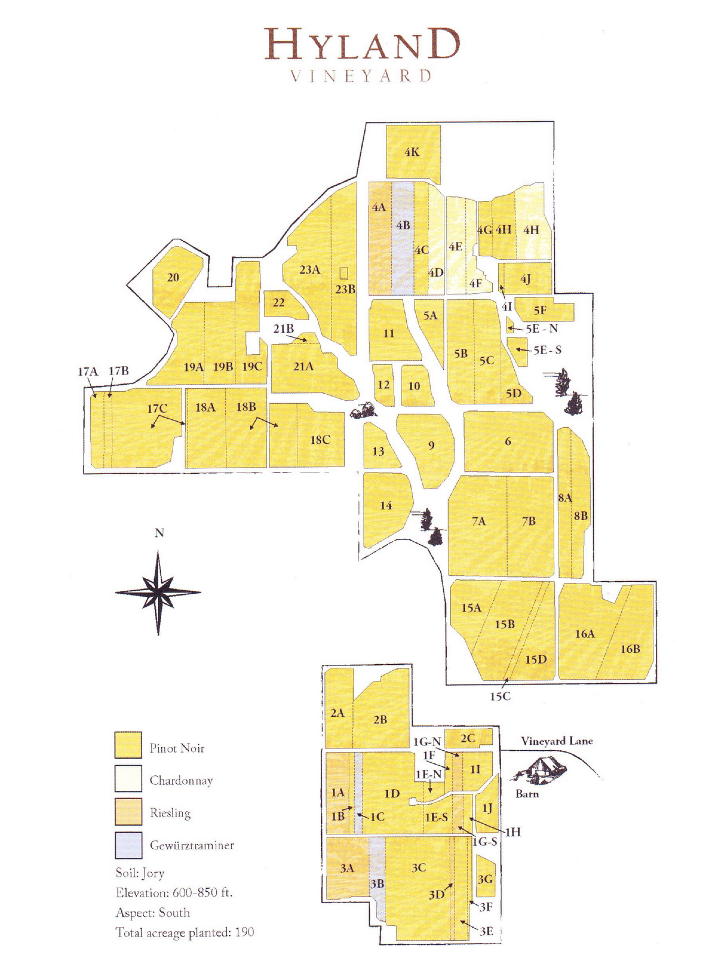
 2018 Cristom Old Vine Series Hyland Vineyard McMinnville Pinot Noir 14.0% alc., 175 cases, $45. 29% Coury selection and 71% Wädenswil clone. · Moderate garnet color in the glass. Very sexy nose with the perfume of cherry, beef spice rub, floral lift and a hint of sweet oak. Delightful on the palate with layers of well-spiced black cherry fruit flavor. Perfectly balanced, with mildly firm tannins and an infusion of refreshing acidity. The lipsmacking finish has unreal length. When tasted the following day from a previously opened bottle, the whole cluster-driven nose was in full bloom, and I could only shake my head while I drank this extraordinary wine. Score: 97
2018 Domaine Divio Hyland Vineyard McMinnville Pinot Noir 13.5% alc., 50 cases, $65. I am not sure of the vine age and clones but was submitted as an old vine bottling. · Dark garnet color in the glass. The nose opens slowly to reveal seductive aromas of forest floor, blueberries, pomegranate, white pepper, spice, and toast. Richly appointed with purple and black berry fruit flavors. Succulent and fruit-driven, with gentle power, modest tannins, a persistent finish, and overall, a charming demeanor. Score: 93
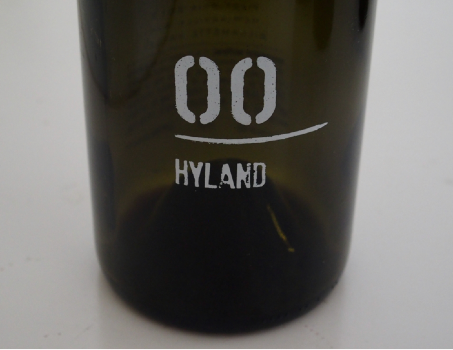 2017 Double Zero (00) Hyland Vineyard McMinnville Pinot Noir $90. Sourced from one of the oldest blocks of Coury selection Pinot Noir planted in 1972. · Light garnet color in the glass. The nose is exotic and very pleasing with aromas of fresh red cherry and berry, spice and terra cotta. The wine is a chameleon in the glass with ever-changing flavors and nuances. Light to mid-weight in style, featuring an array of red fruits backed by a grip of bright acidity, and superb harmony. The wine really holds on to the finish. Still exceptional when tasted the following day from an opened bottle. This wine grows on you. Score: 95
2012 Hyland Estates Founders Selection One Barrel Hyland Vineyard McMinnville Pinot Noir 13.8% alc.. · Moderate garnet color in the glass. Nicely perfumed with scents of black cherry, raspberry puree, tilled earth and toasty oak. Mid-weight plus in heft, with a rich core of black cherry fruit with hints of spice and rare beef. The still-evident tannins led to a bit of astringency on the finish that had good but not exceptional length. Score: 92
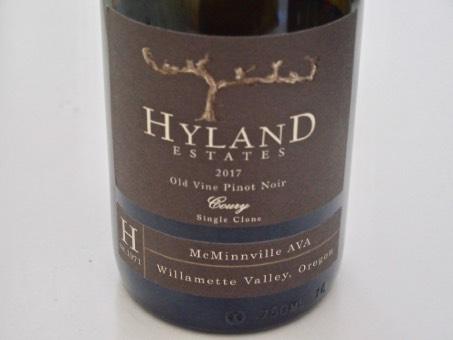 2017 Hyland Estates Coury Clone Hyland Vineyard McMinnville Pinot Noir 13.3% alc., $64. · Moderately light garnet color in the glass. This wine aims to please in every way. The nose is highlighted by aromas of revered cherry, spice, sandalwood, and even a whiff of white stone fruits. Moderately light in weight, with a stream of deep cherry and strawberry fruit goodness. Both appealing grace and refinement with a generous red cherry-driven finish. Nothing beats that old vine character. Score: 94
2018 Hyland Estates Coury Clone Hyland Vineyard McMinnville Pinot Noir 14.1% alc., $60. A limited barrel selection from own-rooted vines in the oldest blocks of the vineyard. · Moderately dark garnet color in the glass. Terrific nose kicks off the pleasure with aromas of dark red cherry, blackberry, spice cabinet and tilled earth. Earth-infused with plenty of umami, this mid-weight plus wine delivers loads of sweet black cherry and blackberry fruit flavors with a shade of oak. A joyous wine. Score: 94
2019 Hyland Estates Coury Clone Hyland Vineyard McMinnville Pinot Noir 13.3% alc., $60. · Moderate garnet color in the glass. Aromas of dark cherry, black raspberry and confected purple grapes are appealing. A black cherry cola delight with balanced tannins and a glorious 45-second quenching finish. Full of well-ripened fruit but discreetly composed. Still attention-grabbing when tasted the following day from a previously opened bottle. Still young and most certainly will go the distance. Score: 94
2018 Hyland Estates Founders Selection Hyland Vineyard McMinnville Pinot Noir 14.1% alc., $110. A blend of the four best barrels of the vintage. An historic selection from vines in the founding vineyards. · Moderately dark garnet color in the glass. Initially reserved aromas that open gradually over time revealing rilled earth, mulch, purple berry and spiced cherry aromas. A big gulp of black cherry and blackberry fruits assembled in a mid-weight plus style. Riper and darker fruited in character but with gentle power. Impeccable harmony with a very long, sweet-fruited finish. This wine deserves a few years in the cellar and will prove very age worthy. Score: 94
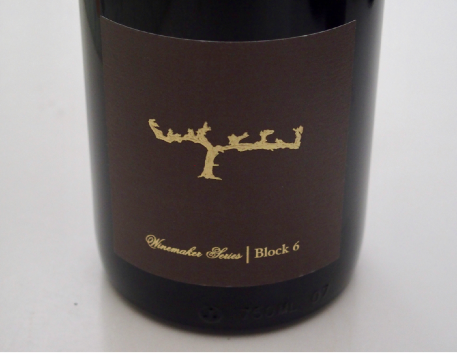 2017 Hyland Estates Block 3c Winemakers Series Hyland Vineyard McMinnville Pinot Noir 13.6% alc., $72. · Moderately light garnet color in the glass. Alluring aromas of dark cherry compote, potpourri, and ripe strawberry. Instantly enjoyable, with an appealing juiciness. A soft, gregarious mouthfeel satisfies as does the mid-weight core of vivid cherry fruit. Almost ephemeral, with fine-grain tannins and a lengthy, red cherry-driven finish. Score: 95
2017 Hyland Estates Block 6 Winemakers Series Hyland Vineyard McMinnville Pinot Noir 13.7% alc., $78. · Light garnet color in the glass. A combination of red cherry, potpourri and baking spice aromas lead the way. Exotic and elegant in a lighter-weighted style offering flavors of earth-blessed cherry, wild strawberry and red licorice. A shade of oak and congenial tannins are complimentary. The finish is suave and lengthy. Score: 93
Sokol Blosser Estate Vineyard
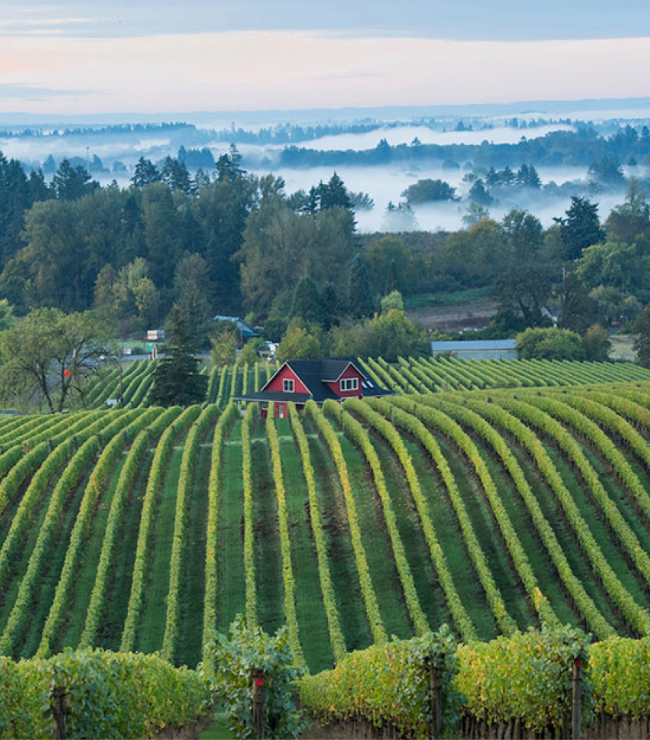
Owners: 1966 Stanford graduates Susan Sokol and Bill Blosser first planted grapes in the early 1970s and Sokol Blosser Winery was founded in 1977. Since 2008, second-generation siblings, Alex and Alison Sokol Blosser, are a the helm. Alex became vineyard manager in 2006 when his mother retired and moved on to head winemaker in 2014 when long-time winemaker Russ Rosner retired. Alison is the CEO and head of sales and marketing. Both Alex and Alison hold the title of co-president. Location: West of Highway 99W in Dayton in the Dundee Hills AVA of the Willamette Valley. Planting: In 1970, the Sokol Blossers purchased land in the Dundee Hills that was a former prune orchard. In 1971, they cleared their land and planted wine grape cuttings in a nursery row. The first 2-acre block of Pinot Noir was planted in 1972. The initial planting also included 1 acre of Müller-Thurgau, 1 acre of Chardonnay and 1 acre of White Riesling. Planting ensued during the early 1970s. The entire vineyard was replanted from 1998-2009 due to phylloxera. The original section of the vineyard planted to Pinot Noir were replanted in 2007 and 2009 using cuttings taken from the original fruiting vines and grafted onto phylloxera-resistant rootstock for the replant. Currently, there are 89 acres of vines on the 128 acres of estate property. 72 acres are planted to Pinot Noir with small amounts of Pinot Gris, Riesling, Chardonnay and Müller-Thurgau. Dijon clones 115, 667 and 777 and Pommard were added to the vineyard in 2001.
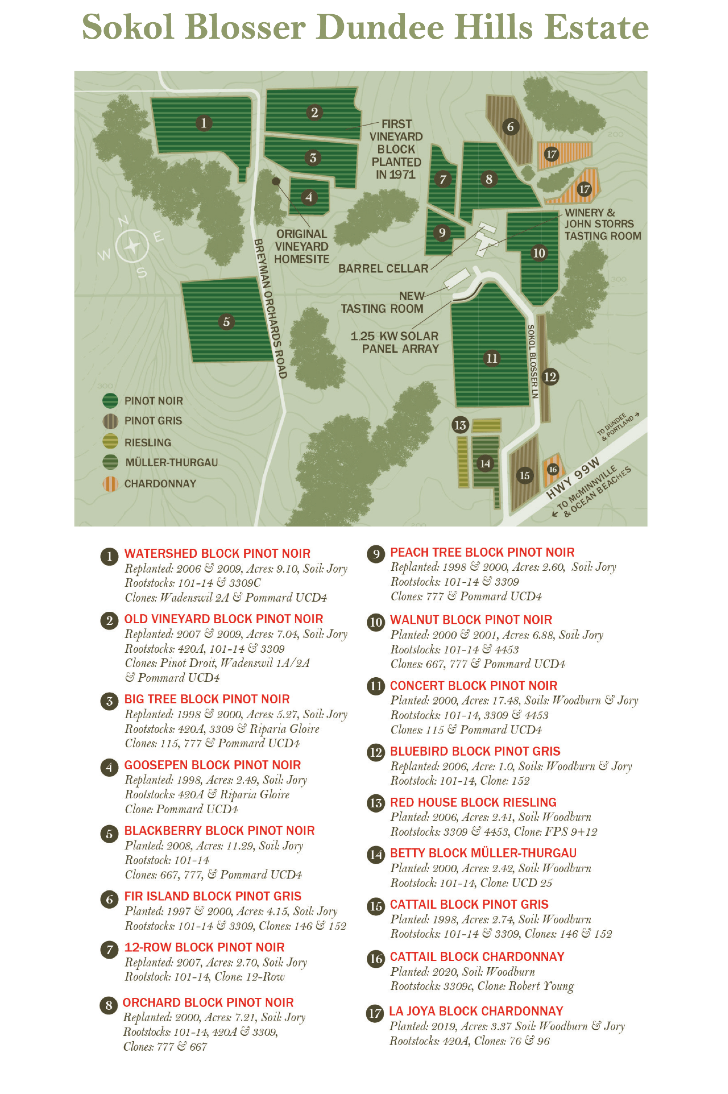
Soil: Red, volcanic Jory. Vines: Original vine spacing was 20’ x 6’. The vineyard is at 200’-450’ elevation. Farming: USDA organically certified in 2005, and also LIVE, and Salmon-Safe. The first Oregon winery to be certified Salmon-Safe. The winery is currently at the vanguard of mechanical harvesting of Pinot Noir in Oregon. Winery clients: None, a monopole. Old vines bottlings: The Twelve Row Estate Pinot Noir is based on one of the original sites planted in the early 1970s. The family thought they were sold a Pommard clone but it turned out to be an atypical clone of Pinot Noir that has not been identified but may be a Martini clone. The Watershed Block Estate Pinot Noir is from a section of the vineyard planted by the founders in the early 1970s. It was replanted in 2006 and 2008 using cuttings taken from the original plantings of Wädenswil 2A and Pommard 4 and grafted onto rootstock. The Old Vineyard Block Estate Pinot Noir is produced from fruit harvested from the initial section of the vineyard planted by the founders. It was replanted in 2007 and 2009 using cuttings taken from the original plantings of Wädenswil 1A and 2A, Pommard, and Upright Pinot and grafted onto rootstock for the replant. Of Interest: I graduated from Stanford the year before (1965) the Sokol Blossers did but I don’t recall knowing them. It was, however, the Stanford connection that led me to stop in at Sokol Blosser in the early 1980s, the first Oregon winery I ever visited. The winery is celebrating its 50th Anniversary.
2018 Sokol Blosser Watershed Block Estate Dundee Hills Pinot Noir 14..2% alc., 350 cases, $85. Pommard and Wädenswil clones. Aged 30 months in French oak barrels. · Dark garnet color in the glass. Aromas of blackberry, dark chocolate, muddy earth, and toasty oak. A robust wine in a mid-weight plus style donating a big mouthful of beautiful boysenberry, blackberry and black raspberry fruit flavors backed by plenty of winter Wassail spice and a noticeable compliment of oak. Very silky on the palate with a lengthy finish. A sense of alcohol peeks out as the wine warms in the glass. When tasted the following day from a previously opened bottle, more rustic oak was evident in the background. Score: 91
2018 Sokol Blosser Twelve Row Block Estate Dundee Hills Pinot Noir 14.0% alc. 400 cases, $85. A section of the vineyard planted to 11 rows of Pinot Noir and 1 row of Riesling, Expanded to 36 rows in 2007. Martini clone. · Moderately dark garnet color in the glass. A chameleon in the glass with a range of aromas including boysenberry, plum, mocha java, tilled earth, and terra cotta. Gentle richness on entry with layers of purple and black fruits that are vivid and juicy. Impeccable harmony with modest supportive tannins and oak, and a sleek, persistent finish that goes on and on. Still pumping out considerable fruit goodness when tasted the following day from a previously opened bottle. Score: 95
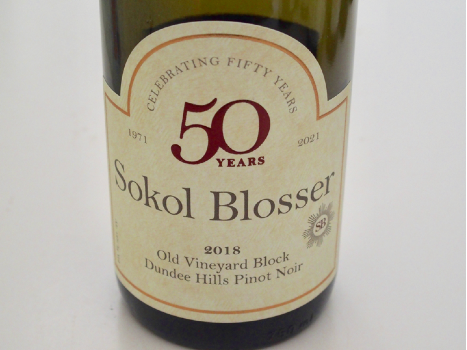 2018 Sokol Blosser Old Vineyard Block Estate Dundee Hills Pinot Noir 14.0% alc., 500 cases, $60. This wine celebrates 50 years,1971-2001, as well as a tribute to the founders. · Moderately light garnet color in the glass. Initially reserved nose, opening beautifully over time to reveal enticing aromas of dark red cherry, dark strawberry, baking spices and sandalwood. Very elegant with tender power in a mid-weight style offering flavors of dark red cherry, raspberry and strawberry fruits. Firm, supportive tannins with a sexy, silky texture. The finish is extraordinarily long and generous. A superb wine in every way and a fitting tribute to 50 years. Score: 96
Oak Knoll VineyardOwners: Rob and Marjorie Vuylsteke founded the Oak Knoll winery in 1970, the first winery in Washington County. They started with a 5-acre property that had previously been the Oak Knoll Diary. Various members of the family have had partial ownership and involvement in the company through the years including head winemaker Jeff Herinck (a cousin), step-son Greg Lint, and son Steve Vuylsteke. The family still has some ownership in the winery. Location: Tualatin Valley in Hillsboro, Washington County in the Chehalem Mountains AVA. Planting: Initially, the family sourced grapes for wine production and the first vintage of Pinot Noir was 1973. According to Steve Vuylsteke, a vineyard was planted on the property in the 1970s that included cuttings of Pinot Noir sourced from Richard Sommer at HillCrest Vineyard. The low elevation of the vineyard led to repeated grape frost damage and the vines were eventually pulled out. Pinot Noir Scion: Uncertain. Old vines bottlings: None. Of Interest: By the mid-1980s, Oak Knoll Winery became well known for Pinot Noir. In 2006, the winery was the largest in Washington County with an annual production of 30,000 cases. According to Steve Vuylsteke, Pinot Noir was sourced from a number of vineyards in the early years and they are listed chronologically here: DION Vineyard (starting with a small crop in 1974), Hubris Vineyard (a small vineyard planted by Ken Moyle located not far from Cooper Mountain Vineyard), Bangsund Vineyard (planted by John Bangsund in the Hood River area - some of the Pinot Noir from Bangsund Vineyard went into the 1980 vintage of Oak Knoll Winery Pinot Noir and this was anointed by Andre Tchelistcheff, a judge at the 1983 Oregon State Fair Wine Competition, as “one of the finest Pinot Noirs he had ever tasted.”), Shafer Vineyard Cellars, Beran Vineyard (now Ruby Vineyard), Van Schepen Vineyard (now Blizzard Wines), Cooper Mountain Vineyard (before they started their own winery), Weber Vineyard (began purchasing Pinot Noir from owner Art Weber in the early 1980s), and Wirtz Vineyard (purchased Pinot Noir from dave Wirtz in the early 1980s). There were no formal leases with only handshake agreements.
Bangsund VineyardsOwner: John Bangsund Location: Columbia Gorge AVA, 20 miles east of The Dalles Plantings: Initial plantings including own-rooted Pinot Noir in the “1970s.” The Pinot Noir block is 1.5 acres and still productive. The upper blocks of Cabernet Sauvignon and Syrah are planted across the hillside on terraces with split canopies. There is also a small block of Riesling lower than the Pinot Noir blocks. The vineyard has a total of 15 acres. Pinot Noir scion: Stock cuttings of unknown clones gathered from Henderson’s Vineyard in Washington. The cuttings were cleaned and rooted before planting. Vines: The Pinot Noir block of 1.5 acres is planted to 9’ x 8’ spacing. The vines have been cut back and regrown from the crown a couple of times due to winter damage. Currently, two trunks are being trained into a V shape with the head of each trunk fastened to the fruiting zone trellis wire about 4 feet apart with a 2-foot lateral arm in each direction from each head. The vineyard aspect for the Pinot Noir block is from northeast to southeast at 400' - 500' elevation. Farming: The vineyard is drip-irrigated and fertilized by ground or foliar depending on soil, leaf or petiole tests. Winery clients: Bangsund Vineyards supplied Pinot Noir grapes to Oak Knoll during the 1970s. More recently, clients for all vineyard grapes included Cathedral Ridge, Marchese, Hood Crest, Flerchinger Vineyards (owned by Cathedral Ridge), Ovum Wines and some home winemakers. Old vines bottlings Cathedral Ridge Winery in Hood River is known for bold, red Oregon wines but produced a Bangsund Vineyard Reserve Pinot Noir from old vines in some vintages (at least 2011 and 2016).
Vineyards Established 1972-1973
1972
Archibald Vineyard/Arcus Vineyard
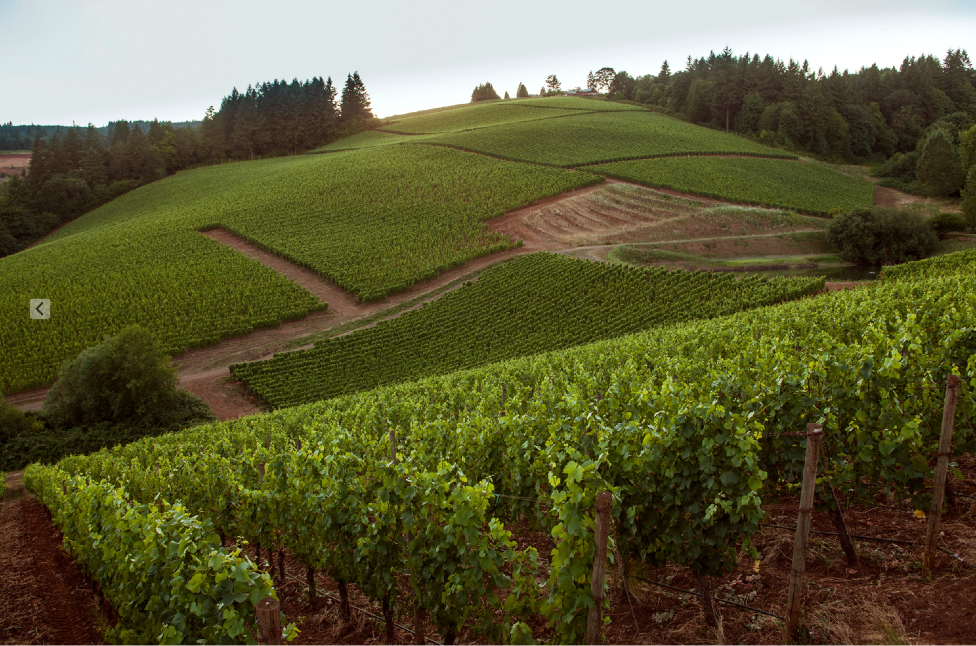
Location: Dundee Hills in the Dundee Hills AVA Planting: Originally there were 4 to 5 acres at Archibald Vineyard that included own-rooted Pinot Noir “Pommard” stock from Coury’s nursery but turned out to be a strange mix of varieties. The first planting has been dated to 1972 but Archery Summit dates the vineyard to 1973. There are currently 1.85 acres left of the Archibald Block Pinot Noir, located in the northeast corner of the Arcus vineyard. It is Archery Summit’s oldest productive vines and the winery’s flagship parcel. Currently, Arcus vineyard spans 39.84 acres planted over the 1972(3) to 2000 year time span. Pinot Noir scions: Archery Summit Estate refers to the Pinot Noir clone/selection in the former Archibald Vineyard as Pommard. Arcus Vineyard contains faux 828, 777, 115, 667, 114 and Pommard clones. Soil: Volcanic Jory. Vines: The Archibald plantings were in a steep, bowl-shaped aspect with south and southwest facing vines. The Arcus Vineyard hassoutheast, south, southwest and west exposures at 260’-620’ feet elevation. Old vine bottlings: The grapes from the Archibald Block at Arcus Vineyard are typically blended into the Arcus Vineyard Cuvée Pinot Noir, but are sometimes bottled separately such as in 2018 for the winery’s 25th Anniversary. The wine is said to always be a standout and exhibits a very complex and ethereal quality. Cristom Old Vine Series Arcus Vineyard Pinot Noir was produced beginning with the 2018 vintage but it is unclear the age of the vines used in this wine.
Breaker Vineyard
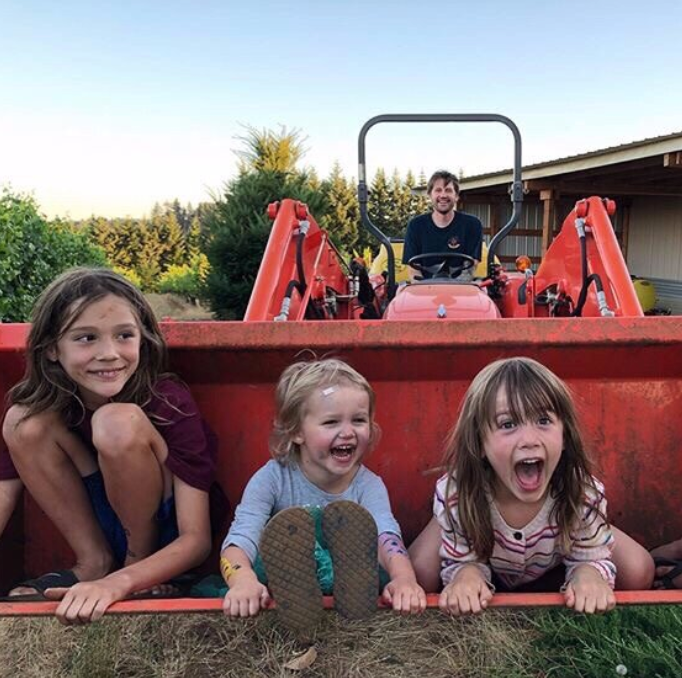
Location: A hillside atop Walnut Hill Road in the Eola-Amity Hills AVA. Planting: The inaugural planting of 4 acres in 1972 was done using cuttings from Erath. The eastern half of the vineyard was planted to own-rooted Pommard clone and the western part was originally planted to the Draper clone of Chardonnay and later grafted to Dijon clone 777. In March 2020. Hundred Suns began removing vines suffering from phylloxera infestation and replanting was initiated in the spring of 2022. 2019 was the last vintage of Breaker Vineyard Pinot Noir from the original plantings. Pinot Noir scion: Own-rooted Pommard. Soils: Weathered basalt, Nekia and Gunderman soil series. Vines: Slight southeast exposure on a windswept, rocky hill at 545-590’ elevation. Farming: The vineyard has always been farmed organically. Winery clients: None, a Hundred Suns monopole. Old vines bottlings: The Hundred Suns Eola-Amity Hills Pinot Noir is a blend of grapes from Breaker Vineyard and a neighboring vineyard planted in 2008 to Pommard and 667 ($45). The Hundred Suns Breaker Vineyard Pinot Noir old vines was last produced in the 2019 vintage ($55). Of interest: Grant Coulter worked as an assistant winemaker at Hamacher Wines and then spent most of ten years as an assistant winemaker and then winemaker at Beaux Freres and later Flaneur Wines.
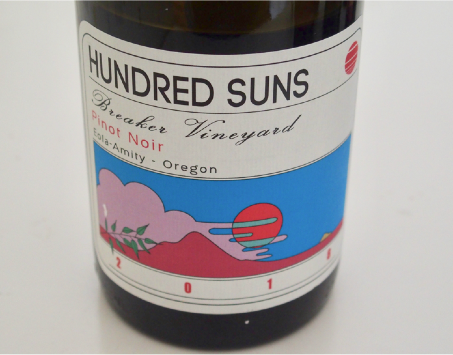 2018 Hundred Suns Breaker Vineyard Eola-Amity Hills Pinot Noir 14.0% alc., $55. Yields 1 ton-per-acre. Part destemmed into a small open-top fermenter. and part whole cluster put into a 500L amphora and left untouched for 19 days. Native yeast fermentation. Bottled unfined and unfiltered. · Moderately dark garnet color in the glass. Very fruity nose with aromas of blueberry and blackberry. Saucy blue and black berry fruit flavors in a mid-weight plus style framed by congenial tannins and friendly acidity. Good length to the finish that tails off with modest dryness but is not dried out. Score: 93
2019 Hundred Suns Eola-Amity Hills Pinot Noir 13.2% alc., $45. Sourced from two vineyards: Breaker Vineyard and a neighboring vineyard owned by Joe and Marilyn Merritt that was planted to Pommard and 667 clones in 2008. Fermented with native yeast, 30% whole cluster, and aged on the lees for 11 months. Bottled unfined and unfiltered. · Moderately dark garnet color in the glass. The nose is instantly alluring upon opening with loads of cherry aroma along with scents of nutmeg, gingerbread and mulch. Easy going in a mid-weight style featuring the essence of classic Pommard black cherry flavor along with tastes of purple grape and spice. Very user friendly with suave tannins, frisky acidity and a mildly dry finish. Score: 93
2019 Hundred Suns Breaker Vineyard Eola-Amity Hills Pinot Noir 13.4% alc., $55. Last of two vintages from this vineyard. Some grapes were placed in sealed tanks untouched and others were de-stemmed into open-top tanks and fermented with natural yeast. · Moderately dark garnet color in the glass. A complex nose with aromas that really come at you including blueberry-pomegranate, menthol, rose petal and tilled earth. The core of black cherry and blueberry fruits are framed by noticeable but not foreboding tannins. There are added flavors of black tea, dried herbs and umami. A darker-fruited expression of Pommard that should spend time in the cellar or be decanted to soften the tannins. Score: 92
Cattrall Brothers Vineyards
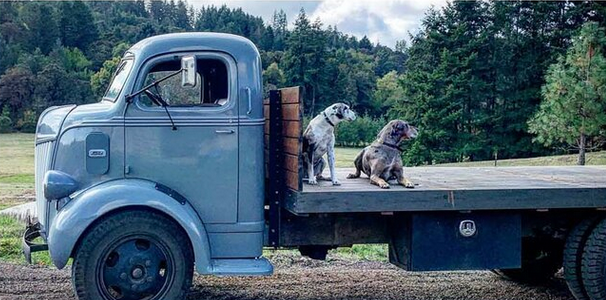
Location: Eola-Amity Hills AVA. Plantings: Bill’s Vineyard is 5.5 acres planted from 1972-2008. Initially, the cuttings were from David Adelsheim and included own-rooted Wädenswil Pinot Noir, Upright Pinot, Pinot Gris and Muscat. Tom’s Vineyard is 3 acres planted in 1983 to own-rooted Wädenswil clone Pinot Noir. Pinot Noir scion: Own-rooted Wädenswil and an Upright Pinot. Soils: Well-draining, medium depth, ancient basaltic soils. Vines: The vines are planted on a north-facing slope with direct exposure to the Van Duzer Corridor at 750’ elevation. Farming: Bill and Tom have worked together to organically farm their vineyards since the 1970s. In 1990, the vineyards became Oregon’s first organic vineyards certified by Oregon TILTH. Winery clients: Big Table Farm (Tom’s Vineyard), Ransom, The Eyrie Vineyards, and The Great Oregon Wine Company. Old vines bottlings: The 2018 Great Oregon Wine Company Cattrall Vineyard Pinot Noir contained grapes from own-rooted Wädenswil Pinot Noir planted in 1973 and 1979 (Bill’s Vineyard). A 2015 Ransom Cattrall Vineyard Pinot Noir was also sourced from own-rooted Wädenswil plus an Upright Pinot clone planted in 1973 and 1979. Big Table Farm Cattrall Brothers Vineyard Pinot Noir has been produced from half of Tom’s vineyard since 2009. Of interest: The Big Table Farm bottlings have an illustration on the front label of the Cattrall Brothers 1946 Ford cabover flatbed truck drawn by Big Table Farm co-owner Claire Carver.
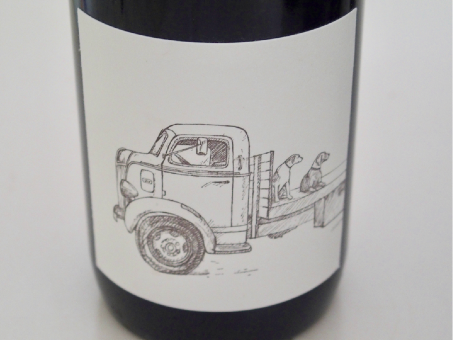 2019 Big Table Farm Cattrall Brothers Vineyard Eola-Amity Hills Pinot Noir 12.1% alc., 134 cases, $68. Bottled unfined and unfiltered. · Moderately light garnet color in the glass. The pleasant nose is more savory than fruity with aromas of forest floor, bramble, nutmeg and cranberry. Lighter in character, with smoky red cherry and cranberry flavors. Acid-driven, with calm tannins, and a tart finish that is quenching and noticeably long. Score: 92
Eola Springs VineyardOwner: The original owners were Dennis and Thelma Psoau. In 2015, the vineyard was purchased by Geodesy Wine owned by Judy Jordan, former owner of J Vineyards & Winery. Location: Just outside of Salem in Rickreal in the Eola-Amity Hills AVA. Plantings: 70 acres of own-rooted Pinot Noir, Zinfandel and Cabernet Sauvignon were originally planted in 1972 by Carl Stevens. 1.14 acres of the original plantings of Pinot Noir, now designated Block A2, is still in production. There is a block called the Ghost Block that was left for dead but is now producing grapes again but is only 10-15 vines. Block A9, planted in 1980, consists of 4.78 acres believed to have been sourced from Block A2. There are two other blocks of Pinot Noir have been torn out due to trunk disease. Today, the vineyard consists of 49 acres with 52 acres in development. Varieties besides Pinot Noir include Chardonnay, Pinot Gris and Muscat. Planting occurred in the years 1972, 1980, 1990, 2006, and is continuing today.
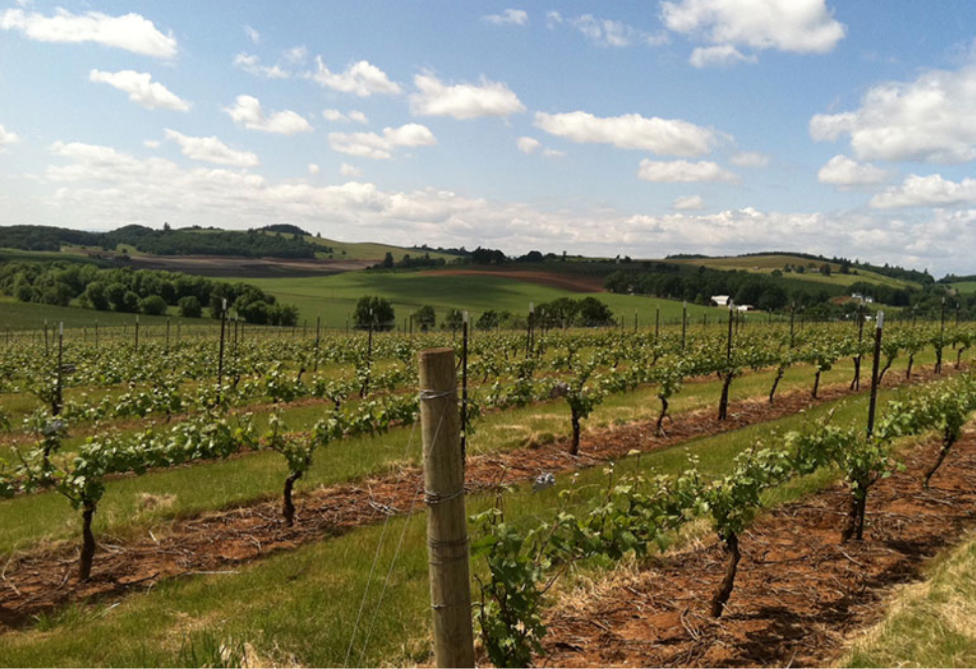
Soils: Sedimentary with transitions to volcanic Jory on the upper terrace. Vines: The 1972 Block A2 has 10’ x 7’ vine spacing and the 1980 A9 block has 12’ x 8’vine spacing. The aspect is gradually sloping west with some southwest-facing rows at 300 - 450’ elevation. Farming: Non-irrigated and sustainably farmed. Winery clients: The old vine Pinot Noir fruit is being sold and there are some blocks that may have been put into a vineyard-designate (although I found no recent vintage examples). Clients have included Averean Wines, Cristom Vineyards, Division Wine Cellars, and Minimus (Craft Wine Company). The Geodesy Eola Springs Vineyard Pinot Noir is a blend of differently-aged vines in the vineyard. Old vines bottlings: None confirmed.
Knudsen Vineyard
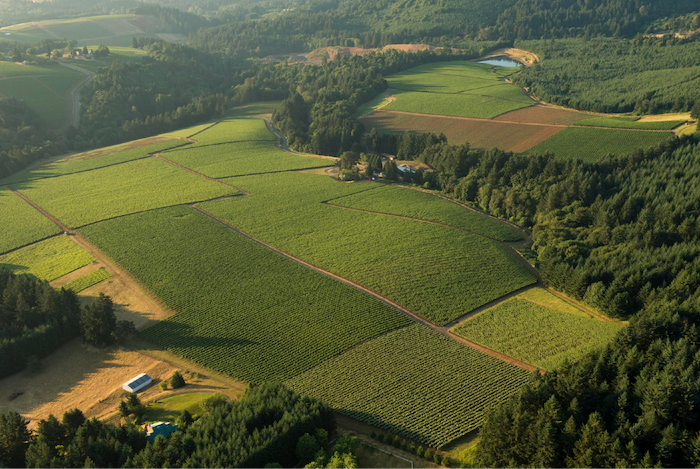
Location: On NE Worden Hill Road in the middle of the Dundee Hills AVA. Planting: Initial planting was in 1974 (Block 2). In 1980, the entire block was interplanted changing the spacing from 9’ x 9’ to 9’ x 4.5’. Currently, Block 2 is 10.86 acres.
Soil: A volcanic mosaic of shallow and rocky benches and slopes formed over many millennia from
innumerable lava flows (red, volcanic Jory loam).
Vines: The original vines are southeast-facing at 900’ elevation (the entire vineyard ranges from 500’ to 1000’
elevation.
Farming: The entire vineyard was retrofitted with drip irrigation in every row in 1988 and 1990. LIVE certified
and Salmon Safe. The vineyard manager is Mark Sheridan.
Winery clients: Argyle
Old vine bottling: Argyle produces a Knudsen Vineyard Brut Sparkling Winesourced exclusively from
Block 2 at Knudsen Vineyards. Knudsen Vineyards produces Pinot Noir with fruit from Block 2 in the blend but
not as a stand-alone wine. Another producer is scheduled to craft wine from Block 2 for the first time from the
2021 harvest.
Of interest: The Knudsen Vineyard now encompasses 130 planted acres, 73% of which isPinot Noir, with a
mix of older vines and newer, high-density blocks planted to Dijon clones in the 1990s. The Knudsen Vineyards
Winery was launched in 2013 with a Pinot Noir from the 2012 vintage.
2016 Argyle Knudsen Vineyard Dundee Hills Brut Sparkling Wine
12.5% alc., 932 cases, $50. 100% Pinot Noir from 42-
year-old Pommard vines. Harvest Brix 19º. Barrel aged in
mature oak. Disgorged in March 2020 followed by dosage of
0.5% residual sugar.
·
Platinum color with a tinge of pink in the
glass. Lovely aromas of white peach, lime, lemon zest and
subtle yeast. Focused flavors mimic the nose. A cheerful, dry
wine with good mousse, excellent crispness and a refreshing
finish of excellent length. This wine should hold its own over
several more years.
Score: 93
Location: On NE Worden Hill Road, ¼ mile from Winderlea Vineyards & Winery.
Pinot Noir scion: Own-rooted Pommard clone.
Soil: Volcanic Jory.
Vines: South-sloping parcel at 400’-502’ elevation. The initial 1972 planting had 10’ row spacing.
Farming: Transitioned to organic farming in 2019 while working towards organic certification. No-till farming.
Winery clients: Arterberry Maresh, Winderlea.
Old vines bottlings: None strictly from original plantings.
Location: On Worden Hill Road in the Dundee Hills AVA
Planting: Initial planting of 8.8 acres of own-rooted Pommard Pinot Noir, Chardonnay, and Riesling between
1972 and 1974. Now a 10-acre site, with 5.2 acres of Pinot Noir, including some Dijon 114, 1.5 acres of
Riesling (Geisenheim 110), 1.6 acres of Chardonnay (Draper selection), and .5 acres of Pinot Gris.
Pinot Noir scion: Own-rooted Pommard.
Soil: Volcanic Jory, Gelderman, and Rittner.
Vines: Primarily south-facing at 580’-680’ elevation and a 9.7% slope. 9’ between rows.
Farming: Organic since 1999 and biodynamic since 2006. Dry-farmed
Winery clients: Et. Fille and J. Christopher.
Old vines bottlings: Holloran Vineyard Wines Le Pavillon Pinot Noir is listed as produced recently in 2014,
2016 and 2017.
Of interest: From a release of 500 cases of Pinot Noir, Riesling and Chardonnay in 1999, the winery and
vineyards have been expanded as has the case production that is now between 5,000 and 6,000 cases. Mark
La Gasse has been the winemaker since 2005.
2014 Holloran Le Pavillon Dundee Hills Pinot Noir
13.7%
alc., $45.
·
Moderate garnet color in the glass. A slightly
confected nose offers aromas of cherry pie and sandalwood.
Light to mid-weight in style, featuring a bright core of dark red
and blue berries backed by fine tannins and juicy acidity.
Discrete, without overreaching, exhibiting Pinot’s gracefulness.
Quintessential Dundee Hills character.
Score: 93
Location: Worden Hill Road in the Dundee Hills AVA.
Planting: The initial planting of 10.19 acres in 1972 included Pinot Noir, Upright Pinot, Chardonnay, Riesling,
Muscat, Pinot Gris, and Sauvignon Blanc. Own-rooted vines were obtained from Erath and Coury. Currently,
the vineyard has 6.5 acres of Pinot Noir still in production with 1 acre of Pinot Gris. In 2002, 1.7 acres of
Chardonnay were grafted to 667 and a small planting of Upright Pinotwas grafted to 114.
Pinot Noir scions: Own-rooted Pommard, Wädenswil, Upright Pinot, and Coury selections.
Soil: Volcanic Jory.
Vines: South-facing at 815’ elevation. Spacing is 9’ x 6’ with a double Guyot trellis (VSP).
Farming: Organic and LIVE certified.
Winery clients: None, a monopole.
Old vines bottlings: Torii Mor Olson Estate Vineyard Pinot Noir is a blend of old vine Coury selection,
Pommard, Upright Pinot, and Wädenswil, and Dijon 667. A Torii Mor Olson Estate Vineyard Old Vine
Reserve Pinot Noir ($125) is from 100% original own-rooted vines is also available. The 2018 vintage is in
production and will be offered soon.
Location: Chehalem Mountains AVA.
Planting: Block 1, 2.39 acres, remains the original plantings from 1972, but the remainder of the vineyard has
been replanted. The entire vineyard is now 14.83 acres and includes Pommard UCD 5, AS-2 selection and
QM-1 along with Dijon 667, 777 and 4407 selections of Pinot Noir, and Dijon clone 76 Chardonnay.
Vines: South-facing at 560’-680’ elevation. 9’ x 6' spacing, VSP trellis.
Farming: LIVE certified and Salmon Safe.
Winery clients: None, a monopole.
Old vines bottlings: Adelsheim Quarter Mile Lane single-vineyard Pinot Noir wines are sourced from the
original Block 1. To celebrate Adelsheim’s 50th Anniversary, the winery released 140 collectible magnums from
the 2019 vintage with a special commemorative label called “The Deed”. The wine was crafted by Gina
Hennen who claims, “It is unlike any other wine we have made before.” The label design is inspired by the
original Land Deed from 1971. The wine is sourced exclusively from the oldest vines at Block 1 of Quarter Mile
Vineyard. The wine was released in June 2021 and sold for $300.
2017 Adelsheim Quarter Mile Lane Vineyard Chehalem Mountains Pinot Noir
13.5% alc., $125.
·
Light ruby color in
the glass. Gracious aromas of red cherry, strawberry,
sandalwood and sous-bois building in intensity over time in the
glass. Lighter weighted with gentle power, featuring flavors of
red berry and cherry fruits with a savory herbal note. The
discreet fine tannins partner with a satisfying juicy grip of
acidity on the finish that is of generous length.
Score: 93
Owners: Harvey Shafer planted Pinot Noir in Forest Grove in 1972. In late 1978 (also reported as 1981),
Shafer ceased selling his grapes and began making his own wine under the Shafer Vineyard Cellars label. He
became well known for growing quality Pinot Noir. Dr. Robert Risdall and his son Emery Risdall moved from
Northern California in 2015 to purchase Shafer Vineyard Cellars from then-owners Jerry and Miki Kramer. The
vineyard was renamed Risdell Ranch. Dr Risdall became ill in 2017 and the winery was closed permanently in
December 2018.
Location: Just northwest of Forest Grove in the Tualatin River Valley (now the Tualatin Hills AVA).
Planting: Shafer planted the first own-rooted Pinot Noir and Upright Pinot vines in 1972 on a slope once used
for strawberry cultivation. He eventually added Sauvignon Blanc, Müller-Thurgau, Gewürztraminer, Riesling,
Chardonnay, and Pinot Gris. The vineyard grew to 30 acres.
Pinot Noir scions: Unknown.
Soil: Silty clay loam
Vines: Southwest exposure at 350’ elevation.
Farming: Dry-farmed and sustainably worked by the Risdall family.
Winery clients: Fossil & Fawn, Maloof Wines, Stedt Wines (Pinot Gris) and Stoller Family Estate. Melissa
Burr, Vine President of Winemaking at Stoller Family Estate in Dayton, began purchasing grapes from the
Risdalls in 2016 for the winery’s line of History wines made from
historic vineyards in Oregon and Washington.
Old vines bottling: Stoller Family Estate History Pinot Noir.
2017 History Risdall Ranch Vineyard Willamette Valley Pinot Noir
14.2% alc., 61 cases, $55.
·
Light garnet color in the
glass. Aromas of black cherry, tilled earth and bright roseate
scent. Very silky on the palate with an array of delicious flavors
including red cherry, red raspberry, strawberry, cola, spice, and
a shadow of oak. Impeccable harmony with gossamer tannins
and an extremely long finish. A real old vine treasure.
Score: 94
Hinman Vineyards
Location: Eola-Amity Hills AVA.
Planting: Byard and his family planted 5 acres of own-rooted Pommard clone Pinot Noir and 5 acres of
Riesling in 1973 to 1974 followed by 0.9 acres of Pinot Gris in 1979. Another 9 acres of Dijon clones 777 and 115
followed in the late 1990s on grafted rootstock. Byard’s label was Hidden Springs. Currently, there are 18.5
acres of vines including 13.5 acres of Pinot Noir (the original Pommard plus Pommard, 115, and 777 planted
on rootstock in the late 1990s). There has been limited vine replacement plantings.
Pinot Noir scion: Own-rooted Pommard.
Soil: Volcanic Jory and Nekia series.
Vines: Southeast-facing parcel at 650’-750’ elevation with a modest slope. 9’ x 5’ spacing was laid out
originally. VSP trellis.
Farming: Converted to biodynamic farming between 2002 and 2004 and certified Demeter® in 2012. Jessica
Cortell of Vitis Terra Vineyard Services farms the site.
Winery clients: None, a monopole.
Old vines bottlings: Brooks Wine Old Vine Pommard Pinot Noir
Of interest: Pascal Brooks inherited the winery at the age of eight when his father, Jimi Brooks, unexpectedly
passed away. Pascal currently resides in France where he has worked on several harvests and is devoted to
greening projects. Janie Brooks Heuck (Jimi’s sister) is the current Managing Director of Brooks Wine. Chris
Williams, a friend of Jimi’s since the 1990s, has been the winemaker since 2005. I have tasted the range of
Rieslings from this winery and can highly recommend them. Winemaker Chris Williams is a Riesling aficionado.
2017 Brooks Old Vine Pommard Eola-Amity Hills Pinot Noir
13.5% alc., 300 cases, $60. Sourced from the original 1973
plantings of own-rooted Pommard clone located in the heart of
the Brooks Estate Vineyard.
·
Light garnet color in the glass.
Grounded aromas of dark red and black cherry, dried rose petal
and sassafras. Light to mid-weight in style and largely red
fruited with an interesting savory herb and earthy component.
The polished tannins give a silken texture and the energetic
acidity leads to a quenching finish.
Score: 93
Location: Durant Vineyards at Red Ridge Farms is on NE Breyman Orchards Road at the southern end of
the Dundee Hills in the Dundee Hills AVA. The vineyard is adjacent Domaine Drouhin, De Ponte, and Sokol
Blosser.
Planting: The vineyard was planted in 1973 by the same family that owns and farms the vineyard today. A
bulk of the initial planting is still productive. The oldest planting is a 5-acre black of own-rooted Pommard clone
named the Bishop Block. The current 50-acre Durant Vineyard consists of several different plantings of Pinot
Noir and other varieties including Chardonnay and Pinot Gris.
Soils: Volcanic Jory.
Vines: Mostly south-facing at an elevation of 200’ - 600’
Farming: Sustainably.
Winery clients: Patricia Green Cellars is the sole client for the Durant Vineyard Bishop Block Pinot Noir.
Old vines bottling: Jim Anderson, co-owner and winemaker for Patricia Green Cellars, says, “The fact that
this site and the Patricia Green Cellars Durant Vineyard Bishop Block Pinot Noir exist at all is somewhat of
a miracle. The wine knows exactly what it wants to be. It shows finesse, subtleness, elegance and discreet
balance all backed up by a sneaky and looming firmness. Only older vines make wines like this.”
Of Interest: The Durant family’s history in the Willamette Valley now spans 5 generations and began with
English walnuts, hazelnuts, Italian prunes and cherries. Olives were planted in 2004, one of the first orchards in
Oregon, and the Durant Olive Mill is the only commercial olive mill in Oregon.
2016 Patricia Green Cellars Durant Vineyard Bishop Block Dundee Hills Pinot Noir
14.0% alc., $45.
·
Moderately dark garnet color in the glass. Reserved, but pleasing aromas of black cherry and earthy flora. A
flood of luscious, well-spiced, black cherry and purple berry fruit flavors engage the palate with authority. Plush
in texture, with reserved tannins and a faint note of oak in the background. The finish is incredibly long,
exceeding almost every every other old vine bottling tasted for this article. Flat-out terrific when tasted the
following day from a previously opened bottle.
Score: 96
2019 Patricia Green Cellars Durant Vineyard Bishop Block Dundee Hills Pinot Noir
13.3% alc., $48. the bulk of this
Block remains the original planting done in 1973 by the Durant
family.
·
Moderately dark garnet color in the glass. Glorious
aromas of earthy black cherry, raspberry, spice and rose petal.
Deep cherry flavor with added tastes of red current and iron. A
complete wine that is very generous through the mid palate
and finish, with silken tannins and blessed acidity. Still
exceptional when tasted two days later from an opened bottle.
Score: 95
Location: South of Hillsboro in the Chehalem Mountains AVA, near DION Vineyard.
Planting: Original planting of Pinot Noir in 1973 but interplanting has gone on after the original owners sold
the vineyard in 1999.
Pinot Noir scions: Own-rooted Pommard, Wädenswil and rooted faux 828 (AS2).
Soil: Laurelwood.
Vines: The vineyard is heavily shaded on the west side so it is very susceptible to mildew. 300’ elevation. 10.5’
x 7’ vine spacing.
Farming: Attempts at organic farming have largely failed, but LIVE management has succeeded. The
vineyard has been farmed for many years by Kevin Dion and his crew of DION Vineyard.
Winery clients: DION Vineyard, Roots Wine Company.
Old vines bottlings: The grapes have been used by DION Vineyard for both sparkling and still wines, and in
2020 was incorporated into the DION Home Vineyard Old Vines bottling. Roots Wine Company has bottled a
Leroy Vineyard designated Pinot Noir in some vintages.
Owners: The initial owners were John and Beth Hiestand who planted the first vines in 1973 ( or maybe 1972).
Bill Beran and his wife acquired the property in 1979. Beran, who added plantings in 1979, 1999 and 2000,
converted the dairy barn on the property to a winery and launched Beran Vineyards & Winery with the first
vintage in 1997. Beran Vineyards was sold to Steve Hendricks and Flora Habibi in 2012 who renamed the
vineyard Ruby Vineyard after Flora’s favorite gemstone and released the first vintage in 2015.
Location: 8 miles south of Hillsboro in the Chehalem Mountains AVA.
Planting: .25 acres of own-rooted Wädenswil 1A were planted in 1973 with cuttings from the South Block of Eyrie
Vineyard. The cuttings were rooted adjacent the property’s barn and were planted the following year. 3 acres of own-rooted
Pommard Pinot Noir, 1.5 acres of Riesling and 1.5 acres of Chardonnay acquired from Erath’s nursery
were planted in 1979. In 1999, the Riesling and Chardonnay was field grafted to Dijon 115 Pinot Noir.
Additional Pommard 4 was planted in 2000. Currently, there is a total of 7.25 acres of own-rooted Pinot Noir.
There have been vine replacements with cuttings taken from the original Wädenswil 1A plantings.
Pinot Noir scions: Own-rooted Wädenswil 1A and Pommard.
Farming: Dry-farmed and committed to organic practices since 2013. LIVE certified since 2017.
Winery clients: None, a monopole
Old vines bottlings: Ruby Estate Blend Pinot Noir from the 1979 and subsequent plantings and Ruby
Flora’s Reserve Pinot Noir from the 1973 planting (about 2 barrels produced each year).
Of interest: Abijah Hendricks homesteaded the property after arriving on a wagon train in 1843. His greatgreat
grandson, Stephen Hendricks, a lawyer and fifth generation Oregonian, returned to his roots in the Willamette Valley and acquired the Beran Vineyard and Winery.
2017 Ruby Estate Blend Chehalem Mountains Pinot Noir
13.3% alc., $50. Sourced from own-rooted vines planted in
1979 (Pommard), and Wädenswil and Dijon 115 clones.
Indigenous yeast fermentation.
·
Light garnet color in the glass.
Plenty of cherry pie goodness on the nose soaring over time.
Vibrant cherry and raspberry fruit flavors with integrated
tannins, a silky mouthfeel, a touch of oak and a very satisfying
finish. A real cherry delight.
Score: 93
2017 Ruby Flora’s Reserve Chehalem Mountains Pinot Noir
alc., $125. Own-rooted Wädenswil 1A
vines dating to 1973. 100% de-stemmed, native yeast fermentation, aged 10 months in neutral French
barriques and puncheons.
·
Light garnet color in the glass. Delicate aromas of cherry, strawberry, sous-bois,
graham and cardamom building in intensity over time in the glass. My notes say “amazing nose.” Considerably
more power and palate presence than the light color would suggest. Replete with cherry goodness married to
gossamer tannins. More elegant and lacy than the Estate Blend, with an extremely long, and I mean long,
finish.
Score: 96
Planting: The initial planting in 1973-1974 included 14.5 acres of own-rooted Pommard clone, 4.1 acres of
own-rooted Chardonnay, and 4.8 acres of own-rooted Gewürztraminer. There has been no interplanting or
supplemental planting in the old blocks and all the original Pommard is still in production. There has been
replanting to higher density in some portions of the vineyard and new blocks have been developed over time.
45 acres of Pinot Noir have been planted to Dijon clones 113, 114, 115, 667 and 777 onto phylloxera-resistant
rootstock. The new plantings are spaced at twice the plant density of the original vineyard. Tualatin Estate
Vineyard now has 171 planted acres including Pinot Noir, Chardonnay, Riesling, Gewürztraminer, Muscat and
Pinot Blanc.
Pinot Noir scion: Own-rooted Pommard.
Soils: Laurelwood over deep Jory clay with concretions called pisolites.
Vines: South-facing with north/south row orientation at 250’-530’ elevation. All vines are VSP or arched trellis
style. Old vine spacing is 10’ x 7’ and 12’ x 6’.
Farming: Dry farmed and LIVE and Salmon-Safe certified. Efren Loeza began at Tualatin Estate Vineyard in
1979 at 17 years of age and has worked the vineyard ever since. As current vineyard manager, he lives on the
estate in a farmhouse built by the original property owners who grew strawberries there.
Winery clients: Lavinea sources from some of the original two blocks of 1.5 acres of own-rooted Pommard.
Her wines also contain some 667 that was grafted over from own-rooted Chardonnay. Willamette Valley
Vineyards now owns Tualatin Estate Vineyard and uses the vineyard's Pinot Noir in some of its bottlings.
Old vines bottlings: Besides Lavinea Tualatin Estate Vineyard Pinot Noir, Willamette Valley Vineyards
released a 2018 Vintage 45 and 2019 Vintage 46 Tualatin Estate Pinot Noir that celebrates Bill Fuller’s 45th
and 46th vintages in Oregon and crafted by Bill from his favorite blocks of old vines at Tualatin Estate Vineyard.
Of interest: The name “Tualatin” was used by the local indigenous people and means “gentle and easy
flowing,” referring to the nearby Tualatin River. Fuller was a classmate of Charles Coury and David Lett at UC
Davis. Fuller’s property was about four miles north of Coury’s. A little-known fact is that Fuller was responsible
for legislation that led to the blue winery directional signs now widely visible on Oregon highways.
2018 Willamette Valley Vineyards Tualatin Estate Vineyard Vintage 45 Tualatin Hills Pinot Noir
14.3%
alc., $55. Old vine Pommard and some clone 777. Harvest Brix 24.9º. Aged 16 months in French oak barrels,
39% new, 61% neutral.
·
Moderate garnet color in the glass. Aromas of dark red cherry and berry, cocoa
powder, sandalwood and pipe tobacco. Striking essence of black cherry and boysenberry fruit, both bright and
juicy, married to suede tannins. Impeccable balanced with an extended finish. This wine really came alive when
tasted the following day from a previously opened bottle when I found it immensely satisfying in every way.
Score: 95
2016 Lavinea Tualatin Estate Vineyard Tualatin Hills Pinot Noir
13.1% alc., 239 cases, $65. Dry-farmed,
own-rooted Pommard planted in 1974 and Dijon 667 clones. Harvest Brix 23.6º. Spontaneous native yeast
fermentation. Aged in 27% new oak barrels.
·
Moderately light garnet color in the glass. Leading off are aromas
of red cherry, sous-bois, and a touch of oak. Light to mid-weight in style, featuring leaner red cherry and
strawberry flavors embellished with a mantel of oak. Elegant in character, with a long, lip-smacking finish.
Score: 91
2018 Lavinea Tualatin Estate Vineyard Tualatin Hills Pinot Noir
13.8% alc., $65. Harvest Brix 23.8º.
Spontaneous native yeast fermentation with no inoculations. Aged in mixed oak cooperage, 30% new.
·
Moderately light garnet color in the glass. Reserved but pleasant aroma of red fruit leather. More fruit-forward
then the 2016 vintage with charming fruit flavors of cherry and strawberry. There is a pleasing savory side to
this wine with both fruit and savory nuances mingling nicely. This is a poised wine with admirable elegance and
a very long finish redolent with red fruits.
Score: 93
Vineyards Established 1974-1975
1974
Daphne Vineyard
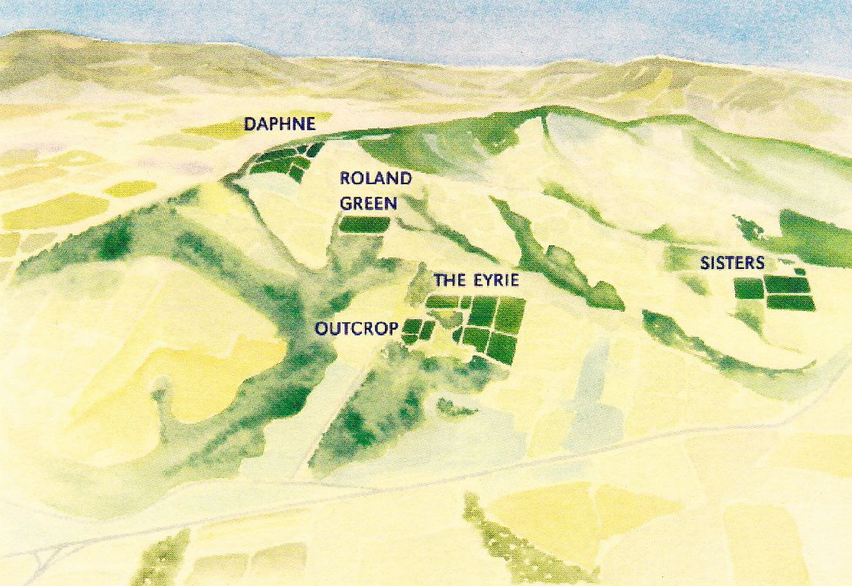
Location: Dundee Hills in the Dundee Hills AVA. Planting: Own-rooted Pommard 5 was planted originally in 1974. 1.5 acres of the original plantings are still in production. Currently, the vineyard consists of 13 acres: 1.5 acres of Pinot Noir, mostly Pinot Gris, and some Pinot Meunier. Daphne is one of the oldest and highest vineyards in the Dundee Hills. Pinot Noir scion: Own-rooted Pommard Soil: Volcanic Jory and Gelderman. Very shallow, averaging less than 10 inches on top of large boulders. Vines: South, east and west facing, 820’ to 900’’ elevation at the peak of the Dundee Hills about 400’ above the original plantings of The Eyrie Vineyard. Because of the high altitude, There is considerable wind exposure. Due to the harsh conditions, the vines are short and bonsai-like. The vines are cane pruned with 9’ x 5’ spacing. Daphne is the last of the Eyrie single vineyards to ripen with tiny clusters. Farming: Regenerative, with no-tilling. Organically certified since 2013. Winery clients: None, a monopole. Old vines bottling: The Eyrie Vineyards Daphne Pinot Noir is produced with a small amount of grapes going into the Estate Pinot Noir. This wine has not been produced in every vintage, for example, not in 2002-2007, 2010, and 2011. Of interest: Daphne is one of five estate vineyards at The Eyrie Vineyards estate. It was originally called Stonehedge but later named Daphne after a dear, long-time friend of the winery. David Lett produced a Daphne Vineyard Pinot Noir from the 2001 vintage but did not like it. He did not release it until years later when it was sold to wine club members and the rest sits in the winery’s library. Jason Lett worked his first vintage in 1973 and continued to work in the vineyards and winery throughout his youth. Today, he oversees all facets of wine production and the business. Diana Lett, Eyrie’s co-founder, still is actively involved in the winery's operations and events.
2016 The Eyrie Vineyards Daphne Vineyard Dundee Hills Pinot Noir 13.0% alc., $80. · Moderate garnet color in the glass. A complex nose offering aromas of red cherry, graham, cardamom, and marijuana. The lean flavor profile is dominated by red cherry, cranberry, and what I can only describe as grassiness and dried green herbs. Generous acidity, integrated tannins and a savory rather than fruity finish. Unchanged when sampled the following day from a previously opened bottle. Score: 89
 2018 The Eyrie Vineyards Daphne Vineyard Dundee Hills Pinot Noir 13.0% alc., $85. · Moderate garnet color in the glass. Aromas of black raspberry, red rose, dried herbs and toast. A harmonious, gracious and polished wine with flavors of raspberry, cherry and plum framed by brave tannins and a good cut of acidity. There is a savory herbal thread in the background. The finish is exceptionally long. Still engaging when sampled two days later from an opened bottle. Score: 93
Elk Cove Estate Vineyard (Elk Cove Heritage Site)
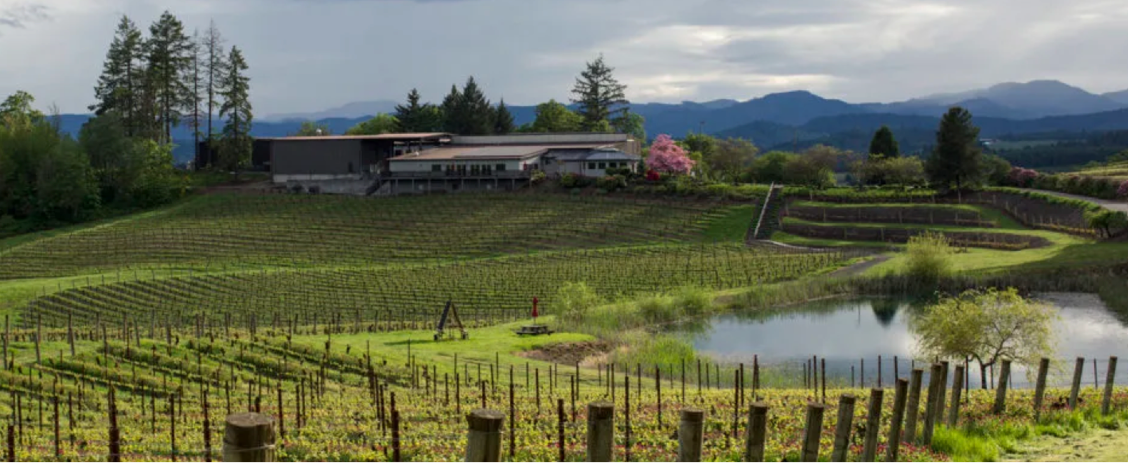
Location: Northern Willamette Valley in the Yamhill-Carlton AVA. Planting: The original plantings of 5 acres of own-rooted Pommard date to 1974. 45 acres of Pinot Noir have been added beginning in 1976 as well as Riesling, Gewürztraminer and Chardonnay (since grafted over to Pinot Gris). See map below. Pinot Noir scion: Own-rooted Pommard Soil: Marine sedimentary Willakenzie. Vines: South-facing with steep slopes. One of the higher vineyards in Oregon, reaching an elevation of 750’. Winery clients: None, a monopole. Old vine bottlings: Three generations of Pommard clone are represented on the Elk Cove Estate with the two most recently planted vineyards employing selection massale. La Boheme vineyard was planted in 1985 and 1987 using cuttings from the best 1974 Pommard vines. A second estate vineyard, Roosevelt Vineyard, was initially planted in 1993 using a selection of the best Pommard vines from La Boheme Vineyard. The winery’s Elk Cove Reserve Pinot Noir has contained contributions from La Boheme and Roosevelt vineyards as well as other Elk Cove vineyards including the original Elk Cove Heritage Site.
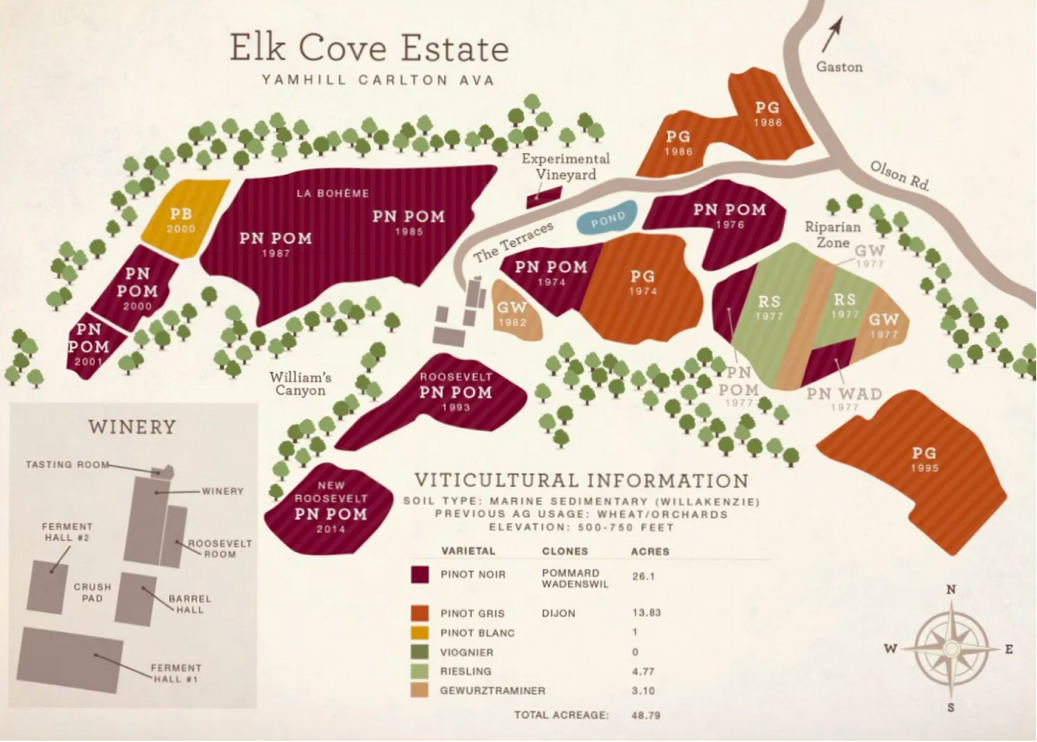
Tyee Estate Vineyard
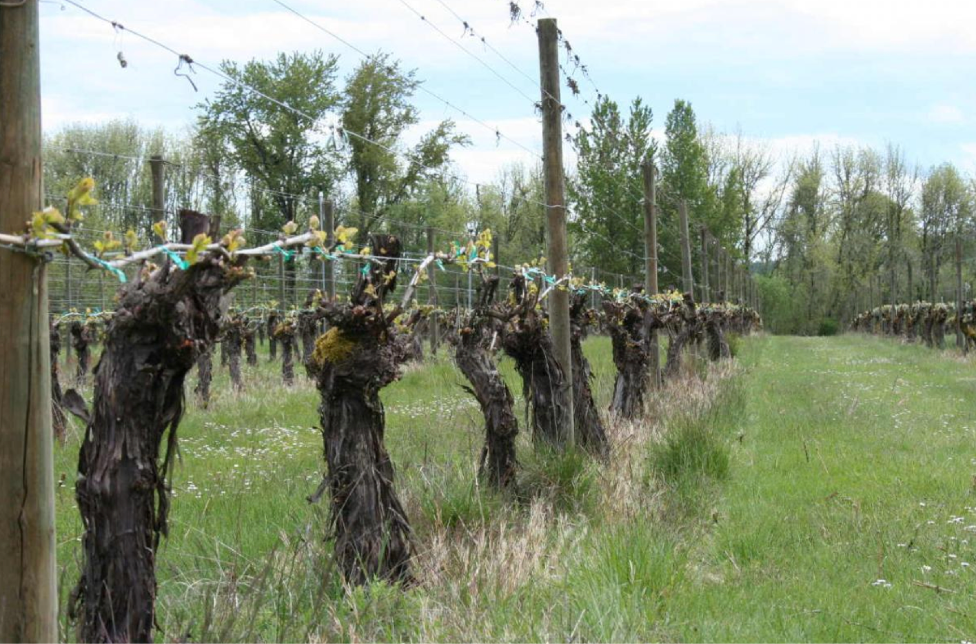
Location: The estate vineyard is on the scenic Buchanan Family Century Farm founded over 130 years ago in Corvallis. Planting: The Buchanans planted the first vines in 1974 including Pinot Noir, Pinot Gris, Chardonnay and Gewürztraminer, all own-rooted. The current total Tyee Estate Vineyard has 3 acres of own-rooted Pinot Noir planted over the years 1974, 1981, 1985 and 1989. Pinot Noir on grafted rootstock was planted in 2000 (115, 777 and Pommard on resistant rootstock) and 2014 (114, 777, and Pommard with grafts from some of the favorite old vines). for a total of 14 acres of Pinot Noir. Another 4 acres is planted to Chardonnay, Pinot Gris and Gewürztraminer. Pinot Noir scion: Own-rooted Pommard. Soil: Willamette silty, clay loam. Vines: South-facing slope at the first terrace of the valley floor. Spacing is 10’ x 4.5’ with mixed shoot and Scott Henry trellis. Farming: Certified Salmon-Safe. A diverse, perennial cover crop under the vines sequesters carbon and prevents erosion. Nearby creeks are protected with native riparian buffers. Only minimal amounts of organic spray are applied to the grapes and organic compost is used for fertility. Dry-farmed and no-tilling. Winery clients: None, a monopole. Old vines bottlings: The winery’s featured Pinot Noir wines are the Tyee Estate Pinot Noir and the limited release Tyee Estate Barrel Select Pinot Noir. The Estate Pinot Noir is composed of newer and old vine Pommard clone and Dijon clones. The Estate Barrel Select Pinot Noir is 100% Pommard clone made from a combination of own-rooted Pinot Noir vines that are 25 to 47-years old, and newer plantings that include the winemaker’s favorite barrels of the vintage. The wines of this heritage and quality are rarely this affordable. Of Interest: Tyee Wine Cellars was founded in 1985. The vineyard manager and winemaker is fifth-generation Willamette Valley farmer Merrilee Buchanan. Tyee is a northwest word meaning “chief” and “best.”
2017 Tyee Wine Cellars Estate Willamette Valley Pinot Noir 13.5% alc., $20. · Moderate garnet color in the glass. Enticing aromas of black cherry, cola, tutti-fruity, and a floral lift. The bold flavors of black cherry, ripe strawberry, spice, cola, and black tea are sturdy on the palate and make quite an impression. Instantly enjoyable, with easygoing tannins and a seamless, very long finish. Score: 93
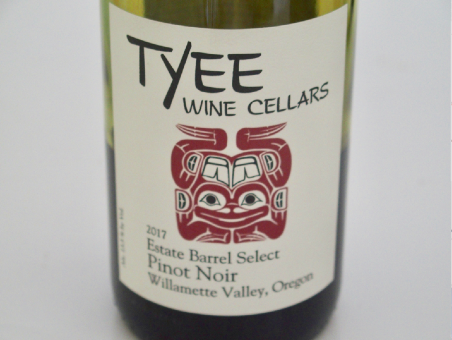 2017 Tyee Wine Cellars Estate Barrel Select Willamette Valley Pinot Noir 13.5% alc., $30. Whole berry and whole cluster fermentation. Bottled unfined and unfiltered. · Moderate garnet color in the glass. Pleasing aromas arrive over time in the glass including blackest cherry, blackberry, burnt tobacco and potpourri. Striking mid-weight plus flavors of black cherry and blackberry framed by sturdy but well-proportioned tannins that contribute to the harmony. An unbelievably long finish is full of sweet Pinot extract. Even more terrific when tasted two days later from a previously opened bottle. Drinkable now, but cellaring will bring more rewards. Score: 95
Wahle Estate Vineyard
Location: On a 100-acre hilltop site outside of Yamhill in the Yamhill-Carlton AVA. Planting: The Wahle family planted a 6-acre vineyard initially in 1974 with 3 acres of the original plantings remaining. This was the first commercial vineyard in the Yamhill-Carlton District.
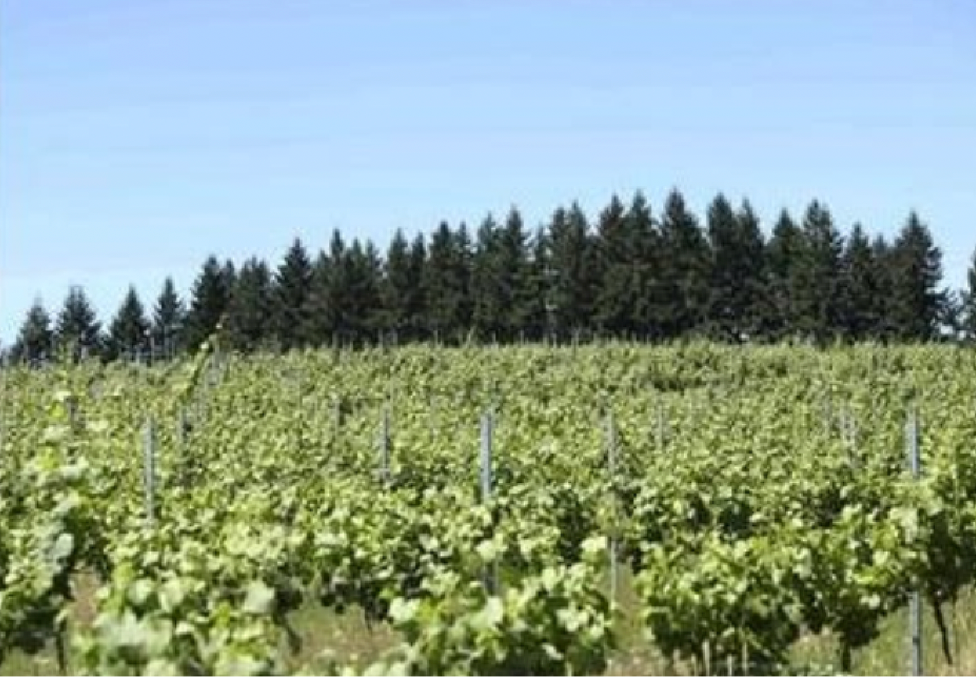
Soil: Sedimentary Willakenzie.series.
Farming: Dry and no-till farmed.
Winery clients: None for Pinot Noir.
Old vines bottlings: A Wahle Yamhill-Carlton Pinot Noir (2017 vintage, $45) was produced containing a
majority of Coury “Pommard” and a smaller fraction of old vine Chardonnay grafted to 777.
Of interest: Dr Mark Wahle is a 1988 graduate with a degree in enology from UC Davis as well as a working
emergency room physician in Portland. He and his spouse also own a 310-acre site in the Eola Hills known
as Holmes Hill Vineyard. Mark crafts his wines at The Carlton Winemakers Studio.
2007 Wahle Vineyard & Cellars Yamhill-Carlton District Pinot Noir
13.4% alc. Sourced from the initial plantings
established in 1974.
·
Moderate light garnet color with slight
bricking of the rim in the glass. The aromas of black cherry,
exotic spices, lavender and graham are pleasant but fleeting.
The wine has an aged patina with mid-weight fruit flavors of
black cherry and blackberry with a floral perfume. Very suave
with completely resolved tannins and juicy acidity. An
impressive wine especially since 2007 was not a great Oregon
vintage, but only for a short time after opening as later the wine
faded out with oak coming to the forefront. From my cellar.
Score: NR
Location: On the south side of Worden Hill Road in the Dundee Hills AVA.
Planting: The available information on the initial planting at Red Hills Vineyard is unclear. Reportedly, 10 acres
were planted in 1974 and another 5 acres in 1975. Chardonnay was grafted over to Dijon 115 at some point
years later. Donna Morris told me there were 3 blocks of approximately 3 acres of own-rooted Pinot Noir
planted in 1974-75 and these vines, along with some old-vine Chardonnay grafted over to Dijon 115 are the
source of the Winderlea Legacy Pinot Noir.
Pinot Noir scions: The initial planting included both own-rooted Pommard and Wädenswil clones as well as
Coury selection Pinot Noir along with Chardonnay, Riesling, Cabernet Sauvignon. and Merlot. The source of
the scions was was Charles Coury
Soil: Volcanic Jory.
Vines: Original vines had 10’ x 8’ spacing but interplanting has occurred. Vines are oriented north-south with
southwestern exposure at 320’-580’ elevation.
Farming: Biodynamic farming since 2009 and Demeter Biodynamic Certified® in 2015.
Winery clients: In the early 1980s, grapes were sold to Elk Cove, Erath, the Eyrie Vineyard, Rex Hill and
Lange. Winderlea has no winery clients for Winderlea Estate Vineyard which is now a monopole.
Old vine bottling: Winderlea Legacy Winderlea Vineyard Pinot Noir.
2010 Winderlea Legacy Winderlea Vineyard Dundee Hills Pinot Noir
13.2% alc., $75. (Reviewed in 2012 - “an
aristocratic wine with upscale aromas, intensely fruity palate and citrus-infused acidity.”)
·
Moderately light
garnet color in the glass. A complex nose offering scents of dark red cherry, strawberry, underbrush, rose petal
and dried herbs. Light to mid-weight in style, with flavors that echo the nose. An arrow of acidity runs through
that is uplifting. The tannins are resolved, and the lip-smacking, long finish is replete with intense cherry
goodness. The wine is best upon opening and llater showing its age so drink up.
Score: 93
2017 Winderlea Legacy Winderlea Vineyard Dundee Hills Pinot Noir
12.5% alc., 291 cases, $85. Aged 10 months in
French oak barrels, 3% new.
·
Light garnet color in the glass.
Aromas of lean cherry juice, white pepper, salad greens, and a
touch of oak. Light in weight with an array of demure red fruits.
Bashful, yet showing good harmony, and a fairly long ,
quenching finish imbued with fine-grain tannins. Extremely
elegant.
Score: 91
Location: Tualatin Hills AVA in the very northern part of the Willamette Valley (20 miles west of Portland).
Planting: Initially, 3.2 acres of Pinot Noir vines were planted in 1974. There has been no interplanting or
supplemental plantings in the interim. Today, there are 20 acres that include subsequent plantings of Pinot Noir,
Chardonnay, Pinot Gris and Riesling.
Pinot Noir scion: Own-rooted Pommard clone sourced from Charles Coury.
Soil: Laurelwood windblown silt.
Vines: South-facing slopes and mid-level elevation of 500’.
Farming: Sustainably farmed with organic practices since 1999. Vines are dry-farmed.
Winery clients: EIEIO & Company.
Old vines bottling: The Elk Cove Vineyards Windhill Vineyard Pinot Noir is produced solely from 4 acres
of the oldest Pommard clone Pinot Noir vines on the property.
2018 Elk Cove Vineyards Windhill Vineyard Willamette Valley Pinot Noir
14.0% alc., pH 3.58, 154 cases, $60.
Harvest Brix 24º. Fermented in small open-top steel
fermenters and aged 10 months in 27% French oak barrels.
·
Dark garnet color in the glass. Engaging aromas of
blackberry, boysenberry, creme soda, and bramble. Midweight
plus flavors of olallieberry and blackberry touched with
exceptional spice. Expansive on the mid palate and the
extremely long finish. Supportive, dusty tannins and welcome
oak with an underlying earthy tone. This wine reminds me of a
delicious olallieberry pie (my favorite).
Score: 95
Location: Two miles from David Hill Vineyards but a cooler terroir.
Planting: The property was planted initially in 1971-1972 to Gewürztraminer and in 1974 to Pinot Noir. There
were additional plantings of Pinot Noir and other varieties into the 1980s, 1990s and 2019, and the Wirtz
Vineyard now spans 24 acres.
Soil: Laurelwood.
Vines: The vineyard is mostly east-facing with the upper blocks facing south. Vines are cane pruned with VSP
for the trellis.
Farming: LIVE certification. Dry-farmed.
Winery clients: Big Table Farm bottled a vineyard-designate Pinot Noir and Pinot Gris (many past reviews are
in the PinotFile). The last bottling was the 2016 vintage. Now, the vineyard is a monopole for David Hill
Vineyards who bottles a Wirtz Vineyard Pinot Noir, Chardonnay and Pinot Gris.
Old Vine bottlings: David Hill Vineyards & Winery Wirtz Vineyard Pinot Noir. Multiple white varietals are
produced from old vines. Big Table Farm Wirtz Vineyard Pinot Noir (last vintage 2016).
Of interest: Vineyard Manager Mike Kuenz told me the following. “The old vine Chardonnay is super
interesting and pretty certain it is the Draper clone. The origin of the Pinot Gris is unknown but possibly came
from David Lett and is one of the best wines from this vineyard. Other white varieties planted include
Chasselas, Franken Riesling, Gewürztraminer, Muscat, Riesling, Semillon, Sylvaner, Savagnin Rose and Flora
(a Gewürztraminer-Semillon hybrid from Dr. Olmo at UC Davis). Wirtz Vineyard and Schramsberg are the only
known commercial plantings of Flora. Wirtz Vineyard is a super interesting site for whites!”
2015 Big Table Farm Wirtz Vineyard Willamette Valley Pinot Noir
13.9% alc., 368 cases, $48. Bottled unfined and
unfiltered.
·
Moderately dark garnet color in the glass. Inviting
aromas of earth-dusted cherry, cardamom spice, pipe smoke,
and toast. This wine is seemingly at its apogee, featuring flavors
of black cherry, cola and grilled mushrooms. Mid-weight plus in
concentration, with a modicum of suave tannins that lead to a
slight astringency on the finish.
Score: 93
2019 David Hill Wirtz Vineyard Tualatin Hills Estate Pinot Noir
12.8% alc., pH 3.55, TA 0.60, $N/A. Ownrooted
Pommard, Wädenswil, and Coury selection Pinot Noir. Aged 15 months in 15% new French oak barrels.
·
Moderately light garnet color in the glass. There is plenty of toasty oak on the fruit-shy nose that begs for more
Pinot perfume. I sensed some possible Brett on the nose. Earthy and rustic on the palate with blackberry, plum
and pomegranate fruit flavors framed by tame tannins. The finish is giving of dark fruits and is noticeably
lengthy. Several hours after opening, the wine was re-tasted and there was still significant toast shadowing the
core of fruit.
Score: 89
Location: Sherwood in the Laurelwood District AVA.
Planting: 2 acres of Pinot Noir were planted in 1975. Abetina Vineyard was part of a joint venture between
Oregon State University and the Oregon wine industry known as the Winegrower’s Project and was intended to
introduce and evaluate a selection of virus-free Pinot Noir clonal materials.
Pinot Noir scions: A variety of own-rooted, Pinot Noir clones. Luisa Ponzi told me that 22 clones of Pinot
Noir taken from UC Davis and France were selected for the trial. From the research, important knowledge was
obtained concerning the suitability of Pinot Noir clones for Oregon. These clones are now being referred to as
the “Oregon heritage clones.” After the research concluded, Dick Ponzi began to vinify Abetina and all of its
clones together and Abetina became the jewel of the Ponzi cellar. Abetina continues to consistently produce
distinctive wines of the highest quality. Luisa said, “When I began making wines in 1993, I considered this mix
of clones in Abetina vineyard as some kind of magical combination.”
Soil: Laurelwood series.
Vines: Southeast exposure at 400’-500’ elevation. The vine spacing is 8’ x 4’.
Winery clients: None, a monopole.
Old vines bottlings: Abetina Vineyard is selected for a single-vineyard designate bottling only in the finest
vintages: 1996, 2002, 2005, 2008, 2014, and 2015. The Ponzi Reserve Pinot Noir contains some grapes from
Abetina Vineyard as well as Ponzi’s Aurora and Madrona vineyards, and other nearby vineyards.
Of interest: Abetina 2 Vineyard is located on a 40-acre, northwest-facing site at 300’-600’ elevation, 3 miles
southwest of the Ponzi Estate Vineyard on Hwy 219. It is part of the 80-acre Aurora Vineyard. 20 acres were
planted in 2005 with 10 acres devoted to Pinot Noir. Half of the Pinot Noir is a field blend of budwood taken
from the clonal trial block at Abetina Vineyard (clonal massale) and the rest is Dijon 777. Both are grafted to
Ripairia Gloire rootstock with a spacing of 6’ x 40cm and the vines are irrigated. Abetina 2 sits on the same soil,
elevation and aspect as Abetina Vineyard. An Abetina 2 vineyard-designate Pinot Noir has been produced in 2011, 2012,
2016, and 2018.
Another Ponzi estate vineyard, Avellana, was planted fully to clonal massale (a hybrid of clonal selection and
massale selection). 22 heritage clones from Abetina are combined with Dijon 113, 114, 115, 667, and 777 on
rootstock planted through 2014. This is the most extensive planting of Pinot Noir clones in the United States.
Louisa Ponzi explains her experience with clonal massale. “In the early 1990s, we started planting the Dijon
clones 113, 114, 115, 667 and 777 in separate blocks. Over the years, I realized once again that the blend of
clones in the final wines was always superior and more interesting than a single clone. After my time spent in
Burgundy, I recognized the value of selection massale. Through my experience with the clonal trials and Aurora
Vineyard and the high-quality block at Abetina, I recognized the contribution of clonal selection. However, I
wanted the reliability of clones along with the benefit of massale. This technique of mixing clones with cuttings
from a reliably exceptional block or clonal massale accomplishes both. Since 2006, I have planted all Pinot
Noir blocks (over 50 acres on 3 sites) with a curated selection and percentage of over 27 clones. Once that mix
is determined based on elevation and exposure, the vines are planted like wildflowers and the resulting
complexity and variability are set in stone (or until they mutate into one unique block).”
2018 Ponzi Abetina 2 Vineyard Chehalem Mountains Pinot Noir
14.0%
alc., pH 3.62, TA 0.53, 200 cases, $110. Fruit from Abetina 2 block at
Aurora Vineyard. 100% de-stemmed, 5-day cold soak, 7-day postfermentation
maceration, Aged 20 months in French oak barrels, 50% new.
Bottled unfined and unfiltered. Aged in bottle for 5 months before release.
·
Moderately dark garnet color in the glass. Beautifully perfumed with
aromas of dark cherry, tilled earth and truffle. Darker hued and darker
fruited in a mid-weight style featuring flavors of black cherry, purple grape,
blackberry, cinnamon spice, dark chocolate, and vanilla. The moderately
firm tannic spine moderates the fruit load. The texture reminds one of silk
pajamas. An extremely persistent grand cru finish is exhilarating. Over time
in the glass, the wine builds in hedonistic pleasure offering a charming
spiciness. When tasted two days later from a previously opened bottle, the
wine woke up the mouth with dreamy goodness.
Score: 97
Owner: Arthur Weber met David Lett in the mid-1960s at Oregon State University and he became deeply
interested in the potential of the Oregon wine industry. In 1970, Arthur and Vivian Weber traveled to Oregon to
talk to David Lett. While searching for Lett’s home, they came upon Jim and Loie Maresh instead. Jim and Loie
sold the Webers a nearby plot of 21 acres in the Dundee Hills in 1972. In 1976, their neighbor Nita Moyer sold
them an additional 65 acres that bordered their existing acreage. In 2001, The Webers sold about 21 acres of
the original vineyard including 2.75 acres of Pinot Noir to Andy and Adria Humphreys who were long-time
Weber Vineyard managers and the Humphreys renamed their portion Ana Vineyard. The Weber Vineyard was
to the east and Ana Vineyard to the west. The Humphreys resold their acreage to Holloran Vineyard Wines
who constructed a new winery on the property. Weber Vineyard is currently owned by Vivian Weber.
Location: The south side of Worden Hill Road in the Dundee Hills AVA. The vineyard is adjacent to Winderlea, Arcus
and Maresh vineyards.
Planting: 2.76 acres of own-rooted Riesling were planted in 1975 and 2.75 acres of own-rooted Pinot Noir were planted in 1976. From
1976 to 1988, the Webers planted 35 acres of Pinot Noir, Chardonnay, and Gewúrztraminer and sold the
grapes. The Weber Vineyard currently consists of 21.28 planted acres.
Pinot Noir scion: Own-rooted Pommard acquired from Dick Erath.
Vines: The original Pinot Noir planting is at the top of the east-sloping hillside. The entire vineyard is east-facing
and is positioned at the bottom of a geographical bowl that opens up only to the south making it a cool
vineyard in a warm area. Weber Vineyard sits down the hill a quarter of a mile from Maresh Vineyard and
receives plenty of morning sun from its east-facing slope. The original vine spacing was 9' x 6'.
Farming: Organic practices. Biodynamic preparations were initiated in 2018. Dry-farmed.
Winery clients: Weber Vineyard: Arterberry Maresh (old vines), Cameron, Erath, J. Christopher, Kelley Fox,
Patricia Green Cellars (Pommard clone planted in 1983 at the top of the east-sloping hillside), Oak Knoll, Rex
Hill, R. Stuart (own-rooted Pommard clone planted in 1985), Stephen Goff, and Winderlea. Ana Vineyard:
Hazelfern, Trathen Hall.
Old vines bottlings: Winderlea Weber Vineyard Pinot Noir, Winderlea also sourced from Ana Vineyard in
the past), Arterberry Maresh Weber Vineyard and an Old Vines blend with Maresh Vineyard, and Patricia
Green Cellars Weber Vineyard Pinot Noir (1983 planting). Holloran Ana Vineyard Pinot Noir.
Of interest: The vine age and clones at Weber and Maresh vineyards are similar but the personality of the fruit
is surprisingly different given the closeness of the two locations. Maresh Vineyard fruit is pretty, red, and high toned
while Weber’s fruit is dark, earthy, savory and sultry.
2017 Winderlea Weber Vineyard Dundee Hills Pinot Noir
13.1% alc., $60. Own-rooted Pommard clone from 1976
plantings.
·
Moderately light garnet color in the glass. Earthbound
nose that adds the fruit aroma of dark cherry reduction
sauce. The flavors replicate the aromas in a mid-weight style
that exhibits excellent harmony. Easy to like with very fine
backing tannins and a polished demeanor. The finish is
unbelievably long.
Score: 93
2019 Arterberry Maresh Weber Vineyard Dundee Hills Pinot Noir
13.0% alc., $69. Only .48 tons per acre
from old vines in this vintage.
·
Moderate garnet color in the glass.This wine exhibits significant oak overlay even
from an opened bottled tasted 36 hours later. There is a core of deeply flavorful cherry and blackberry fruit but
it is overwhelmed by aggressive barrel treatment. There is significant tannin that is probably barrel in origin and
is reflected in the astringent finish.
Score: 88
2019 Patricia Green Cellars Weber Vineyard Dundee Hills Pinot Noir
13.2% alc., $48. 100% de-stemmed
after early pick. Aged in 8% new oak. Pinot Noir sourced from a section of the vineyard planted in 1983.
·
Moderately dark garnet color in the glass. Aromas of blackberry, white pepper, tilled earth, toast, and espresso.
Earth-dusted black cherry and blackberry fruit flavors backed by toasty oak. This wine has a savory and gamey
wildness character that attracts. Unchanged when sampled the following day from a previously opened bottle.
Score: 91
2010 Winderlea Ana Vineyard Dundee Hills Pinot Noir
13.1% alc.. Own-rooted Pommard Pinot Noir dating
to 1976 and some Dijon 777.
·
Moderate garnet color in the glass. A wow! nose offering soaring aromas of
cherry, baking spice and sandalwood. The mid-weight array of red fruits are framed by a touch of tannin and
excellent acidity. The wine is surprisingly fresh after 11 years and only showing a mild aged patina. The finish is
remarkably long. Fans of aged Pinot Noir will be delighted with this wine.
Score: 94
2018 Trathen Hall Ana Vineyard Dundee Hills Pinot Noir
13.8% alc., 50 cases, $45. Old vine composition
unknown.
·
Moderately light garnet color in the glass. Aromas of red cherry and strawberry with a floral and stem
note. Light to mid-weight flavors of cherry and strawberry that have good mid-palate presence and a long,
black cherry driven riff on the finish. There is good harmony with mollified tannins and a good cut of acidity.
Score: 92
Vineyards Established 1976-1979
1976Adams Vineyard
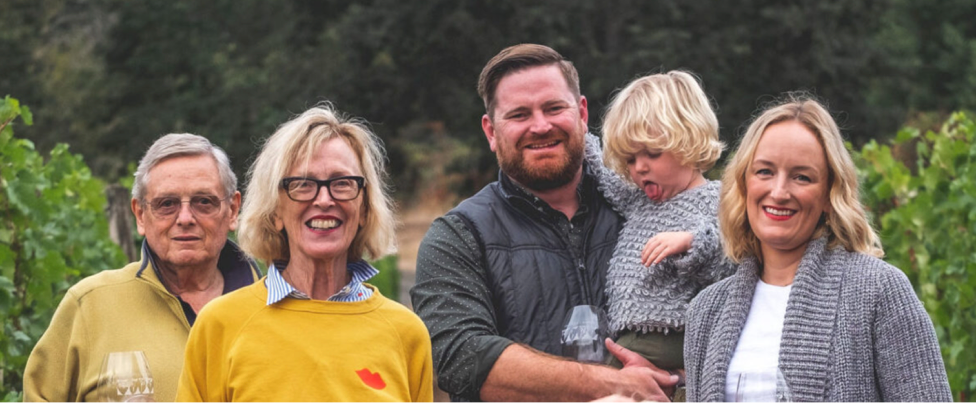
Location: Chehalem Mountains AVA. Planting: The original plantings of 13 acres were sourced from Erath and consisted of 75% own-rooted Pommard and 25% own-rooted UCD 108 Chardonnay. Peter completed the initial cultivation layout of the vineyard and Carol, Bill, and Teri Doan along with other hired help all worked to plant the vineyard. The upper half was completed in 1976 and the lower half in 1977. There has since been supplemental planting of Dijon 777 clone. The owners still have a 2-acre block of original Pinot Noir vines which is used for the Reserve Pinot Noir program. Pinot Noir scion: Own-rooted Pommard (from Dick Earth). Soil: Primarily Jory clay loam. Vines: The vineyard aspect is south and southeast-facing with 9' x 5' spacing of the original vines. VSP trellis. Winery clients: None, a monopole. Old vines bottling: Adams Reserve Pinot Noir is 100% old vine Pommard. Of interest: The first 1981 vintage was produced at the Adelsheim basement winery. The owners opened their own winery for the 1985 vintage and Carol Adams took over the winemaking duties. During the 1980s and 1990s the wine brand was Adams Vineyard Winery. The business was sold to Rex Hill in 1994 but the Adams family retained ownership of Adams Vineyard and leased the vineyard to Rex Hill. In 2008, the Adams family started the Trout Lily Ranch brand and became a virtual winery, contracting production at the 12th & Maple facility in Dundee. The winermaker since 2008 has been Kelly Kidneigh. Production has more recently been moved to Andante Vineyard in Dallas, OR. The Adams name is retained for the Reserve Pinot Noir program.The Adams’ daughter Frances (Fanny) Adams and her husband Jacob Hale are transitioning the company to a carry-on business.
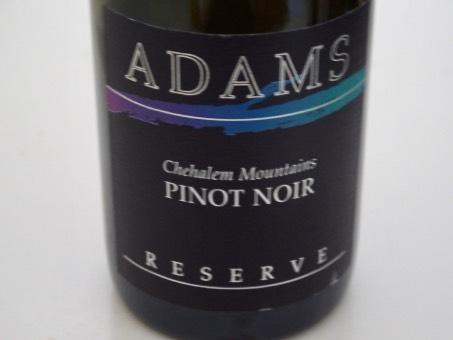 2018 Adams Reserve Adams Vineyard Chehalem Mountains Pinot Noir 13.7% alc. (?14.3%), pH 3.59, TA 0.52, $55. Produced and bottled by Trout Lily Ranch, Dallas, OR. 5-day cold soak, indigenous yeast fermentation, and aged 18 months in French oak barrels, 40% new. Bottled unfiltered. · Moderately dark garnet color in the glass. Aromas of blackberry, Italian spices, earthy flora and a floral lift. A flood of black cherry, black plum and blackberry fruits greet the palate. This mid-weight plus wine is both long in the mouth and finish. The fine-grain tannins are slightly daunting but should ameliorate over time. A little rustic in character and could benefit from more acidic verve, but otherwise a solid wine. Score: 91
DION Vineyard
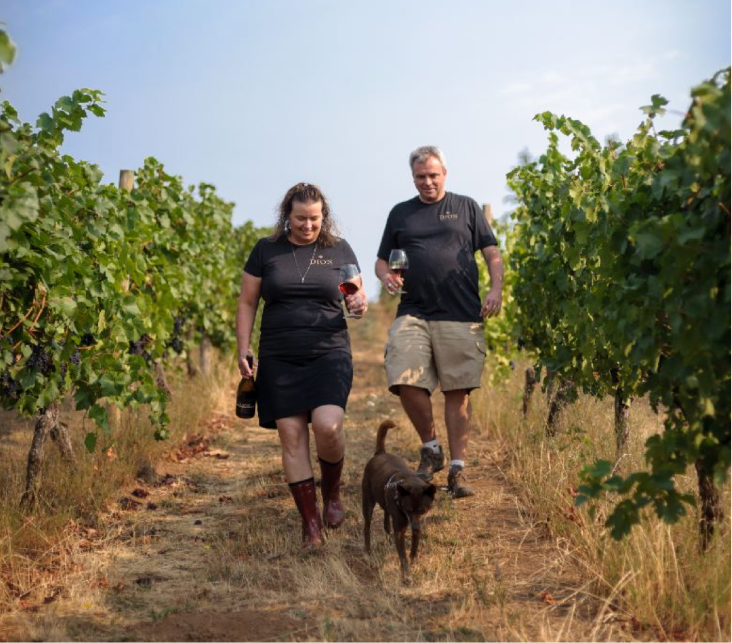
Location: Northern end of the Chehalem Mountains AVA (“in the hook”) and the Laurelwood District AVA. Planting: Records are sketchy. 5 acres of Pinot Noir and an Upright Pinot were planted initially on an existing wheat field.The first 12 rows are Upright Pinot and set super heavy so they have gone into the winery’s sparkling or rosé. Rows 13-18 are own-rooted Pommard. Replacement vines have been added since 1999. Additional plantings of Pommard, 115, 114, 113, 667 and 777 of varying ages and rootstocks bring the total current planted Pinot Noir acreage to 27.1. The vineyard’s total 60 planted acres include Chardonnay and Pinot Gris. Pinot Noir scions: Own-rooted Pommard and Upright Pinot. Soil: Laurewood series. Vines: South-facing on a slope at 300’-350’ elevation. Predominantly 9’ x 6’ spacing with some West Block planted to 7’ x 5’. VSP trellising. Farming: LIVE certified for over 12 years and dry-farmed. Winery clients: Ponzi, Oak Knoll, and Erath have sourced from younger vines. Old vines bottling: DION Vineyard Old Vines Special Release Pinot Noir is offered annually. These wines age extremely well.
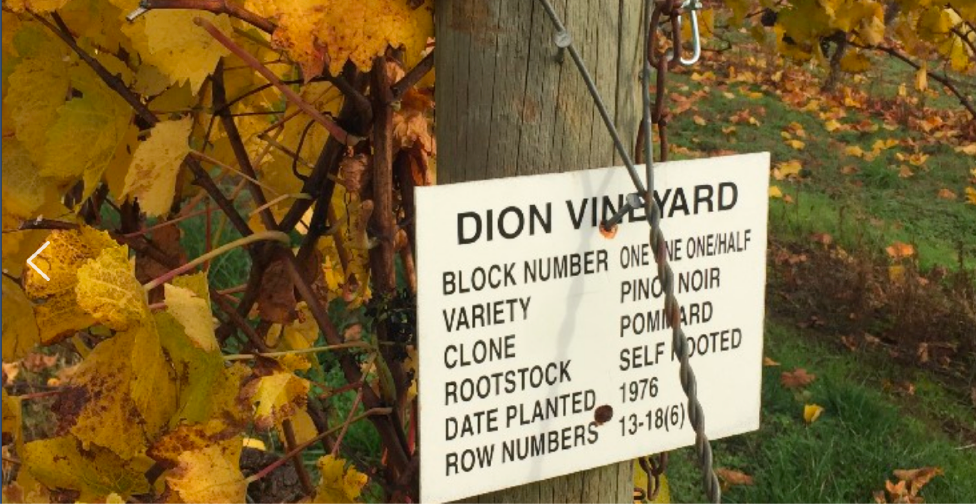
2010 DION Old Vines Limited Release Chehalem Mountains Pinot Noir 13.0% alc., $35. Aged 13 months in French oak barrels, 50% new. · Moderately light garnet color in the glass. Surprisingly fresh and alive black cherry, potpourri and rose petal aromas. Earth-toned flavors of black cherry, spice, iron and smoky oak. Good bones for a 11-year-old wine but fruit is beginning to fade as oak surfaces. Still interesting but has seen better days. Score: 90
2011 DION Old Vines Limited Release Chehalem Mountains Pinot Noir 13.5% alc., 48 cases, $40. · Light garnet color in the glass. Pleasing scents of dark cherry, purple berry and vanilla cream. Lighter in weight but brimming with dark red strawberry, raspberry and black cherry fruit flavors framed by gossamer tannins. Silky in the mouth, with a remarkably long finish. A great aged Pinot Noir from a challenging vintage that has reached its apogee. Score: 93
 2012 DION Old Vines Limited Release Chehalem Mountains Pinot Noir 14.5% alc, 50 cases, $45. Aged 13 months in French oak barrels, 50% new. · Moderately light garnet color in the glass. Nicely scented with aromas of blackberry, cherry pie spice and savory dried herbs. A dancing Pinot with glass-filling presence, offering flavors of black cherry, pomegranate snd blackberry. Ghost tannins and enough acidity to keep the wine fresh. Discreetly concentrated and not like a fruit compote as are so many Pinot Noirs from this warm vintage. Still a few good years left, but why wait? Score: 94
2014 DION Old Vines Limited Release Chehalem Mountains Pinot Noir 14.3% alc., 92 cases, $65. Released spring 2021.Harvest Brix 23.7-24.1º. Pommard clone. Aged 14 months in French oak barrels, 50% new. · Light garnet color in the glass. This very sexy nose is brimming with the aromas of cherry leather, spice and red rose petal. An ephemeral wine with vital acidity and refined tannins. Endlessly gentle and polished, with a mid-weight load of vivid red cherry and berry fruits that satisfy for thirty seconds on the finish. Remarkably flavorful considering the light weight and color. A very beguiling wine. Score: 96
2016 DION Old Vines Limited Release Chehalem Mountains Pinot Noir 14.6% alc., 99 cases, $60. Harvest Brix 25.1º. Aged in 50% new French oak barrels. · Moderate garnet color in the glass. The nose offers a riper fruit profile including aromas of purple and black berries, and forest path. Unusually rich and ripe vintage but not over the top. Impressive palate presence of boysenberry and blackberry fruit flavors framed by tannins that are so fine as to be imperceptible and defining acidity. Very suave and harmonious on the palate with the alcohol held in check, and a long, powerfully aromatic finish. Still terrific when tasted the following day from a previously opened bottle. Score: 96
2018 DION Old Vines Limited Release Chehalem Mountains Pinot Noir 13.8$ alc., 92 cases, $65. Harvest Bris 23.7º-24.1º. Aged 14 months in French oak barrels, 50% new. · Moderately dark garnet color in the glass. Intriguing aromas of darker berry and cherry, sweet pipe smoke, earthy flora and a subtle cloak of oak. Midweight plus in style with black cherry and black raspberry flavors augmented with a rustic, gamy bent. Admirable harmony with a perfect fruit and tannin ratio. This wine had me starring at the glass and asking, “How could so much flavor come from this wine.” The finish, like all great wines, lingered for what seemed like an eternity. Wow! (Reviewed January 17, 2021) Score: 96
Medici Vineyard
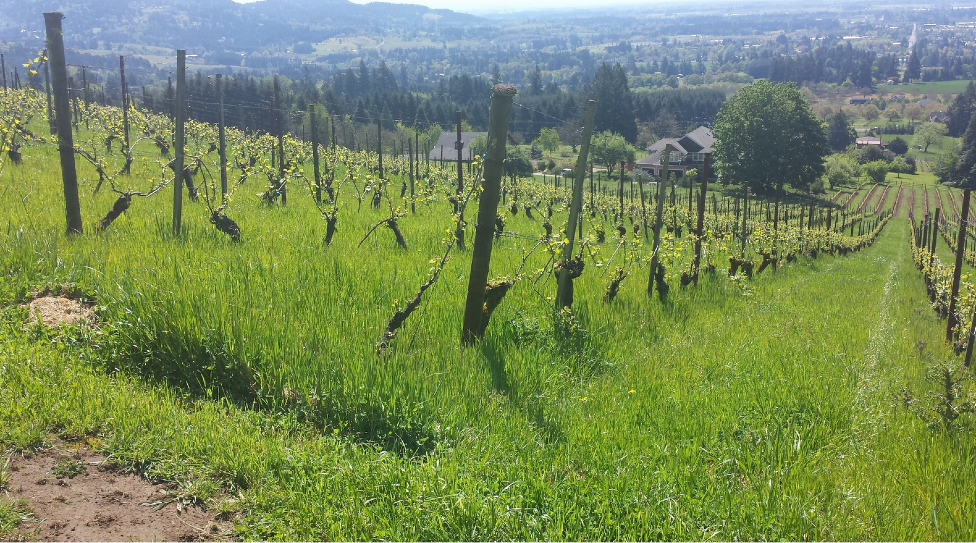
Location: North of the town of Newberg on Bell Road in the Chehalem Mountains AVA. The property is situated just a few miles east of the J. Christopher Winery. Planting: There was a tiny 1-acre planting in 1973 with cuttings sourced from Ponzi. The major original planting of 6 acres of Pinot Noir occurred in 1976 and a later planting followed in 1988. The initial vines were own-rooted Pommard sourced from Erath. The 1976 planting was performed by Hal and Dorothy and their family, the Ponzi family and students in is class at Portland City College. A 1980 planting of Chardonnay was grafted to Dijon 777 in the late 1990s. The current vineyard is 23 acres of Pinot Noir and 2 acres of Riesling. Pinot Noir scion: Own-rooted Pommard. Soil: Volcanic Jory. Vines: South-facing aspect at 550’-850’ elevation. Farming: The Medicis hired all the vineyard work out while enjoying the country lifestyle. Biodynamic since 2015 and immaculately farmed organically since 2016 by J. Christopher Winery. Since Jay Somers left in 2019 after the contentious sale of his winery, I do not have specifics on farming thereafter. Winery clients: In the early years, there were many small winery clients including Ponzi. More recently, J. Christopher (since 2015), Patricia Green Cellars, and Rex Hill were clients. Medici Vineyards Pinot Noir wines were crafted by Eric Hamacher beginning in 1995 and then by Peter Rosback for 15 years. The Medici Vineyard label has been discontinued since the 2012 vintage. Rosback launched his own Sineaan label in 1994 at Medici Vineyard along with David O’Reilly who later left and founded Owen Roe Winery. Old vines bottlings: Patricia Green Cellars Medici Vineyard Pinot Noir has been sourced from the oldest extant Pommard and 777 vines, 50% of each clone from Medici Vineyard manager Jay Somers during the years 2015 through 2019. J. Christopher “Old Vines” Medici Vineyard Pinot Noir (last vintage 2019) is from 100% own-rooted original Pommard vines (Jay Somers crafted J. Christopher “Old Vines” Medici Vineyard Pinot Noir through the 2019 vintage, but sold the winery that year to Erni Loosen and founded a new label, J.C. Somers Vintner). Medici Vineyards Estate Reserve Blocks I & II is no longer produced. Of interest: Hal designed and built two buildings on the property including a winery facility. He believes that his legacy is that he gave at least fifteen small wineries their start at his vineyard and winery including Sineaan and Owen Roe. Hal, who is now nearly 90-years-old, likes to tell the following story.”I was in my faculty office at Portland City College in 1969 when a guy walked in selling books. It was commonplace for the time for salesmen to call on teachers to encourage them to buy textbooks. The “guy” was David Lett, who told him that he wanted to start a winery.”
2017 J. Christopher Medici Vineyard Old Vine Cuvée Chehalem Mountains Pinot Noir 13.5% alc., $60. Unfiltered. · Light garnet color in the glass. Expressive aromas of red cherry, cranberry, and oak vanillin. Light to mid-weight in style, with a dramatic blast of cherry fruit on entry. Long in the mouth and finish that is alive with cherry flavor. Very giving, with suave tannins, impeccable balance and a hint of complimentary oak. Score: 94
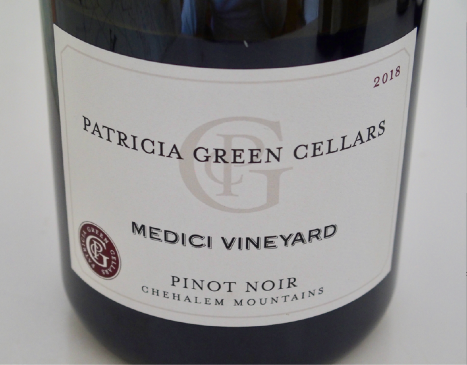 2018 Patricia Green Cellars Medici Vineyard Chehalem Mountains Pinot Noir 13.9% alc., $120. Magnum. · Moderately dark garnet color in the glass. Gregarious aromas of blackberry, boysenberry and spice upon opening. Mouth filling richness in a mid-weight plus style sporting joyous, oakkissed layers of dark fruits including blackberry and cassis. The wine is caressing the mouth with defining tannins. Several hours after opening, the wine had evolved into a gorgeous Pinot in every respect with the endless echo of the scent of fruit on the finish. This will easily be a 20-year wine in magnum format. Score: 95
Woodhall III Vineyards
Location: Two miles west of Alpine and approximately 25 miles south of the Oregon State University campus. Planting: The vineyard was planted originally in 1976 (also reported as 1977) and continued into the late 1980s when 13.5 acres were planted to 22 different varieties including Pinot Noir, Gamay Noir and Napa Gamay according to the posted history of the vineyard on the OSU Horticulture site. (The original plantings in 1976 have also been reported as about 18 acres of Pinot Noir according to Tabitha Compton of Compton Family Cellars). New research plantings were added in 1989, 1990, and 1997 combined with vine removal through 2002 so that the current vineyard has 3.5 acres of of the original own-rooted Pinot Noir vines.
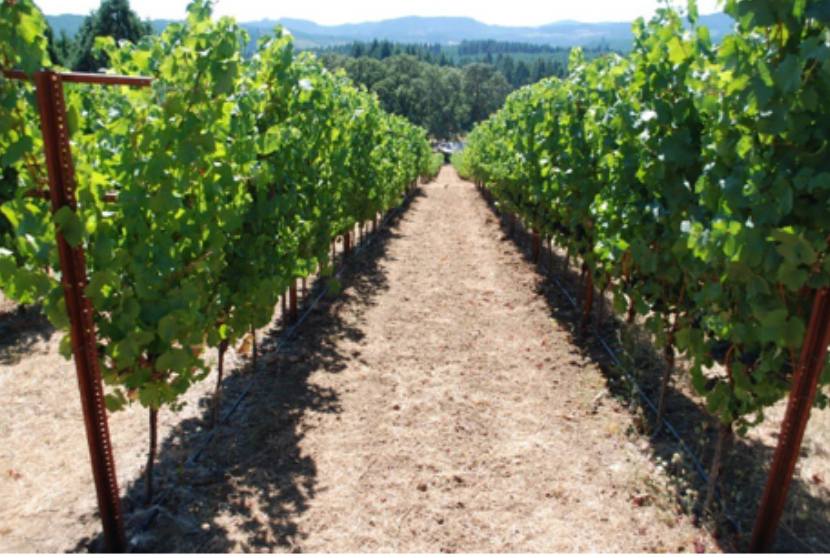
Soils: Hazelair and Dupree series sedimentary and basic igneous bedrock. Vines: South-facing vines at 450’-750‘ elevation. Original vine spacing was 9’ x 6’. Cane pruned and a modified vertical upright canopy. Farming: Sustainably and dry-farmed. Winery clients: This vineyard was originally intended to provide high quality wine grapes to amateur winemakers in northwestern Oregon. Currently, all extra fruit goes to Compton Family Wines. Old vines bottlings: Compton Alpine Cuvée Willamette Valley Pinot Noir is a blend of two vineyards in Alpine including Woodhall Vineyard and BoVine Vineyard (planted in 2008 to Pommard and Wädenswil clones). Spindrift Cellars Woodhall Vineyard Willamette Valley Pinot Noir was offered in the 2016 vintage (Spindrift Cellars is no longer a separate label but has been incorporated into the Compton Family Wines label).
 2016 Spindrift Cellars OSU Woodhall Vineyard Willamette Valley Pinot Noir 13.4% alc., $28, screw cap. · Moderately dark garnet color in the glass. An earthbound wine with considerable charm. Wholesome aromas and flavors of dark red cherry and berry in a mid-weight plus style. Gentle tannins, a soothing texture and a glorious finish packed with showy ripe fruit. Reviewed in 2019. Score: 94
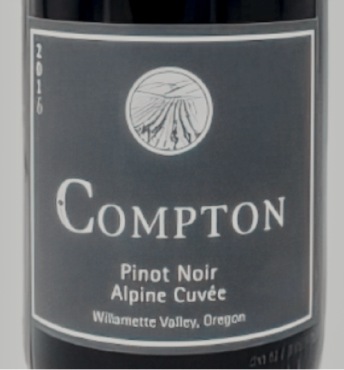 2017 Compton Alpine Cuvée Willamette Valley Pinot Noir 13.8% alc., $34. · Moderately light garnet color in the glass. The nose exudes red cherry goodness with a side of spice and red rose aromas. Easy going in a harmonious, mid-weight style, driven by cherry and raspberry fruit flavors with a shadow of oak and a mossy, forestry undertone reflecting its Alpine origins. Focused tannins and a raspberry-themed finish of some length complete the picture. Reviewed November 14, 2021. Score: 93
1977 & 1979
Bethel Heights Legacy Blocks
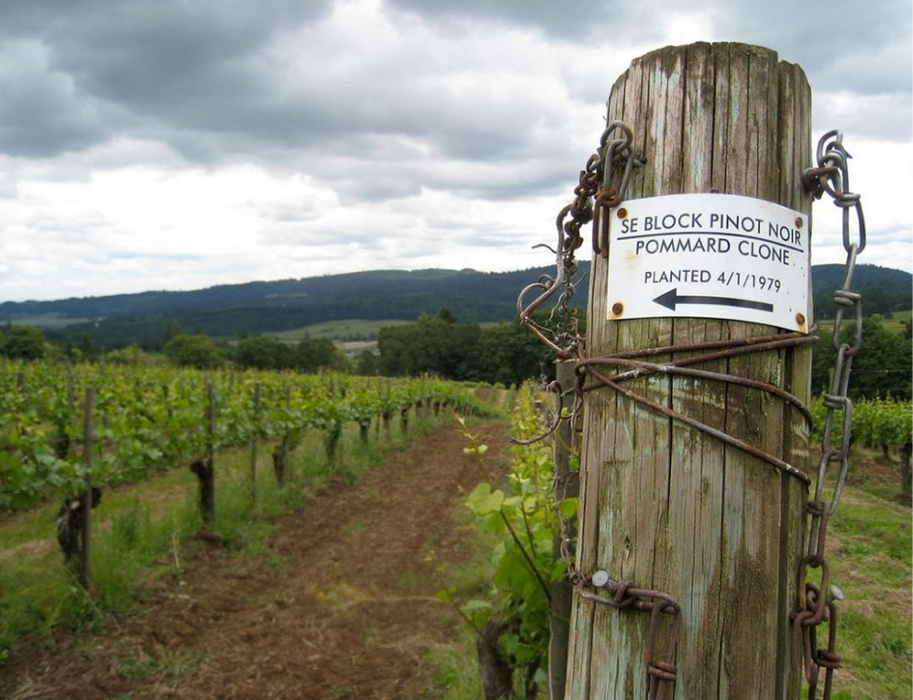
Location: Bethel Heights Road NW in Salem in the shadow of Mount Jefferson in the Eola-Amity Hills AVA. Planting: There are three old vine plantings of Pinot Noir called the Legacy Blocks: West Block in 1977, 4.5 acres; Flat Block in 1979, 3.3 acres, and Southeast Block also in 1979, 6 acres. In 2020, individual dead vines that were killed by voles or phylloxera began to be replaced with grafted vines of the same clone as the original vines. 80% of the original own-rooted Pinot Noir vines are still producing. Dijon clones 114 and 115 on grafted rootstock (1994 and 1996), 777 grafted onto old Chardonnay rootstock (2000), and 115 and 777 on grafted rootstock (2002) were added to parts of the vineyard other than the Legacy Blocks. There are currently 49.6 acres planted of which 37 acres are dedicated to Pinot Noir. Pinot Noir scions: Own-rooted Wädenswil 2A and clone 23 (West Block) and Pommard (Flat Block and Southeast Block). According to Vic, the initial Pinot Noir plantings (presumably West Block) were sourced from Wente in California. Soil: Shallow, well-drained Jory/Nekia series. Vines: South-facing hillside with a mosaic of south-facing benches and slopes at 480’-620’ elevation. Farming: The entire vineyard has been LIVE certified since 1999, one of the first Oregon wineries to receive this certification. Also, Salmon-Safe. Three years of documented organic practices were completed in anticipation of organic certification in 2021. Mimi Casteel, one of Oregon’s leading proponents of regenerative viticulture, is the vineyard manager. Winery clients: None, a monopole. Old vines bottlings: The first estate-grown commercial Pinot Noir release was from the 1984 vintage. Four block-designated estate wines from vines older than 40 years are produced each year: West Block Pinot Noir, Flat Block Pinot Noir (first bottled separately in 1991), Southeast Block Pinot Noir, and West Block Chardonnay. Ben Casteel is the winemaker. Of Interest: In a 1941 booklet by John E. Smith, the origin of the name Bethel Heights is explained. “One of the earliest settlers in this area was Rev. Glen O. Burnett who came to Oregon in 1846 and built his house half a mile or so north of the present location of Bethel School. To the heights eastward, he gave the name ‘Bethel Hills,’ Bethel being the name of the church in Missouri that he had recently served as pastor.” The property now known as Bethel Heights Vineyard was originally planted to walnut trees in 1909 and some of these original trees still flourish around the edges of the Bethel Heights vineyards The initial vines were planted by visionary Vic Winquist who established multiple Oregon vineyards including Witness Tree and Seven Springs. He saw the potential for grape growing in areas exposed to the Van Duzer Corridor. After buying the land that is now Bethel Heights, he knocked down some walnut trees that dated to 1906 and planted 20 acres of Pinot Noir, Chardonnay, Chenin Blanc, and Riesling that Vic dates to 1976. Bethel Heights was founded a year later with the first estate wines produced in 1984.
 2018 Bethel Heights Estate West Block Eola-Amity Hills Pinot Noir 13.3% alc.,pH 3.36, TA 0.64, 250 cases, $65. Ownrooted Wädenswil clone. Harvest Brix 23.2º. 100% destemmed, Aged 9 months in French oak barrels, 55% new. Bottled unfined. · Moderately dark garnet color in the glass. Lovely scent of black cherry, blackberry, spice, and a prominent floral lift. Discretely rich and robust in a mid-weight plus style featuring showy flavors of black cherry and boysenberry. Refined, with decent acidic verve and energetic tannins. The finish is exceptionally long and soulful and especially sappy when tasted the following day from a previously opened bottle. Score: 95
2018 Bethel Heights Estate Flat Block Eola-Amity Hills Pinot Noir 13.2% alc.,pH 3.60, TA 0.60, 200 cases, $65. Own-rooted Pommard clone.Harvest Brix 24.0º. 100% de-stemmed, aged 9 months in French oak barrels, 45% new. · Moderately dark garnet color in the glass. Engaging aromas of red cherry, ripe strawberry, baking spices and pastry cream. Delectable array of dark red cherry and blueberry flavors on the palate backed by notable tannins. Refined and elegant, with a compliment of spicy oak and a juicy finish of good length. Score: 94
2018 Bethel Heights Estate Southeast Block Eola-Amity Hills Pinot Noir 13.7% alc., pH 3.61, TA 0.58, 250 cases, $65. Own-rooted Pommard clone. Harvest Brix 24.0º. 100% de-stemmed, aged 9 months in French oak barrels, 35% new. Bottled unfined. · Moderately dark garnet color in the glass. The most savory of the three block wines, with aromas of underbrush, dried herbs, cherry leather, and Hoisin sauce. Mid-weight in style, with flavors of black cherry, black raspberry and boysenberry framed by muscular tannins. Like many old vine Pinot Noirs, the finish is very lengthy. This wine definitely needs a few years in the cellar to ameliorate the tannins. Score: 93
Fuqua Vineyards/Holstein Vineyard/Red Hills Estate Vineyard/ Wichmann Vineyard
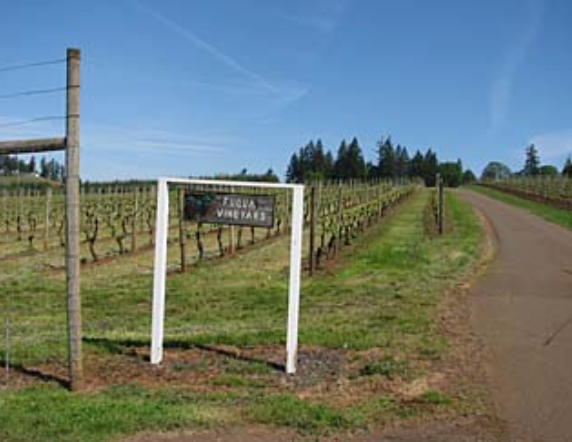
Location: Just north of Worden Hill Road Rd directly off Red Hills Rd adjacent to Archery Summit’s Red Hills Estate Vineyard to the south and Holstein Vineyard to the East in the Dundee Hills AVA. Planting: It’s complicated! From 1977-1978, 3 acres of own-rooted Wädenswil and Upright Pinot from Carl Wente’s nursery in Livermore, CA, and Riesling from Coury’s nursery were established. By 1986, the vineyard consisted of 20 acres of Pinot Noir, Chardonnay, Pinot Gris and Riesling. It was one of the first vineyards in Oregon afflicted with phylloxera. 10 planted acres were eventually sold to viticulturist Alan Holstein who still farms this plot known as Holstein Vineyard which has been completely replanted. In 1994, 25 acres were sold to Archery Summit and that became Red Hills Estate Vineyard. Archery Summit pulled out the original plantings due to phylloxera infestation and planted vines on virus-resistant rootstocks in the years to follow through 2016. Gary bought the vineyard adjacent to Fuqua Vineyard from his father, Russell, in 1998. It was a 1975 planting consisting of 4 acres of Pinot Noir (own-rooted Pommard and Dijon 115 and 777), 1.9 acres of Pinot Blanc, and 1.6 acres of Pinot Gris. This property was sold in 2010 to the Wichmanns who renamed it Wichmann Vineyard. Pinot Noir scions: Originally, own-rooted Wädenswil and Upright Pinot. Soil: Volcanic Jory.
Farming: Early on, all vineyard work was performed by Gary Fuqua and his family.
Winery clients: Yamhill Valley Vineyards, Lange, Adelsheim, Sokol Blosser, Argyle and currently Purple
Hands (Wichmann Vineyard).
Old vines bottlings: None.
Location: Philomath, OR, in the Willamette Valley AVA. A mile and a half from Tyee Wine Cellars near
Corvallis, OR.
Planting: 2.1 acres of Pinot Noir were planted from 1977-1980.
Pinot Noir scion: Own-rooted Wädenswil obtained from Myron Redford at Amity Vineyard that were propagated
on location.
Soil: Alluvial, sedimentary loam.
Vines: 8’ x 6’ spacing with sod in alternate rows. The vines are dry-farmed.
Farming: The non-sod rows get the pruned canes flailed in the spring and a cover crop is planted in the fail
after harvest. Vines are cane-pruned with a traditional VSP trellis. Leaves on the east side in the fruiting zone
are pulled in July to increase sunlight exposure, improve spray penetration, and make harvesting easier. The
vines are hedged in August to cut off lateral shoots and top the shoots above the top wire. At the same time,
the secondary crop is dropped from the fruiting zone to avoid being picked when the main crop is harvested by
had.
Winery clients: Compton Family Wines
Old vines bottling: Compton Family Wines Mary’s Peak Vineyard Willamette Valley Pinot Noir.
Of interest: Mary’s Peak, at 4,097 feet, is the highest point in Oregon’s Coast Range and the most prominent
peak to the west of Corvallis. Located in the Siuslaw National Forest, it is designated a Scenic Botanical Area.
2017 Compton Family Wines Mary's Peak Vineyard Willamette Valley Pinot Noir
14.1% alc., $34.
Released March 2021. This dry-farmed vineyard consists of 2.1 acres of own-rooted Wädenswil Pinot Noir
planted between 1977 and 1980.
·
Light garnet color in the glass. Aromas of cherry juice, balsam and earthy
flora draw you in. Graceful, silky and cohesive, offering flavors of red cherry, raspberry, and spice. This wine
has gentle power that packs more punch than the light color and demure composure would suggest. The
gossamer tannins provide enough support and the finish has persistence without weight. Inviting old vine Pinot
Noir patina.
Score: 93
2018 Compton Family Wines Mary’s Peak Vineyard Willamette Valley Pinot Noir
14.3% alc., 50 cases, $32.
·
Light
garnet color in the glass. Reaching aromas of dark red cherry
reduction, poached plum and forest timber. Light to mid-weight
in style but packed with cherry, raspberry and strawberry fruit
flavors that engage and expand on the palate. There is a subtle
underbelly of oak and dried herbs and some appealing spice
shows up on the very long finish. Silky in the mouth and grows
in appeal over time in the glass. Flat out great when tasted the
following day from a previously opened bottle. Uncompromising
and sophisticated and a steal at this price.
Score: 94
Location: Dundee Hills AVA.
Planting: Frank Goretta planted 7 acres of own-rooted vines in 1977: 1.25 acres of Pinot Noir, 3.5 acres of
Chardonnay and 2;25 acres of Pinot Gris. The original vines were cut down in the late 1990s. In the spring of 2001,
Amy and David prepared the soil for planting and noticed rows of bushes emerging where the old plantings had
been. The root structures of the vines had survived. After several vintages of careful pruning and training, the
original vineyard was brought back into production. An additional 15 acres of Pinot Noir (densely planted Dijon
115 and 777). and a small amount of Pinot Gris were added in 2001 bringing the total acreage to 22.
Pinot Noir scion: Own-rooted Pommard most likely sourced from David Lett.
Soil: Primarily Jory with a narrow strip of Nekia running through the middle of the vineyard.
Vines: The vineyard aspect is due south at an average elevation of 650’. Original vine 9’ x 4.5’ spacing with
VSP trellising.
Farming: LIVE certified and biodynamically farmed since 2019.
Winery clients: Westrey Wine Company, Winderlea, and Goodfellow.
Old vines bottlings: 2014 Westrey Cuvée 22 Dundee Hills Pinot Noir contains 3 barrels of Pommard
planted in 1977, 1 barrel of 38-year-old Coury clone, and 1 barrel of Pinot Noir planted in 1977 at Abbey Ridge
Vineyard. 2015 Westrey Cuvée 23 Dundee Hills Pinot Noir is the 23rd vintage of Willamette Valley wine
released by Westrey and is produced from old own-rooted Pommard vines. 2016, 2017, 2018 and 2019
Westrey Old Vine Cuvée Dundee Hills Pinot Noir are awaiting release. The regular Oracle Vineyard bottling
is a mix of old vine Pommard and Dijon grapes.growing.
2014 Westrey Cuvée 22 Dundee Hills Pinot Noir
13.4% alc.,
$60. Amy Wesselman’s 25th vintage. 75% old- vine Pommard
from Oracle Vineyard and 25% old-vine Coury clone from Abbey
Ridge Vineyard.
·
Moderately dark garnet color in the glass. The
nose unravels slowly to reveal aromas of red cherry,
underbrush, and baking spice. The mid-weight core of dark red
cherry, ripe strawberry, and raspberry fruits are backed by
forthright energy. The fruit gifts build in intensity over time in the
glass. Silky in texture, with moderate sandy tannins in the
background and a noticeably long finish. Impressive freshness
for an 8-year-old wine. Even more delectable when tasted the
following day from a previously opened bottle. Easily a 15-year
wine.
Score: 93
2011 Westrey Oracle Vineyard Dundee Hills Pinot Noir
13.5% alc., $30.
·
Moderate garnet color in the glass. Pleasant aromas of peppery herbs and lean cherry. Aciddriven
flavors of cherry and black raspberry satisfy but the backing tannins are outlasting the fruit and
noticeably bold. Plush in mouthfeel with sustaining fruit on the finish. Drink up.
Score: 89
2012 Westrey Oracle Vineyard Dundee Hills Pinot Noir
13.5% alc., $30.
·
Moderately dark garnet color in
the glass. Brightly scented with aromas of fresh cherry and sous-bois. Mid-weight essence of dark cherry with
good ripeness. Proportional tannins, excellent energy, and impressive length on the dry finish. Probably at its
apogee yet good for a few more years.
Score: 88
2013 Westrey Oracle Vineyard Dundee Hills Pinot Noir
13.5% alc., $30.
·
Moderately light garnet color in
the glass. Nicely scented with aromas of fresh red cherry and red rose petal. Light to mid-weight in style,
offering lean flavors of red cherry and berry with a hint of greenness. The tannin spine sticks out a bit and
some oak surfaces over time in the glass. Drink up.
Score: 88
Location: On NE Worden Road high in the Dundee Hills in the Dundee Hills AVA.
Planting: Bill Wayne had studied viticulture at UC Davis and consulted with David Lett, Dick Erath, and
Charles Coury prior to planting 2 acres in 1978 on the sunniest slope at the top of the property. He also planted
a block of Coury selection in 1980 (the Road Block) thinking it was Pommard. A second hillside was planted to
Pinot Noir and Chardonnay in 1984. A block of Pinot Noir was planted in 1990 on a hillside above the original
vines known as Arley’s Leap. Currently, there are 20 acres of Pinot Noir all of which is still productive.
Pinot Noir scions: The original 2-acre planting was own-rooted Pommard and Wädenswil. The cuttings came
from Gary Fuqua, Dick Erath and David Lett. The 1980 planting of Pinot Noir was sourced from Hyland
Vineyard thinking it was Pommard but was in fact a Coury selection. When John Paul (Cameron Winery)
started receiving Pinot Noir grapes from Abbey Ridge Vineyard, he remarked, “No way it was Pommard.”
Soil: Volcanic Jory.
Vines: High in the Dundee Hills at an elevation of 650’-800’, one of the highest vineyards in the Dundee Hills.
Southwest-facing aspect.
Farming: Organic farming practices and dry-farmed. Member of the Deep Roots Coalition.
Winery clients: The Waynes, along with winemaker Paul Cameron and his spouse Teri Wadsworth, and
Shawn Archibald and Mare Dochez, co-established Cameron Winery in the Dundee Hills in 1983. The 1984
planting of Pinot Noir forms the basis for Cameron Winery’s Dundee Hills cuvées while the old vine plantings
are the source for Cameron’s Abbey Ridge Vineyard Pinot Noir. Other clients include J.C. Somers, J.
Christopher, and Westrey Wine Co.
Old vines bottlings: Cameron Abbey Ridge Vineyard Dundee Hills Pinot Noir, Cameron Reserve
Dundee Hills Pinot Noir, J. Christopher Abbey Ridge Vineyard Dundee Hills Pinot Noir, and J.C. Somers
Abbey Ridge Vineyard Dundee Hills Pinot Noir.
2017 Cameron Abbey Ridge Vineyard Dundee Hills Pinot Noir
12.8% alc., $60.
·
Aromas of red and blue berries and
tobacco lead to a middleweight offering of red cherry, cardamom
spice, and savory herb flavors. Uplifting, glorious fruit that has
staying power through the mid-palate and very long finish.
Impeccable balance and thoroughly satisfying. Still bright and
giving when tasted two days later from a previously opened
bottle indicating long-term age ability.
Score: 94
2019 Cameron Abbey Ridge Vineyard Dundee Hills Pinot Noir
12.6% alc., $65.
·
Dark garnet color in the
glass. A complex nose offers aromas of red cherry, cranberry, white pepper, and oregano. Red cherry and
purple berry flavors have a marked savory undertone. Slightly creamy on the palate, with restrained tannins
and bright acidity. Richer and riper fruited than the low ABV would suggest.
Score: 92
2017 Cameron Reserve Dundee Hills Pinot Noir
12.6% alc., $40.
·
Moderately dark garnet color in the glass.
Intriguing aromas of dark berries, mushrooms and wet earth. The succulent black raspberry and blackberry
fruit flavors are accented with cardamom spice and oak. Mid-weight in richness with too much of an oak sheen
for my taste. Unchanged when tasted the day after opening from a re-corked bottle.
Score: 91
2018 Cameron Reserve Dundee Hills Pinot Noir
13.8% alc., $40.
·
Dark garnet color in the glass. Reserved
perfume of purple and black berries and sous-bois. The riper fruit profile reflects this warm vintage. Mid-weight
plus in style with flavors of black cherry, and purple and black berries with a savory herbal component. Silken in
the mouth with a tannic edge and a hint of oak in the background. This wine is both fruity and savory.
Score: 92
2019 Cameron Reserve Dundee Hills Pinot Noir
12.1% alc., $40.
·
Moderately dark garnet color in the glass.
A seductive nose offers scents of black cherry, dark red rose petal and toasty oak. The delightful cherry core is
graced with captivating floral and spice tastes and a bit of oak-driven vanillin and herbs. Plush in texture with a
very long and upbeat finish.
Score: 93
2019 J.C. Somers Abbey Ridge Vineyard Dundee Hills Pinot Noir
13.0% alc., $65. According to vintner J.C. Somers, “Abbey
Ridge Vineyard is the finest Pinot site in the New World.”
·
Moderate garnet color in the glass. A marriage of cherry and
toasty oak on the nose with the cherry fruit coming to the
forefront over time. Very engaging and mouth-filling in a midweight
style with a strong entry, mid-palate presence and finish
all infused with cherry goodness. There is plenty of exotic spice
as well with added flavors of crisp bacon and oak-driven
tobacco. A very Pommard-like, dancing Pinot that is gently virile.
More gregarious with loads of spice and dissipated oak when
tasted the following day from previously opened bottle. A
hauntingly beautiful wine.
Score: 96
Location: Beaverton, OR, in the Willamette Valley AVA.
Planting: 7 acres of Pinot Noir, 2 acres of Chardonnay and 1 acre of Pinot Gris were planted on the slopes of
Cooper Mountain, an extinct volcano. No interplanting or supplemental planting since the initial planting in
1978.
Soil: Saum silt loam.
Vines: Southwest-facing aspect with a 5% slope. Spacing is 6’ x 3.5’, with a VSP trellis.
Farming: Organic and Biodynamic® certified. Cooper Mountain was an early adaptor of sustainable growing
and received organic certification from Oregon Tilth in 1995. The founders are firm believers in biodynamic
farming practices and the Old Vine Vineyard was the first certified Biodynamic® vineyard in the Pacific
Northwest. Every bottle of estate wine contains only organic and biodynamic grown grapes. The trifecta here:
organic wines, organic winery and organic vineyards. Irrigation prohibited.
Winery clients: None, a monopole.
Old Vine bottlings: Cooper Mountain Mountain Terroir Old Vines Willamette Valley Pinot Noir
2017 Cooper Mountain Vineyards Mountain Terroir Old Vines Willamette Valley Pinot Noir
14.4% alc., $65.
·
Moderately dark
garnet color in the glass. Pleasant aromas of an array of wellripened,
dark fruits with a hint of tar and oak. The worthy core of
blackberry, Marionberry, cassis, pie spice and mushrooms-onthe-
grill flavors present in a fuller-bodied style. The extroverted
fruit core is tamed by ripe tannins and backed by a sidecar of
oak. More expressive and enjoyable when tasted the next day
from a previously opened bottle. Consider decanting now to tame
the tannins.
Score: 93
Location: Cornelius, OR, in the Laurelwood District AVA (a sub-AVA of the Chehalem Mountains)
Planting: Original planting was 4.2 acres of own-rooted Pommard clone Pinot Noir in 1978 remain viable
today. There have been subsequent plantings of Pinot Noir (Dijon 115), Chardonnay, Muscat, Pinot Gris, Pinot
Blanc, Riesling, and Gewürztraminer bringing the current total to 30 acres of planted vines.
Pinot Noir scion: Own-rooted Pommard clone sourced from Coury’s nursery.
Soil: Laurelwood (wind-blown silt).
Vines: The vineyard is southeast-facing at 500’ elevation with a view of five volcanoes in the Cascade
Mountains.
Farming: Sustainably farmed with organic inputs and non-irrigated.
Winery clients: This vineyard was an important contributor to the early Ponzi Reserve Pinot Noirs and has
been used as a single-vineyard bottling by a number of Oregon wineries through the years. It is now a
monopole.
Old vines bottlings: Elk Cove Vineyards Five Mountain Vineyard Chehalem Mountains Pinot Noir
includes both 1978 Pommard clone plantings and younger Dijon 115 clone grapes. Elk Cove Vineyards
Reserve Chehalem Mountains Pinot Noir has contained contributions from the winery’s estate La Boheme
and Roosevelt vineyards as well as the old vines from Five Mountain Vineyard.
2017 Elk Cove Vineyards Five Mountain Vineyard Chehalem Mountains Pinot Noir
14.0% alc., 741
cases, $60. Harvest Brix 24.0º. Aged 10 months in French oak barrels, 25% new.
·
Moderate garnet color in the
glass. The nose offers a joyous mix of cherry, licorice and sandalwood aromas. Both fruity and earthy in a midweight
plus style revealing a deep dive into ripe, dark fruits including blackberry and black current. Sleek in the
mouth, with a compliment of toasty oak and an extremely long finish.
Score: 93
2018 Elk Cove Vineyards Five Mountain Vineyard Chehalem Mountains Pinot Noir
14.0% alc., $60.
·
Dark garnet color in
the glass. Attractive aromas of black cherry reduction,
underbrush and sweet oak. This wine resembles the 2017
vintage but has more red fruit (both red and black cherry) less
oak input, more cohesiveness, and a longer, much longer finish.
The wine is nicely balanced with suave tannins, good verve, and
a gentle texture all combiner to deliver easy approachability and
a very seductive vibe.
Score: 95
14.0%
alc.. A donation to the Willamette Valley Pinot Noir Barrel
Auction #2, Lot #53, bottle 58 of 60.
·
Moderate garnet color in
the glass. Intoxicating aromas of plump cherry and sous-bois.
Exceptionally delicious, sporting well-spiced and very bright red
cherry and red raspberry fruit flavors that engage and maintain
through a very long finish that offers endless aromatic
goodness. Impeccably balanced, with gentle tannins and a silky,
caressing demeanor.Still heaven sent when tasted the following
day from a previously opened bottle. WOW!
Score: 97
Location: Dundee Hills AVA
Planting: The original 7.8 acres of own-rooted Pommard Pinot Noir were planted by Jim McDaniel in 1978.
Subsequent planting was in 1992 (own-rooted Pommard), 1994 (unspecified own-rooted clone from Erath),
1995 (Pommard on 3309 rootstock), 1998 (Pommard on 101-14 rootstock), and 1998-2010 (Pommard on
191-14 rootstock, Dijon 115). The vineyard now spans 15.28 planted acres on a 26-acre site planted to
primarily own-rooted and rooted Pommard clone with a small amount of Wädenswil clone (not specified on the
Murto Vineyard map but included in the grapes sourced by Winderlea according to owner Bill Sweat).
Pinot Noir scions: Own-rooted Pommard primarily, Wädenswil (small amount), and Dijon 115.
Soil: Volcanic Jory
Vines: The vines are planted on a southwest-facing site at 700’-800’ elevation.
Farming: The Murtos did most of the farming until the sale of the vineyard. Dry-farmed from the beginning.
Old vines bottlings: Belle Pente Vineyard & Winery Murto Vineyard Pinot Noir was produced through the
2019 vintage and was composed of 100% own-rooted Pommard clone planted in 1978. Winderlea Vineyard &
Winery Murto Vineyard Pinot Noir contains primarily own-rooted Pommard planted in 1978 and lesser
amounts of Wädenswil and Dijon 115. Winderlea offered both a de-stemmed and whole cluster version of Murto
Vineyard Pinot Noir in 2017 using the same block and selections. The new owners now keep about half of the fruit for a new winery to be named Woodshed Wine Company, a direct-to-consumer label. The remainder of the fruit is now sold to Antica Terra and Authentique
2008 Belle Pente Murto Vineyard Dundee Hills Pinot Noir
13.4% alc.. Indigenous yeast fermentation, aged
18 months in French oak barrels, and bottled unfined and unfiltered.
·
Moderately dark garnet in color with the
slightest bricking of the rim. This wine was fresh and glorious when first opened, then developed an aged
patina over time in the glass like a very well-aged grand Burgundy. Initially, the aromas of ripe cherry, spice,
arrowroot, sweet pipe smoke, and tilled earth were prevalent, becoming less fruity and more earthy in the glass
after an hour. The discretely concentrated black cherry and black raspberry fruit flavors were complimented
with anise, spice and umami. The generous and lengthy cherry-laden finish was remarkable initially. Drink up.
Score: 93
2018 Belle Pente Murto Vineyard Dundee Hills Pinot Noir
14.1% alc., $45. Indigenous yeast fermentation, aged 18
months in French oak barrels, bottled unfined and unfiltered.
·
Moderately dark garnet color in the glass. Lovely aromas of
black cherry, cardamom, and sous-bois. A deeply-flavored
black cherry core fills the mouth without overreaching. Very
spicy, with a complimentary trace of nutty oak. Thoroughly
enjoyable with supportive tannins, defining acidity and an
endless echo of cherry goodness on the finish. Even more
beguiling when tasted the following day from a previously
opened bottle, when its extroverted nose and tenacious flavor
of wild cherry sprinkled with spice and flowers revealed an old
vine masterpiece.
Score: 96
2017 Winderlea Murto Vineyard Dundee Hills Pinot Noir
13.8% alc., pH 3.36, TA 0.64, 220 cases, $60.
Grapes were 100% de-stemmed. Aged 10 months in 17% new French oak barrels.
·
Light garnet color in the
glass. Brightly perfumed with aromas of red cherry, red berry, sandalwood and rose petal. Light to mid-weight
in style with gentle power. Juicy red cherry and red raspberry flavors are complimented by crisp acidity. The
tannins are nearly invisible and the finish was extraordinarily long. The nose was still captivating when the wine
was tasted the following day from a previously opened bottle.
Score: 94
2017 Winderlea Murto Vineyard Dundee Hills Pinot Noir
13.5% alc., pH 3.56, TA 0.58, 66 cases, $70. 100% whole
cluster fermentation. Aged 10 months in neutral French oak
barrels. Same blocks, same clones, but a completely different
drinking experience.
·
The nose offers very sexy aromas of sousbois,
rose petal, wood sap, and the demure perfume of dark red
cherry and berry. My notes say “To die for!” More mouth filling
richness than the de-stemmed version of this wine and less
acid-driven with a rounder texture and evident but modest
tannins. This seems to be a slightly more serious and nuanced
wine than the de-stemmed version.
Score: 95
2018 Winderlea Murto Vineyard Dundee Hills Pinot Noir
14.0% alc., pH 3.38, TA 0.64, 245 cases, $60.
Grapes were 100% de-stemmed. Aged 10 months in French oak barrels, 3% new.
·
Moderately dark garnet
color in the glass. The nose is markedly nuanced with aromas of black cherry, dark red rose, cigar and
barnyard. More ripeness, richness and earthiness and less acid-driven than the 2017 version of this wine, and
more appealing. The core of black cherry and boysenberry fruit has an inviting earthy underpinning so
desirable in Pinot Noir. The tannic spine is gentle and the finish is very long and succulent. Still exceptional two
days later from a previously opened bottle when the extravagant nose carried on. The 2018 vintage seems
more age worthy than the 2017 vintage version of this wine.
Score: 96
2018 Winderlea Murto Vineyard Dundee Hills Pinot Noir
13.5% alc., pH 3.54, TA 0.59, 91 cases, $70.
100% whole cluster fermentation. Aged 10 months in neutral French oak barrels.
·
Moderately dark garnet color
in the glass. Earth and barnyard aromas are combined with blackberry and old barrel aromas. Mid-weight plus
in richness, showing weighty black cherry and blackberry sap framed by muscular tannins. Somewhat brooding
at this stage as often expected early from whole cluster fermented Pinot Noirs and will benefit from more time
in the cellar. Re-tasted the following day and two days later from a previously opened bottle and the wine was
more giving yet still a bit husky and reserved.
Score: 94
Location: The Dundee Hills near Domaine Drouhin, Archery Summit and Domaine Serene in the Dundee Hills
AVA.
Planting: Initial planting of the 10-acre vineyard was between 1978 and 1982.
Pinot Noir scion: Own-rooted Pommard clone.
Soil: Volcanic Jory.
Vines: East-southeast-facing slopes at 879’ elevation. Spacing was 10’ x 7’ but there have been interplanting
beginning in 2014 with cuttings from the original vines grafted onto rootstock 3309 (see photo). The advantage
of the 10’ row spacing is that the vines do not shade each other allowing for a taller canopy. The goal is to
make the vines stress themselves to reach deeper into the soil to generate enough nutrients to support the
taller vines, eventually getting a bigger canopy to absorb more energy from the sun.
Farming: Conventional.
Winery clients: Torii Mor (2017).
Old vines bottling: White Rose Estate White Rose Vineyard Dundee Hills Pinot Noir.
Of Interest: The first vintage from White Rose Estate was 2001. The winery was the PinotFile 2014 “Winery
of the Year.”
2018 White Rose Estate White Rose Vineyard Dundee Hills Pinot Noir
12.9% alc., pH 3.69, 350 cases, $125. 100%
whole cluster fermentation. Aged 12 months in French oak
barrels, 10% new.
·
A terrific whole cluster-inspired nose offers
soaring aromas of exotic spice, cherry, burnt tobacco, and
sweet pipe smoke. Gorgeous in the mouth, with a prominent
whole cluster spice character. Mid-weight flavors of red cherry
and ripe strawberry clothed in gracious tannins. Over time in
the glass the whole cluster character becomes more
integrated and the wine reaches new heights of enjoyment. I
like this wine for its uniqueness among Oregon Pinot Noirs,
offering a singular style that I can really embrace.
Score: 97
Other Willamette Valley Vineyards Planted in the 1970s
Catalyst Vineyard Planted in 1978 with 1 acre of Pinot Noir, 1.5 acres of Riesling and 0.5 acres of Chardonnay. Owned by Varnum Vintners. Champoeg Vineyard The Mathiot family, French immigrants, planted grapevines here in 1958 using plants obtained from California after claiming 139 acres of land encompassing a portion of “La Butte” located in Butteville, OR (Marion County). By 1980, the farm census referred to Butteville and the neighboring community as the wine capital of Oregon territory. Champoeg Wine Cellars was established in 1990 and opened to the public in 1992. Chateau Benoit Vineyard This property, now known as Anne Amie Vineyards since 2004, was planted in 1979 by Fred and Mary Benoit who bought 60 acres in Carlton, OR in 1979. Anne Amie produces an Old Vine Estate Müller Thurgau from grapes planted in 1979 but no Pinot Noir is crafted from the 1979 plantings of Pinot Noir. Ellendale Vineyards Robert and Ella Mae Hudson planted a 15-acre vineyard in 1976 named after the town of Ellendale located 12 miles west of Salem. Reportedly, 27 varieties of wine grapes and berries were established. Wine was produced and sold until the early 1980s when Ken and Becky Jacroux became owners and managers of the property. The 16-acre vineyard contained own-rooted Pinot Noir, Pinot Gris, Riesling, Gewürztraminer, and Niagara. The property is now named Breckenridge Vineyard. Holley Blue Vineyard No record of who planted the vineyard originally in 1972. Located in the southern Willamette Valley near Corvallis, OR. At one time, the vineyard was owned by Jack Brandis, Owen Bentley, and Lee Tyler. 10 acres of Pinot Noir, 3 acres of Riesling and a small amount of Gewürztraminer. The vineyard’s current status is unknown. Hollie Blue Vineyard Wines, including Pinot Noir and a sparkling Rosé, were made at various times by Secret House, LaVelle, and King Estate. Holstein Vineyard Alan Holstein was the manager for Weber Vineyard and was given a 10-acre portion of the vineyard. The entire vineyard was replanted due to phylloxera. Alan’s son, Jackson, now manages the Holstein Vineyard and has produced wine under the Granville label since 2014. Mulhausen Vineyards Zane and Pat Mulhausen planted a 30-acre vineyard in the Chehalem Mountains beginning in 1973. The plantings were Pinot Noir, Riesling, Chardonnay and Sylvaner. The Chehalem Mountain Winery was bonded in 1979 and the name later changed to Mulhausen Vineyards. In the early 1980s, a Pinot Noir was released. The vineyard and winery were sold in the late 1980s to Ponzi Vineyards. Zane Mulhausen was a plant engineer at Tektronix where Dick Erath also worked back in the day. Strangeland Estate Vineyard Larry and Ruth Miller planted this vineyard in 1978 in Salem, OR. The original plantings included Wädenswil Pinot Noir and Chardonnay. Pinot Gris was added in 1988. The Strangeland Vineyards & Winery was established in 1991. The winery’s Reserve Pinot Noir is sourced from a mix of vineyards with no Old Vine bottling. Wichmann Vineyard Gary Fuqua’s father, Russell, planted a vineyard with 4 acres of Pinot Noir in 1975 along with Gary Fuqua located adjacent to Fuqua Vineyard. Gary bought the vineyard property from his father in 1998. In 2010, the Wichmanns purchased the vineyard and renamed it Wichmann Vineyard. (see Fuqua Vineyard) More:Feitz Vineyard (1973), Hidden Springs (1979), Jonicolle Vineyards (1975), Nehalem Bay Vineyard (1973).
Four Special Willamette Valley Vineyards Established from 1981-1983
Courting Hill VineyardOwners: This approximately 40-acre property was acquired in 1977 by Jimmy and Helen Leyden who were assisted by Richard Sommer and Dick Erath. Jimmy passed away in May 2021. The third generation has taken over the management of the vineyard. Location: Overlooking the Tualatin Valley with a view of Mt. Hood on NW Courting Hill Dr in the town of Banks, OR. Planting: 21.52 acres were established over the years 1981-1983 including own-rooted Pommard Pinot Noir, own-rooted Upright Pinot, Chardonnay (Dijon 76 and 96), and own-rooted Pinot Gris, Currently, the vineyard consists of 43 planted acres. Pinot Noir scions: Own-rooted Pommard and an Upright Pinot selection. In 2000, the Jackson clone was planted which is a rarity in Oregon. Dijon clones 113, 114 and 115 were added in later years. Soils: Wind-blown Loess. Vines: South-facing at 400’-450’ elevation.. The original spacing was 9’ x 9’ but subsequent plantings were much denser. Winery clients: Primarily R. Stuart & Co Winery since 2001 including a Blanc de Blanc sparkling wine from Chardonnay grapes. Rob Stuart worked with grapes from this vineyard while a winemaker at Erath Vineyards in 1994. Grapes have been sold by “u-pick-em” to amateur winemakers since 1986.
Of interest: Jimmy Leyden’s granddaughter writes, “After my grandparents acquired their property, a local
building contractor who was bidding on a new home construction at the site, said, ‘ You folks are building on my
old courtin’ hill.’ Back in the olden days courting couples would come up this hill for the beautiful view and a
little ‘privacy.’” Jimmy Leyden was a colorful character whose background included music teacher, musical
arranger for the Glenn Miller Orchestra, marine flight instructor, and jingle master (wrote short jingles for
television advertisers).
Location: In the foothills of the Oregon Coast mountain range about 5 miles northwest of the small town of
Monmouth and just south of Dallas in an area mostly planted to prunes when the vineyard was established.
Technically located in the Eola Hills but lies just outside the southwestern border of the Eola-Amity Hills AVA but
in the Mt. Pisgau of Polk County AVA.
Planting: The vineyard was established in 1981 and the Initial plantings of 13 acres of own-rooted Pinot Noir
were in 1982. Most of the first harvest in 1985 went to Amity Vineyards. Beginning in 1995, the phylloxera-
infected vines were replaced with grafted rootstock. The vineyard now consists of 92 planted acres of which
76% is Pinot Noir, 16% is Chardonnay and the remainder is Pinot Blanc and Tempranillo.
Soil: Marine sedimentary (Bellpine).
Farming: Don and Helen’s son, Dustin, took over farming responsibility in 2015 and transitioned the vineyard
to organic farming.
Winery clients: Devona, Evesham Wood, Ken Wright Cellars, Kelley Fox Wines, Lange Winery, Mark Ryan
Winery, Purple Hands Wine, Silvan Ridge, St. Innocent, Walter Scott, and Patricia Green Cellars (9 acres
sourced planted to Pommard, Dijon 115 (2004) and Coury clone (2000).
Old Vine bottlings: None. The Patricia Green Cellars Perspicacious Cuvée Freedom Hill Vineyard Pinot
Noir is not an “old vine” bottling per the definition in this article but is a special wine worth pointing out.
2019 Patricia Green Cellars Perspicacious Cuvée Freedom Hill Vineyard Willamette Valley Pinot Noir
13.3% alc., $150.
One fermenter of Dijon 115 from the Heritage Block. First effort
for this wine. 100% whole cluster fermentation. Aged in 25%
new French oak barrels.
·
Dark garnet color in the glass. Waves
of ripe fruit perfume including black cherry and blackberry along
with woodsy spice and floral lift. Richly fruited in a mid-weight
style sporting flavors of black plum, boysenberry and blackberry
with a rare beef, umami tone. There is quenching acidity and
wholesome tannins, and a very long finish with trailing tannins.
The whole cluster blends seamlessly into this wine. Spectacular
when tasted the following day from a previously opened bottle.
An excellent reflection of the terroir of Freedom Hill Vineyard
based on my experience in tasting many wines from this
vineyard.
Score: 96
Location: 15 miles north of West Salem in the Eola-Amity Hills AVA.
Planting: The original Pinot Noir plantings, established between 1981 and 1983, are in three blocks: Front
Block, The Flats Block, and The West Field Block. West Field is planted to own-rooted Wädenswil and the
other two blocks are own-rooted Pommard. All of these plantings are suffering from grapevine trunk disease
(ESCA) and phylloxera and both replanting and interplanting of grafted vines were performed in the 1990s and
early 2000s. About 20 acres or roughly 40% of the original own-rooted Pinot Noir vines are still producing.
Dijon clones 113, 114, 115, 667, 777 and 943 and the Swan clone have been added so that currently there are
80 acres of Pinot Noir and 20 acres of Chardonnay, Pinot Gris, and Aligote. The original plantings of
Gewüztraminer have been replaced.
Pinot Noir scions: Own-rooted Wädenswil and Pommard.
Soil: Nekia, Rittner and Jory. The site is believed to be the remnants of an ancient volcano.
Vines: The original Pinot Noir vines have 12’ x 8’ spacing on a high wire hanging trellis. Grafted vines have been
added at 4’ in-between. The 1990s plantings that are mostly grafted are on 10’ x 5’ spacing on upright vertical
trellis. Replanting that began in 2000 is all 8’ x 4.6’ and 4’ in-row vine spacing, 1550 vines per acre, with a
single arm Guyot upright vertical trellis. The vineyard is planted on many different slopes of varying exposures,
overlooking the Van Duzer Corridor at 660’-860’ elevation.
Farming: Certified Salmon-Safe and certified organic. The vineyard has been managed by Dai Crisp, who has
farmed organically for 35 years, since 1999. The vineyard is dry-farmed.
Winery clients: Bergström, Brooks, Division, Elizabeth Chambers, Evesham Wood, Goodfellow, King Estate,
Lavinea, Love & Squalor, LUMOS, Pike Road, St. Innocent, Vincent, and Walter Scott.
Old Vine bottlings: There is some old vine block fruit in the LUMOS Rosé. The oldest plantings are coveted
by long-term contract holders but I know of no winery client that produces a Temperance Hill Vineyard Pinot
Noir that only includes fruit from the original plantings. I have included a review here of a stellar 2019
Goodfellow Temperance Hill Pinot Noir sourced from 1994 plantings known as the Pumphouse Block.
Of interest: The name of the vineyard came from the horse with the same name that won the 1980 Belmont
Stakes where he defeated Kentucky Derby winner Genuine Risk and Preakness Stakes winner Codex at odds
of 53-1.
2019 Goodfellow Pumphouse Block Temperance Hill Vineyard Eola-Amity Hills Pinot Noir
12.7% alc., 100 cases, $52.
·
Moderately light garnet color in
the glass. A complex woodsy perfume with aromas of tilled earth, Herbs de
Provence, cherry and rose petal. Striking purity of well-spiced black cherry fruit
in a mid-weight style with exquisite balance predicting age ability. The added
flavors of spice and peppercorns embellish the experience. A giving wine initially,
but improves in the glass over time. A complete wine with an exceptionally long
and uncommonly gratifying aromatic finish.
Score: 96
Owners: Al MacDonald and Joni Weatherspoon founded this vineyard over the years 1982-1984 (all three
years have been cited as the initial plantings). For a brief period following the divorce of the vineyard’s
founders, the Seven Springs Vineyard was cleaved in two. Joni retained the vineyard’s upper half and the
name Seven Springs, while Al christened his lower half “Anden,” a linkage of their children’s names Andrew
and Kristen. The entire vineyard was reunited as Seven Springs Vineyard when Evening Land Vineyards
obtained an exclusive lease for the property in 2007 and became the sole producer of Pinot Noir, Gamay Noir,
and Chardonnay from this vineyard.
Location: On the eastern side of the Eola Hills range in the Eola-Amity Hills AVA, 10 miles north of Salem. The picturesque site is nestled against a forest of Douglas fir with views eastward toward Mt. Hood.
Planting: The oldest, own-rooted Pommard vines were planted in 1982 although 1984 has also been cited
and became the backbone of the winery’s Seven Springs Estate Pinot Noir bottling labeled “Anden.” This block
was pulled out after the 2017 vintage due to phylloxera. The vineyard had been devastated by phylloxera and
the Evening Land owners began revitalizing and replanting of the vineyard in 2007. The plantings of Pinot
Noir since 1984 were as best as I can determine as follows: own-rooted Pommard in 1988, Pommard and
Dijon 115 both on 3309 rootstocks in 1996, Clos de la Foret Block of Dijon 777 and Pommard on 3309 rootstocks
in 2002, East Ridge Block B was planted by Dominque Lafon of Comte Lafon in Burgundy that is a unique mixture
of many variations of the Dijon clone intermixed (selection massale) to mimic the diversity found in Burgundy in
2007, and Dijon on Riparia rootstock mix and Wädenswil in 2008. There is a 3-acre block of Gamay Noir
(Upright Pinot) that dates to the original plantings and is among the oldest Upright Pinot vines in North
America. The vineyard is also well-known for Chardonnay including wines from the 1995 plantings of Dijon
clone 76 Chardonnay.
Original Pinot Noir scions: Own-rooted Pommard and Wädenswil clones.
Soils: Volcanic Jory and Nekia.
Vines: East-facing moderate slope at 350’-650’ elevation.
Winery clients: In the early years, the fruit was shared among some of the best wineries in the Willamette
Valley. More recently, the clients have been limited including Failla Wines, Lingua Franca, and Walter Scott
Wines (from selection massale plantings of Dijon clones).
Old Vine bottlings: Evening Land Anden Seven Springs Vineyard Eola-Amity Hills Pinot Noir (last
vintage 2017). Evening Land Seven Springs Vineyard Eola-Amity Hills Gamay.
2017 Evening Land Anden Seven Springs Vineyard Eola- Amity Hills Pinot Noir
13.0% alc., 159 cases, $100. This wine
celebrates the history of Seven Springs Vineyard’s original 1984
plantings of own-rooted Pommard and Wädenswil clones. 100%
whole cluster, indigenous fermentation in open-top concrete
fermenter. Aged 16 months in neutral Ermitage oak barrels.
·
A
fitting sign-off for a wine composed of fruit from 33-year-old
vines. Moderately light garnet color in the glass. Welcoming
aromas of black cherry, red rose petal, pine sap and beguiling
spice. Crisp, clean and sleek, featuring a mid-weight core of
luscious dark cherry fruit subtlety spiced and revealing
understated power. The wine brings a harmonious composure
tendered by gossamer tannins and good verve, with a lengthy,
cherry-infused finish that urges another sip.
Score: 94
1981 - Resonance Vineyard (20 acres, massale selection, Pommard and Wädenswil, and 777)
1982 - Broadley Vineyards, Cristom Marjorie Vineyard, Rex Hill, Ridgecrest Vineyard, Van Duzer Estate
(1982-1984), Witness Tree (Lower Vineyard has 30 acres of own-rooted Pommard clone).
1983 - Caldwell Hill, Canary Hill (owned by Ken Wright, Pommard clone), Elton Vineyard, Leland Vineyard (A 5-acre own-rooted vineyard near Canby tended by Bruce and Virginia Weber since inception. Early on, the fruit went to Dick Erath and more recently to Erath/Ste. Michelle). (Prince Hill Vineyard,
Yamhill Valley Vineyards (second oldest vineyard in the McMinnville AVA)
1984 - Clos Electrique (estate vineyard of Cameron Winery with multiple clones of own-rooted Pinot Noir)
Notable Old Vine Wine Quotes
“Older vines equal a better perspective on how to farm and make wine….The true genius of working with an older block of grapes is that there is rich, historical winegrowing knowledge about the site, and that can translate into better quality wine." Alex Sokol Blosser, Sokol Blosser Winery “The longer I make wine, the higher value I place on vine age. Whether close or widely spaced, despite the clone in most cases, regardless of trellis in most cases, we see complexity and depth from vine age that cannot be duplicated in young vineyards."Ken Wright, Ken Wright Cellars “For me, a vine seems to enter its prime around twenty-five to thirty years of age. Young vines can certainly express terroir, but the expression is perhaps not as strong, not as consistent, and usually, there is something that falls a little short on the texture front." Jeremy Seyses, Domaine Dujac “Old vine wines are a history lesson in a glass.” Cassandra Felix, Brendel Wines “Heritage old vines crack open the cultural, agricultural and human heart of wine, connecting the humanity, nature and qualities of a wine effortlessly with what is in the glass.” Sarah Abbott MW “If old vineyards did not produce great wines, they would have been replaced long ago.” Bruce Tyrrell, Tyrrell’s Wines of Australia “Old vines know better. There’s something special about them that winemakers love. They tend to self-regulate.” Eric Lavmann, Cambiata Winery “The grapes of old vines are deeper and higher quality. More intense and persistent both in smell and mouth.” Massimilino Calabretta, Calabretta Winery “For whatever reason, wines made from old vines often tend to be complete on their own, well-balanced and satisfying. That said, I don’t believe that a vine needs to be old to make a compelling wine.” Eva Dehlinger, Dehlinger Winery “What is special to me about the old vine wines is broader than just the wine in the glass. It is the context and history of the old vines that are so important. I’m moved just thinking about all the seasons that the vines have lived through, all the people who have cared for them, and all the vintages they have offered us fruit.” Eva Dehlinger, Dehlinger Winery “Older vines have larger carbohydrate reserves in the trunk and root system that ensure a better start to the growing season. Older vines also have a better natural balance with modest vigor in the canopy and modest crop levels.” Jamie Goode, wine journalist “For those vines that still produce high-quality fruit, the results can reveal something magical. I truly do think that these old vines make a really special, complex wine.” Mellisa Burr, Stoller Estate “Old vines are rightly prized. But ultimately, once a vine has passed its vigorous youth and has established a decent root system, the main factor is place. Some terroirs are simply better than others.” Jamie Goode “If you have a choice between an old vine Pinot Noir and a young vine Pinot Noir, chose the young vine if you want exuberant fruit prowess, but chose the old vine if you want a more educated wine with nuance, discrete fruit richness, a polished texture, savoriness, and a long finish.” Rusty Gaffney, the PinotFile
Epilogue: Pommard in Guise
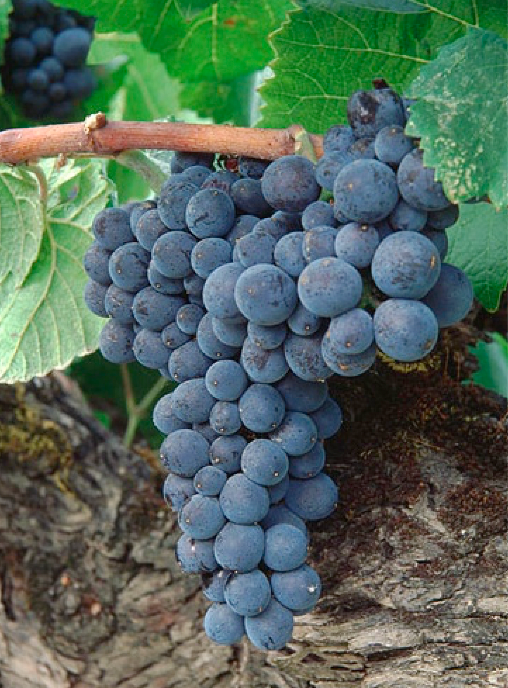
Pommard 04 or UCD 4 originated directly from a producing European vineyard. It was registered from 1963 to 1980 (and widely planted in California) but then removed because it tested positive for Rupestris Stem Pitting (RSP+). Pommard 05 or UCD 5 and Pommard 06 or UCD 6 are distinct clones that were created from Pommard 04 in 1964 and heat-treated for a different amount of time according to David. They were grouped together and sold as "Superclone 103" under the designation FPMS 103 for puzzling reasons. They were both registered from 1967 until 1980 when they were removed from the FPMS catalog because they also tested RSP+. UCD 4, 5 and 6 are no longer registered and FPMS 91 was created from Pommard 04 by micro shoot tip culture and registered as the new Pommard selection in 2002. David relates his experience as follows. "Back on December 15, 1973, we ordered 4,700 Pinot Noir plants, all clone 103, for planting in 1974. But as April 1974 arrived, Chuck did not have enough of those plants for our planting party planned for April 30. So, to get us off his back, he gave us 1,000 (actually 967) plants from hardwood cuttings from Eagle Crest Vineyards, and the next day, we picked up 1,323 plants grown from greenwood cuttings at Charles Coury Nursery to plant Block 1 in what is now named the Quarter Mile Lane Vineyard. The "PN BR" on the delivery tag for the 1,000 plants means "Pinot noir, bare root." There was no mention of 'Clone 103' but that designation was there for later plant pickups in June and July. David was told by Chuck's son, Charley Coury, during his interview with him in October 20020 that Chuck promised to deliver in the spring of 1974 huge quantities of Pinot Noir plants to Eagle Crest Vineyards, an investment property in the Eola Hills northwest of Salem. He could not deliver what he had promised, so the owners sued him and won. Chuck ended up having to find partners and eventually had to sell his winery five years later. Some of the material Coury was growing for us was very weak (35% of those greenwood-cutting plants died). The origin of the Eagle Crest/Coury propagated material was Clemente-Nyland Growers who specialized in heat-treated material. So, that would seem to limit the origin of the material to the Pommard or Martini clones. When I asked the owner of Clemente-Nyland Growers what clone he had sent to Coury, he replied, 'Clone? No, we sent him Pinot Noir cuttings.' This explains why we had no certification tags. If they were cuttings from heat-treated vines (which Coury would have favored), they would have had to have been either Pommard clones 5 or 6 (or 103) or Martini clones 13 or 15 or a mixture. Those were the only heat-treated Pinot Noir clones at FPMS at that time. On April 20, 1974, we planted 1,740 plants in Block 1. Many of of the plantings died, primarily the clone 103 from greenwood cuttings. They would have been replaced with certified clone 103 plants. It is my guess that at least 46% of Block 1 (798 plants) is likely UCD 6 Pinot Noir. The other 54% - who knows? They could be Martini, or a mix of Martini and Pommard. The wine does not taste like Pommard so it is doubtful that it is all Pommard. Or they could be other clones from Davis or Pinot Noir selections that Clemente-Nyland Growers had hanging around. Or they could have been hardwood cuttings that Coury had lying around including the so-called Coury clone.” There was an early heat-treated version of Wädenswil, UCD 2A that was designated “Blue Burgundy” or UCD 30 in the FPMS list of scion material. I have read that Dick Erath may have brought that clone to Oregon and propagated vines of UCD 30 for himself and others but Dick told me he was unaware of UCD 30 and never distributed it in Oregon. It is unlikely that there were some vines of UCD 30 in the April 20, 1974 planting of Block 1 as Coury would not have had access to it. UCD 30 was never widely propagated in California or Oregon and is no longer listed in the FPMS catalog. There are currently two methods for identifying a cultivar at the clone level: ampelography (a visual inspection of the growing shoot tip and young leaf in the spring, the mature leaf from flowering onwards, and the cluster morphology and berry from veraison onwards), and DNA testing (advantageous over ampelography because it is not subject to morphological variability due to site, climate, vintage and other variables). Unfortunately, DNA testing remains expensive and its limited usage in Oregon to date has not revealed definitive results. In summary, what is planted at Quarter Mile Vineyard Block 1 was not solely “Pommard clone” as David envisioned and cannot be called a clone since there is no assurance of its singular origin so it should be called a “selection,” and designated QM1 selection. |
